


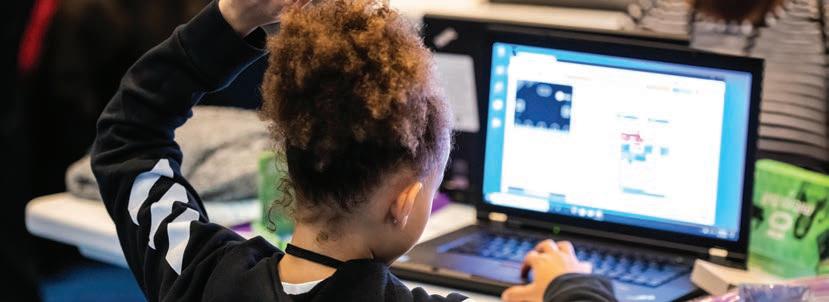
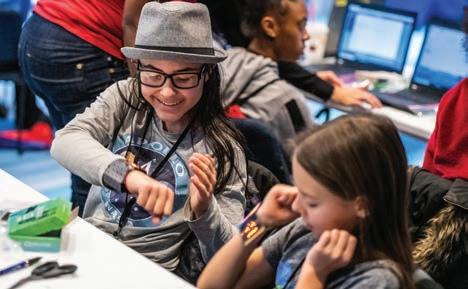






Our Vision at Park Bank is to live in a community that embraces diversity, equity, and inclusion. Wherever you are now, and wherever you want to go, everyone has a right to find their next. We are privileged to work with local nonprofits to help make a difference right here in Dane County. Because by giving back, we all move forward.
Meet Park Bank Community Partner, MAYDM, a nonprofit organization right here in Madison dedicated to providing girls and youth of color in grades 6-12 with skill-based training for the technology sector. Together we are focused on creating a community where everyone has opportunities to achieve.
We can’t imagine a more exciting way to reunite with you, John DeMain, and our musicians for a true expression of joy when we come together for a thrilling return to live classical music in Overture Hall. Experience Beethoven’s Ninth Symphony, one of the most iconic masterpieces of all time that celebrates the freedom and triumph of the human spirit over adversity — bringing to life its “Ode to Joy”
— with more meaning now than ever before. We open this special program honoring the brilliant tenure of our principal oboist Marc Fink with the Oboe Concerto by Mozart, who was Beethoven’s compositional inspiration.
We invite you to join us for one of the three performances — welcoming you back to the joy of live music.
SEP
24, 25 & 26
FRI 7:30 PM
SAT 8:00 PM
SUN 6:30 PM*
*Note that the Sunday performance takes place at a later time than usual, to accommodate Art Fair on the Square that will conclude at 5:00 p.m.

TICKETS ARE ONLY $15, $30, $60 OR $90!
Single tickets on sale now — only available through the Overture Center Box Office. Visit overture.org to buy tickets online, and view Box Office hours for phone or in-person orders. 21/22 Symphony season subscribers can purchase single tickets for this concert at 50% off.
Mozart , Oboe Concerto in C major Beethoven , Symphony No. 9 in D minor
John DeMain , Conductor
Marc Fink , Oboe
Madison Symphony Chorus , Beverly Taylor, Director
Laquita Mitchell , Soprano
Kristen Larson , Mezzo-Soprano
Edward Graves , Tenor

Matt Boehler , Bass
MAJOR SPONSORS
BMO Harris Bank
Ernest and Louise Borden
Madison Symphony Orchestra League
David and Kato Perlman
ADDITIONAL SPONSORS
Martha and Charles Casey
Gale Meyer and Barbara Melchert
Wisconsin Arts Board
DISCOVER MORE
PLEASE TAKE NOTE
We guarantee a refund for tickets to any concert that cannot be performed for any reason. We will adhere to all public health guidelines and cooperate with Overture Center for the Arts to assure your safety (requirements will include proof of COVID-19 vaccination and wearing masks). Programs, dates, and artists subject to change.

madison symphony .org/ joy






21 22 SEASON

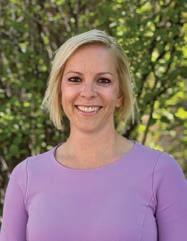
The loss of a child isn’t often talked about and is the hardest thing a parent can go through. Area women share their own stories of loss and how they’ve been able to honor their child’s memory.

Eight women share their tips for career fulfillment and what’s worked for them.


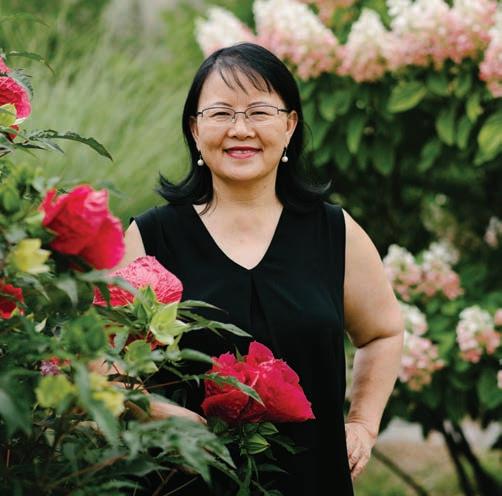

By Joanna G. Burish
Ihear people say, “Oh, I wish I had that person’s life” or, “I wish I had that person’s body,” — or whatever it is they believe they lack. By watching their actions though, it’s usually telling why they aren’t where they want to be. Let’s be honest: If you want to learn to ride a bike, it’s a good idea to start by watching others, or looking up how to do it on YouTube. But ultimately, you will need to get on the bike and try it out for yourself. It’s usually helpful to have someone there with you, to show you how and cheer you along the way. This works well for any new skill you’d like to learn — biking, swimming, rock climbing — whatever excites you! And we all accept that it is OK to hire a coach or trainer to help you get there.
Why then, do we believe that talking about money, or asking for help organizing our finances, is so taboo? This has become my life’s mission in my work, to help people shed this taboo and take more agency in their financial future. Growing up, my family didn’t have discussions around money or financial planning. (My parents are my heroes, and I reflect on how they raised four children as immigrants from Nazareth, Israel, and am in awe of their perseverance!) What my mom did tell me was to “have your own money,” and this stuck with me. What took me much longer to learn and fully understand was what to do with my money and how to plan for my future. Let me share a few lessons with you that can empower your plan with Braud Power!

Contact Joanna Burish directly at 608-658-3482 or Joanna.burish@nm.com
joannaburish.nm.com/areas-of-expertise.htm linkedin.com/in/joannaburish
The Brauds Network – Founder, Coach, COI thebrauds.com
1. Understand your needs from your wants. Evaluate your expenses and live within your means. This is my No. 1 piece of advice to start with!
2. Structure an automatic savings plan so you don’t have to think about it each month. Ask me how to set up a process which allows you to do this. One idea is to automatically divert part of your paycheck into your savings, retirement or investment accounts so you won’t see the money hit your checking account (thus avoiding spending temptation!). This makes saving seamless.
3. Control your impulse spending. This is where knowing your relationship with money is key. We all have various saboteurs that sneak into our thought process to tell us to one degree or another that we are not “enough.“
4. Invest in your future and create a holistic “lifecycle” financial plan. Some people only live for today. Those that do may need to work much later in life as a result. Be certain to set yourself and your family up for success by planning to live well in all stages of your life.
5. Protect you and your family’s lifestyle. I know — you’re young and invincible, right? Remember: No one gets to choose or select if they are disabled or not able to work for an extended period of time. Or worse, are in a fatal accident. Both of these life events are the No. 1 reason families go into debt or bankruptcy. (Next in line is divorce, and I don’t believe people walk into marriage thinking it may not last.) But if you plan for these risks, you’ll be taking action to protect yourself and your loved ones.
6. Understand your net worth and your credit score. Your credit score is the key to many optimal financial opportunities, so make sure you keep tabs on it. Learn the difference and set a plan with your advisor on how to prioritize eliminating bad debt. There are many ways to keep on top of this!
7. You can build a fun money bucket and not feel guilty for spending it! Yes, go ahead and enjoy life because you work hard. Planning activities to relax and recharge are important to your holistic financial success. There are various ways, from the envelope system to apps, that can help you. Be proactive here, and you’ll find it can actually be fun!
If you’d like help in any or all of these areas, feel free to connect with my team and me. We’re here to help mentor, coach or train you to Braud Power your holistic, financial future!
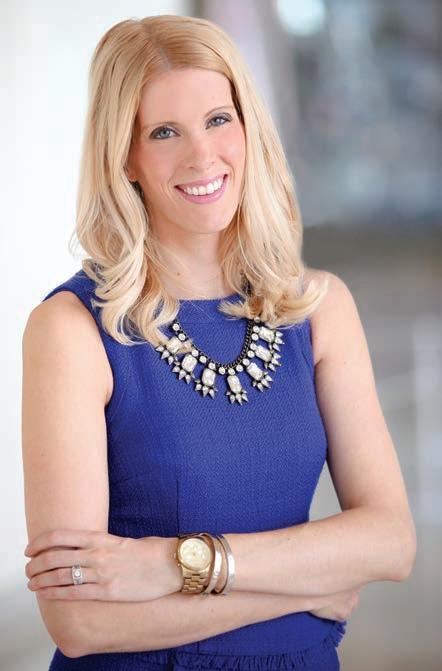
When I told family and friends that I was writing a feature on the topic of infant and child loss for BRAVA, all of them admitted they would have a hard time working on a story like that. And, I have to acknowledge, writing about this topic wasn’t a walk in the park. But it’s nothing compared to what women who have lost a child have to endure.
October is National Pregnancy and Infant Loss Awareness Month, and I wrote this piece in honor of my friends that have experienced the most heartwrenching loss a parent can face. Some had miscarriages, others birthed stillborn babies, and another mourns the passing of her four-month-old baby boy.
If you have a friend or a loved one that’s experienced the death of a child, I offer a few pieces of advice that were shared with me during my conversations for this story. Talking about death is awkward and uncomfortable — there’s no way around it. But all of the women I interviewed said that simply being present for a loved one, whether it’s listening, texting “Hey, I thought of you today,” dropping off a meal or even acknowledging that you don’t know what to say but are here for them, is the best thing to do. Not addressing the loss of their child or avoiding a loved one after a loss (even if it’s because you don’t know what to say) is hurtful.
And it’s true that all parents like talking about their kids, so mentioning that you thought of their child that day or sharing a memory of them, even if it’s out of the blue, is always welcome,
and appreciated. Read more about the experiences of four women who have lost their children and how they have found hope afterward, on P. 62.
Speaking of strong women, our Secrets of Success feature starting on P. 40 highlights eight area women that have cracked the code for career fulfillment. We asked women like Jeannie Cullen Schultz how she’s made her way in the male-dominated industry of construction management and our cover woman, Tu Le, how she’s been able to find work-life balance while also being a busy mom to four children. Their insights are all helpful, and they offer takeaways that you can use in your own career.
This issue also has a strong focus on women’s health, which is so important to us here at BRAVA. Read about health screenings you should keep on top of (P. 16), dealing with the after-effects of cancer told from a breast cancer survivor’s perspective (P. 20) and four things to know about gut health (P. 23). There’s a lot more health content besides this scattered throughout this issue that you’ll want to check out too! As we kick off the school year, I wish you and your families much success for our in-person school year (after the craziness of the last two school years!) and that you stay healthy and happy.

Shayna Mace Editorial Director @shaynamace
CHECK OUT OUR EMPOWER LUNCH HOUR!
On Oct. 7 from noon-1 p.m., check out this free, virtual event sponsored by Summit Credit Union. This dynamic discussion, featuring Summit and NAMI Dane County, will talk about what it means to be financially well. Register at bravamagazine.com.

FALL FOR STYLE
The change in seasons means pulling out our fall closet staples. Check out “One Piece, Two Ways” on P. 9 for how you can style some wardrobe essentials multiple ways. I’m loving this leopard blouse!

SEEKING NOTABLE WOMEN
Do you know a Woman to Watch? We want to hear about her! Nominate a Dane County area woman who has big plans for 2022. Honorees will be featured in our January/February 2022 issue. Nominate them at bravamagazine.com/w2w.
BUSINESS
PUBLISHER
Barbara Krause bak@ntmediagroup.com
VICE PRESIDENT OF PUBLICATIONS
Becky Peck bpeck@ntmediagroup.com
EDITORIAL
EDITORIAL DIRECTOR
Shayna Mace shayna@bravamagazine.com
ASSISTANT EDITORIAL DIRECTOR
Shelby Rowe Moyer smoyer@ntmediagroup.com
SENIOR GRAPHIC DESIGNER
Ashley Duchemin and@ntmediagroup.com
EDITORIAL INTERN
Mason Braasch intern@ntmediagroup.com
SALES
SALES MANAGER
Dena Frisch dena@ntmediagroup.com
ADVERTISING COORDINATOR
Julie Schiller ads@ntmediagroup.com
CONTRIBUTORS
Julie Nor-Barber, Emmy Bawden, Shalicia Johnson, Katy Macek, Emily McCluhan, Hillary Schave, Candice Wagener, Hannah Wente, Shanna Wolf
BRAVA Magazine is a publication of Nei-Turner Media Group, Inc. Gary E. Nei, Chairman, William Turner, President.
issue or any part thereof may not be reproduced in any form without written permission from the publisher. All rights reserved. ©2021 951 Kimball Lane, Suite 104, Verona, WI. (608) 848-6700
SUBSCRIBE AT BRAVAMAGAZINE.COM
Subscription information: (262) 729-4471 or kerri@ntmediagroup.com.
BRAVA (ISSN 1934-4317) September/October 2021, Volume 22, Number 05, is published bimonthly (six times a year) by Nei-Turner Media Group, Inc. Periodicals postage paid at 3902 Milwaukee St., Madison WI 53714 and additional offices.
Subscriptions are $12/year. Postmaster send address changes to: BRAVA Magazine, 951 Kimball Ln., Ste. 104, Verona WI 53593-1786.
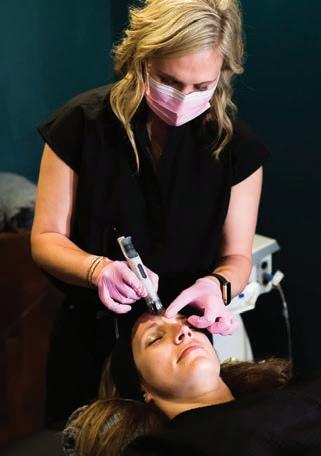










Everyone wants wardrobe mileage these days. Build your look around these staples, and dress them up or down with chic extras.
STYLING BY SHAYNA MACE & SHELBY ROWE MOYER | STYLING ASSISTANT MASON BRAASCH





PHOTOGRAPHY BY HILLARY SCHAVE
When are stripes not in style? This navy and white pick pairs up with endless closet options. French Connection Tommy rib longsleeve top, $68 , Cosa Boutique

DRESS IT DOWN: Liverpool plaid jacket, $109 , Cosa Boutique ; NOEND Denim high-rise straight crop jean, $138 , Tradition Women’s Market ; Kikichic lock necklace, $44 , and Adelia Street Designs stretch bracelets, $32 & $42 , both from Cosa Boutique ; Crown Vintage Gingerbread leather boot, $69.99 , DSW
DRESS IT UP: Summum Woman olive blazer, $248 , Tradition Women’s Market ; Liverpool Abby skinny ankle jean, $98 , Cosa Boutique ; Coco + Carmen gold stretch chain bracelet, $29 , McFee on Main ; Franco Sarto Jonia leather slingback, $59.99 , DSW ; David Aubrey necklace, $88 , and C’lel leather handbag, $198 , both from Tradition Women’s Market









These easily transition from weekend to work with its tailored silhouette and the addition of an elegant front pleat.
Coco + Carmen Jasmine Traveler pant, $30 , McFee on Main

This bag can be worn on the waist or as a cross-body!




DRESS IT DOWN: Velvet Heart Denim jacket, $79 , McFee on Main ; Cival Sunny hoops, $52 , Tradition Women’s Market ; Z Supply Larisa Bolt sweater, $65 , Cosa Boutique ; Haute Shore black puffer belt bag, $47 , McFee on Main ; Nike Court Vision lo sneaker, $69.98 , DSW
DRESS IT UP: LAMARQUE Donna leather moto jacket, $575 , The Shirt leopard blouse, $118 , David Aubrey necklace, $68 , JaxKelly smoky quartz hoops, $4 0, Fortress of Inca mules, $238 , all from Tradition Women’s Market



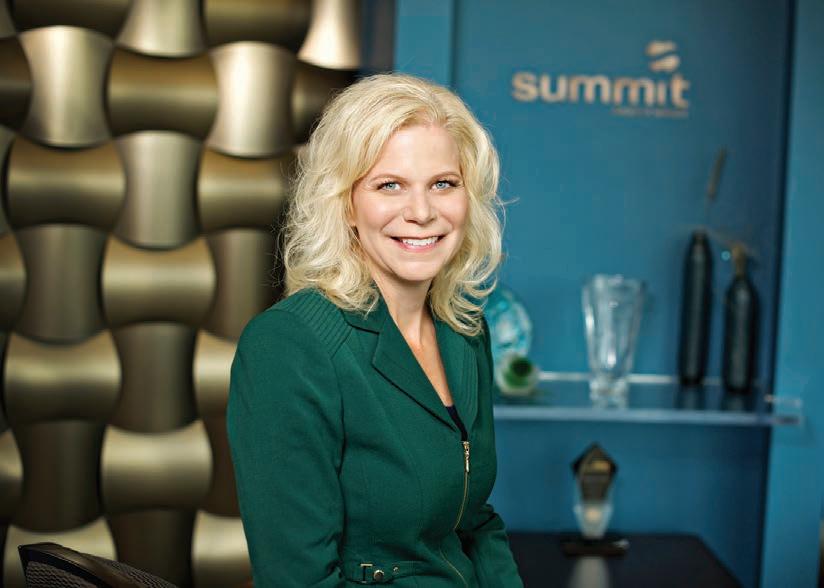
BY KIM SPONEM
Having that cash in hand makes all the difference when you see a $20 bill dwindle. At the end of the week, any lunch money that’s left over is combined and goes into an envelope for a dinner out on the weekend or a future date night. And joyful spending? That’s ours to keep and save, and it adds up fast! It has actually become a bit of game comparing our joyful spending balances. We deposit the extra cash into our accounts, and we can keep track of the balance using Summit’s Climbr®. It’s super easy to use, with the ability to create additional savings accounts online to keep track of our savings goals.
On grocery spending changes, they share this:
1. Set the budget: We came up with an amount that worked for us, and put it in Summit’s Climbr. We also turned on notifications that will tell us when we are getting close to our spending limit.
2. Plan the menu: We sit down and figure out how many meals we are going to need for two weeks. We include leftovers at least once a week and we order takeout every couple weeks.
Through Summit’s annual Project Money challenge, participants work with a Summit financial coach to lower debt, increase savings, strengthen their financial well-being and compete for a $10,000 prize while sharing their experience on TV and online so thousands can learn and take action.
What kind of changes could I make for a better financial life?
To help answer this, I’ll share some ideas from Dustin and Scott, Summit Credit Union’s Project Money 2020 winners, as they spent a seven-month journey changing the way they think about money and the behaviors they put into place, including planning and spending differently, using technology to support progress, and adding incentives.
We used to keep track of individual personal spending on a credit card, and we would “joyfully spend” and then transfer money from personal accounts to the joint account to cover the credit card bill each month. This was a little complicated and we often lost track of just how much joy we were adding to our lives. We had a lot of months where the statement balance on our card was a lot more than we thought it would be. We switched to using cash, and it’s made a big difference. The same goes for our spending on eating out. We’re both often on-the-go for work, or we don’t plan ahead on what to take for lunch and end up grabbing something during the day. It became way too easy to just put it on the card. We had a budget, but we often blew it. We also made eating out a cash budget item, and it resulted in another huge change.
3. Shop the list: Our grocery list is driven by the things we need for the menu. We “shop” our pantry first to see if we already have something we need, and that helps to keep things in check. We mostly buy just the items on the list, although we aren’t afraid to take advantage of in-store sales on staples we know we will use.
Some benefits from all of this planning are always having an answer on “what’s for dinner?,” less eating out and keeping us at or under budget, which means less stress, fewer impulse purchases and less time at the store. We are learning that sometimes it’s not about what you saved, but the satisfaction that comes from not overspending and sticking to your budget.”
Need more inspiration? Summit’s 2021 Project Money season is in full swing and participants are sharing at SummitCreditUnion.com
Kim Sponem is CEO & President since 2002, of Summit Credit Union, a $4.8 billion, memberowned financial cooperative with more than 218,000 members and is federally insured by the NCUA. Kim has a passion for empowering people to improve their financial well-being for a richer life.
Ask Kim your money questions at MoneySmarts@SummitCreditUnion.com.
BY SHAYNA MACE
PHOTOGRAPHY BY SHANNA WOLF
Once an entrepreneur, always an entrepreneur. Such is the case for Kelly and Joe Leschisin, who not only own KELLA, a gift and apparel shop in Mount Horeb, but Forward Apparel Co., a Wisconsin-themed clothing line. (Joe also founded Kella Design in 2008, a digital marketing and web design agency, which Kelly also works at.)
After working on client marketing projects for years at Kella Design, the couple had a desire to create their own product from start to finish. Enter Forward Apparel Co., a line of Wisconsin-themed shirts and hats with sayings such as “Wisco Made” and “Up North.” The couple’s retail space on Main Street features their own apparel items, as well as pieces from 40-plus Wisconsin makers. They love showcasing the creativity of the Dairy State.
“There’s so much more to Wisconsin than beer and cheese — there are so many cool things to discover here,” says Kelly. “We’re trying to represent what the state is all about.”
118 E. Main St., Mount Horeb, madebykella.com

Flags Over Wisconsin’s cheeky candle can be used as a pint glass once it’s used up. $28



SHOP THE LOOK


Kelly Lechisin says their Wisconsinthemed prints are one of KELLA’s best-sellers, like this state parks version. $15-$30
Forward Apparel Co.’s “Northerly” cap is another hit item. $30


“The lake is one of our favorite places to be, no matter which body of water it is,” says Kelly of this Forward Apparel Co. sweatshirt. $40
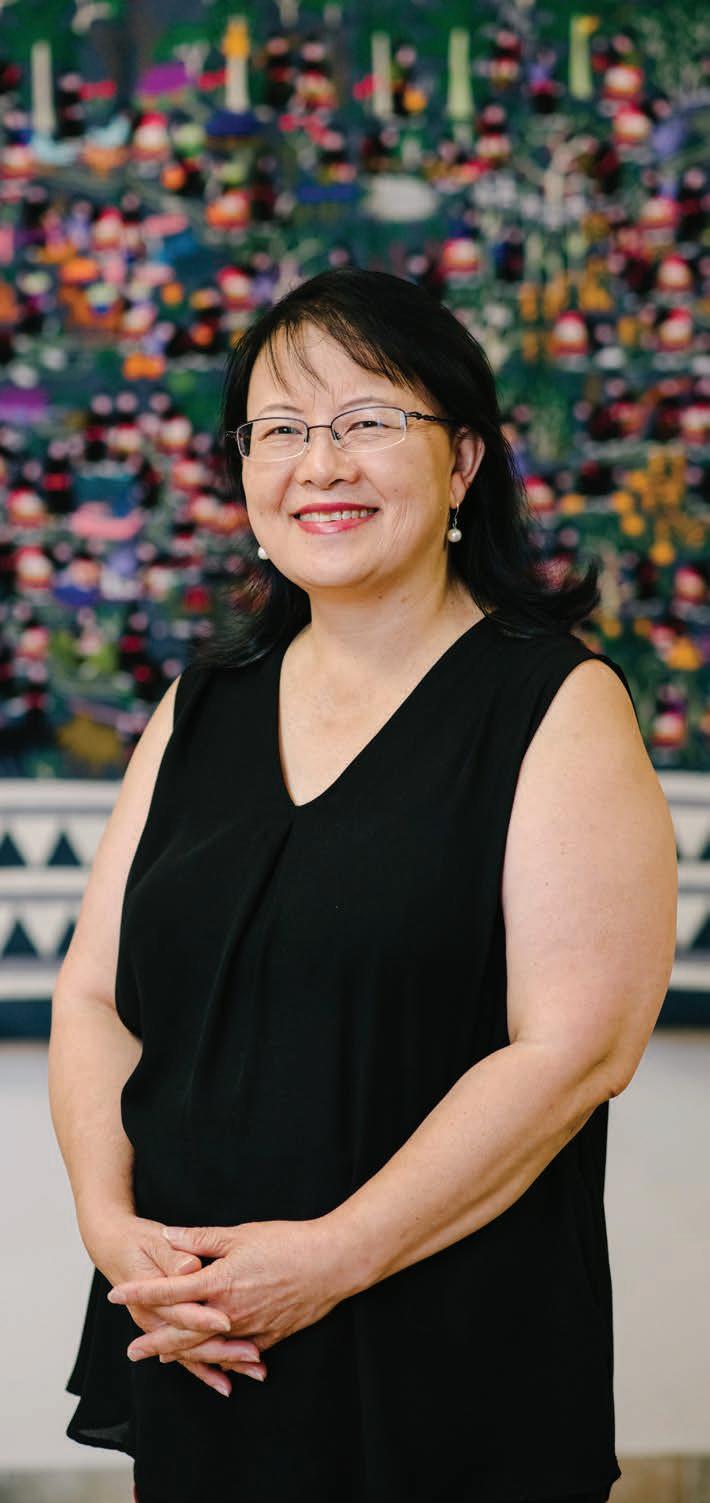
Mai Zong Vue’s tireless advocacy work over the last three decades has built a support network for Hmong people living in Wisconsin.
BY EMILY MCCLUHAN PHOTOGRAPHY BY HILLARY SCHAVE
As a young girl, Mai Zong Vue’s family was pushed from their home in Laos to a refugee camp in Thailand, after the fall of Saigon when the U.S. withdrew its troops following the Vietnam War. Vue had to walk to a well every day for water, had no electricity and limited food. Being so far from home, she clung to her Hmong heritage and traditions, which provided her familiarity and a sense of home. Vue’s community was also tight, and its members focused on finding a better life outside of the camp.
In 1980, when Vue was a teenager, her family landed in Monticello, Illinois, as part of the Refugee Resettlement Program sponsored by the U.S. government. Her family soon relocated to Kimberly, Wisconsin, to be with her older sister’s family. Vue quickly established herself as an advocate for the Hmong community in Kimberly.
“Coming here as a Hmong teenager, you learn the language first. You have to interpret for your parents when they go to the hospital or wherever they need to go outside of the house,” she says. “Then you learn to navigate the system, because now you have to educate them ... and you have to tell the doctor what doesn’t work for your parents. So interpreting leads to navigating, and then navigating leads to advocacy.”
By her senior year in high school, Vue’s advocacy extended to relatives, fellow students and their families. Post-college, her second job was with the Department of Workforce Development in Madison. While there, she began a refugee women’s program that eventually folded in a focus on refugee mental health and domestic abuse. (She continues to manage those programs through the Department of Health Services.)
Vue spent much of the 1990s and 2000s advocating for refugees at the national and

CIAO BELLA BOUTIQUE AND MORE
305 E. Main St. Waunakee, WI 53597
608.849.2426
Great transitional pieces for year-round wear. Cozy and casual to fashion-forward styles. Come check out our fun, new apparel, shoes, accessories, jewelry, gifts and more!

ciaobellaboutiqueandmore.com C iao Bella Boutique AND MORE

QET BOTANICALS
2018 Main St.
Cross Plains, WI 53528
608.798.1738
QetBotanicals.com
DÉCOR FOR THE WELL-DRESSED HOME
3000 Cahill Main, Suite 215 Fitchburg, WI 53711
608.444.0571
decormadison.com


MCFEE ON MAIN
400 E. Main St. Mount Horeb, WI 53572 mcfeeonmain.com
Unique home accents and local art. We showcase several styles including contemporary, modern, eclectic, transitional and more. Stop in and shop with a professional interior designer!
The perfect piece for your fall wardrobe; a cozy wrap that works both as an outdoor piece or over your jammies while having your morning coffee. It’s like you’re wrapped in love every time you wear it. SPRING INTO FALL

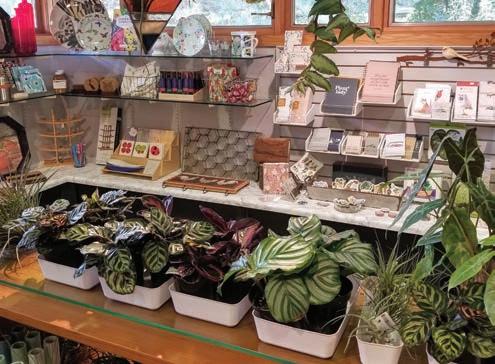
Unique garden-themed items for the whole family. Open daily! Shop a completely refreshed look and feel, and browse a variety of brand-new products and items.
OLBRICH BOTANICAL GARDENS
GIFT SHOP
3330 Atwood Ave. Madison, WI 53704
608.246.4710
olbrich.org

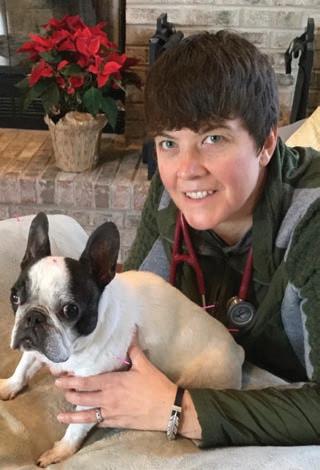
HEALTHY BALANCE VET
Heidi Hemmett
DVM, CVA, CVSMT, CVMRT
Greater Madison Area
608.440.0707
drh@healthybalancevet.com healthybalancevet.com
Veterinary exams and certified manual therapies, which include: acupuncture, spinal manipulation and massage. We work with pets living with arthritis, chronic pain, disc disease and cancer. House calls within Dane County or office visits by appointment at the Fitchburg Veterinary Hospital.

international levels, but once she got married and started having children, she turned her focus back to Wisconsin, and specifically, the Hmong community in Madison.
In 2018, she and husband Peng Her were able to draw upon her 35 years of advocacy work and founded the Hmong Institute, housed at the Life Center on Madison’s east side. It includes the Hmong Language and Cultural Enrichment Program for Hmong children — yet another program Vue started in 2013 with support from other Hmong parents who saw their children struggling to keep up in Madison schools.
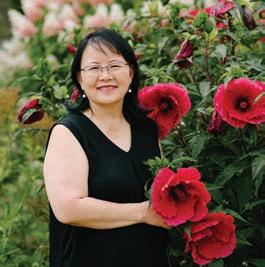
“We bring Hmong elementary and middle school students together, and teach them Hmong language and culture, and also give them academic support on reading and math,” she says.
An additional challenge many refugees face as children is the push to acclimate to the U.S., while still honoring their culture and heritage, Vue explains. Another of the program’s goals is to deeply root the Hmong culture early, so kids can accept and value who they are as Hmong people living in the U.S.
The program also creates opportunities for the young Hmong women who teach it. Vue says it boosts their confidence and prepares them for leadership roles in their personal and professional lives.
The Hmong Institute also houses Hmoob Kaj Siab, a holistic senior center and mental health support program for Hmong veterans, elders, women and families. Vue proudly shares how one of the young Hmong women she mentored since 2015 is now the first home-grown Hmong psychologist in Wisconsin and provides services through Hmoob Kaj Siab.
“We started out with a bilingual person who just spoke broken English to serve the community. And in the next decade we had case managers who spoke more English and understood more of the system. Fast-forward to now, and we have a Hmong professional who is trained in mental health,” she says. “My hope is that all of the trauma and PTSD that is glued together like an onion can be peeled apart by someone like her, and we can start to heal our community.”
Recently, one of Vue’s friends asked her if she’d ever reflected on the impact of her years of advocacy for the Hmong community. Vue paused, and admitted that she hadn’t. The work is never done in her mind — but she agrees that it might be time to appreciate her successes and the road she has paved for future generations of Hmong people in Wisconsin and around the world.
Emily McCluhan is a Madison-based writer, runner, volunteer and dog mom. Her contributions to regional publications in Michigan, Montana and Wisconsin over the last 20 years provide an outlet for her insatiable curiosity and passion for telling the stories that open our eyes and connect to our everyday lives.
THERE’S A SCREENING FOR THAT
Keeping up on all of the health tests we should be getting can be overwhelming. Here’s your primer on what to know.
BY EMILY MCCLUHAN
While it’s not enjoyable, being poked and prodded is sometimes part of our annual wellness exams. The screenings we undergo at these visits are crucial for detecting and preventing conditions like cancer, heart disease, stroke and diabetes.
To sort all of these screenings out, we asked Dr. Elizabeth Neuman, an OB-GYN with Physicians for Women, about what screenings are necessary to do and when, when to depart from typical guidelines and any updated guidelines we should know about.
Why It’s Important: Cervical cancer used to be the leading cause of cancer deaths in women, but thanks largely to screenings like Pap tests, the number of cervical cancer deaths in the U.S. has dropped by 50% since the mid-1970s.
Current Guidelines: Pap and pelvic exam recommendations are the most dynamic and complex of screenings for women. That’s because experts continue to develop new and better ways to screen for cervical cancer with the goal of reducing unnecessary follow-up procedures like colposcopies (when a doctor removes a small piece of suspicious tissue from the cervix or vagina for testing).
For healthy females, Neuman follows the American College of Obstetricians and Gynecologists (ACOG) recommendation of starting Pap tests at age 21, and then every three years until age 30.
“From age 30 to 65, the recommendation is to start co-testing,” says Neuman. “That means you have a Pap smear, but the sample is tested for both abnormal cervical cells, as well as HPV.”
If the results are normal, women can go up to five years between screenings, but Neuman says annual wellness exams are still important for staying on top of pelvic, breast and heart health.
New Information: HPV is the leading cause of cervical cancer, but your body often clears the virus on its own.
“The good news is the HPV vaccine is now recommended for
women up to age 45, independent of whether or not the woman has had a prior abnormal pap smear. And the HPV vaccine can not only prevent cervical cancer or pre-cervical cancer, but it also protects against genital warts and certain types of vaginal cancer,” Neuman says.
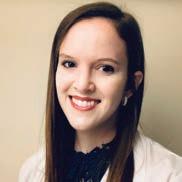
Why It’s Important: “The long-term effects of an untreated STD can be serious, and for some women, could affect their ability to get pregnant or lead to long-term health problems,” says Neuman. These can include pelvic inflammatory disease, infertility, cervical cancer and congenital infections in infants born to infected mothers.
Current Guidelines: For sexually-active women under age 25, the recommendation is to get tested for STDs, including gonorrhea and chlamydia, every year. Women over 25 should still be tested based on factors like new or multiple sexual partners.
New Information: Previously, the CDC recommended that anyone born between 1945 and 1965 be tested at least once in their lifetime for Hepatitis C, which can also be spread by sexual contact. In 2020, that guideline was updated to a recommendation for all adults over the age of 18 being tested at least once in their lifetime, regardless of risk factors or other lifestyle behaviors.
“There is also a recommendation that all women between ages 15 and 65 get tested at least once in their life for HIV,” Neuman says and adds that all women who get pregnant will be tested for both of these viruses.
Why It’s Important: About one in eight women will develop invasive breast cancer in their lifetime according to breastcancer.org , but finding breast cancer early reduces your risk of dying from the disease by 25-30% or more.



Wendy Warren Grapentine of Group Health Cooperative explains why stress lingers and how to clear it.
great stress management tools. Here are three of my favorite types:
Weall know we’re stressed by work, family, finances and the state of the world, but what goes on inside of our bodies when we’re stressed?
Well, our bodies haven’t evolved that much since caveman days. You’ve probably heard of the “Fight, Flight or Freeze” response. This automatic physical response poses two big problems for modern humans. First, our bodies can’t differentiate between the stress of being attacked by a sabertooth tiger or the stress of having a fight with a loved one or receiving a bill we can’t pay. We react to all stress as if it were an immediate threat to our lives. And, we can’t run away from modern stressors like we can from an attack by a wild animal, so we freeze. This means our stress response doesn’t run its full cycle, so hormones like cortisol build up over time, causing a lot of the chronic diseases we see today.
What are some techniques to help reduce stress?
The key is to recognize that stress reduction is a whole-body endeavor, and there are lots of
1. Physical movement allows the stress response to run its full cycle. Walking, running, biking, yoga, tai chi,etc. — all help complete the stress cycle and avoid “freeze” mode.
2. Strategies that shortcircuit the stress response and send signals to our body that we’re physically safe are key. Power poses (such as standing like Wonder Woman) are a simple, three-minute technique you can employ to reduce the stress hormone cortisol. A study showed standing or sitting with your arms and legs open and away from your body reduces cortisol levels by 25%.
3. Techniques to reduce our overall stress “set point.” Meditation and mindfulness are great for this. A regular meditation or mindfulness practice calms the autonomic nervous system, so that smaller stressors don’t feel like bigger ones, and when big stressors do come along, you have more capacity to handle them. What resources does GHC offer?
GHC’s Complementary Medicine Department offers so many
options! Our massage therapists can help you work out the kinks from sitting at a computer all day, and a good massage sends signals to your autonomic nervous system that it’s OK to relax, and that you’re safe.
Our acupuncturists have protocols that address stress, and I always feel so calm and peaceful after a session. We’re now offering mind/ body and somatic awareness appointments where you can get in touch with how your body responds to stress, find relief from it and learn tools for selfcare between sessions.
Finally, we offer a variety of classes: Zumba, yoga, meditation and mind/body classes focused specifically on reducing stress.
Visit ghcscw.com for appointments and classes, and see our YouTube channel for videos!
— Wendy Warren Grapentine, LMT, Stress Management Practitioner, Reiki Master at Group Health Cooperative
Current Guidelines: As an OB-GYN, Neuman says she follows the ACOG guidelines, which recommend mammogram screenings every one to two years starting at age 40 for average-risk women, and continuing until age 75.
There are differences in what other organizations recommend concerning mammograms, though. The American Cancer Society (ACS) recommends mammograms every year starting at age 45. (The ACS says women can also start screening as early as age 40 if they’d like.) The U.S. Preventive Services Task Force (USPSTF) recommends screenings every other year from ages 50 to 74 to reduce the chance of overdiagnosis and unnecessary biopsies or treatments. Talk with your doctor about your own family history and risk level to determine when and how often to have a mammogram.
Other Considerations: “Patients who have any sort of genetic cancer syndrome, like BRCA gene mutations, need to connect with their doctor in their 20s to start screenings,” Neuman says. Genetic testing is not readily available to the general public, but your provider can conduct a risk assessment to determine if you qualify for the testing.
Why It’s Important: Colorectal cancer is the third-most common cancer in the U.S., and early stages of colorectal cancer typically don’t have symptoms. Luckily, many colorectal cancers can be detected and prevented through regular screening.
Current Guidelines: Historically, the USPSTF recommended that average-risk patients begin colonoscopies at age 50 and repeat every 10 years if there are normal results. Based on new research and an increase in the diagnosis of colon cancer in people younger than 50, Neuman expects that at some point the new recommendation by all organizations will be for everyone to get a colonoscopy at age 45.
“For now [though], most providers — including OB-GYNs — would stick with age 50 for average-risk patients [that are not Black]. For African American patients, the recommended age to begin (even for low-risk patients) is age 45,” she says.
Other Considerations: “Direct-to-consumer tests, like Cologuard, are an OK way to start screening for average-risk patients who are opposed to colonoscopies,” Neuman says. “But keep in mind, that is just a screening. If your results are abnormal, your doctor will recommend a colonoscopy.”
She reinforces that a colonoscopy is both a screening and a therapeutic tool. If polyps or abnormalities are found, they can be removed during the procedure, preventing them from progressing into cancer.
Why It’s Important: High blood pressure, or hypertension, is often called the “silent killer,” because it comes with no symptoms.
“About half of the U.S. adult population has hypertension, and it’s a major contributor to heart disease, stroke and other serious health consequences, and the longer it goes untreated, the worse those consequences can be,” says Neuman.
Regular blood pressure checks allow early intervention like diet and exercise modifications.
Current Guidelines: Hypertension can occur at any age, so blood pressure checks are a part of routine exams.
No matter your age, keep these screenings in mind.
This is administered as a validated screening questionnaire during routine office visits.
“These screenings are a good opportunity for patients who maybe didn’t know how to bring up concerns about depression or anxiety, and to get their foot in the door and start having those conversations if they are struggling,” Neuman says.
Your primary care doctor should do a visual check of areas of concern during annual exams.
“Even just one severe sunburn as a child can put you at increased risk of developing skin cancer,” Neuman warns. “It’s important to be aware of any changes to skin or moles, especially for fair-skinned [people].”
It’s recommended by the USPSTF to have your cholesterol tested annually starting at age 45 for women at a healthy weight, but screening may start earlier (at age 35) to stay in front of risk factors like weight, diabetes, family history or even as part of an employersponsored health plan incentive.
This annual blood test is typically included with a cholesterol screening starting around age 45 for low-risk women. Many risk factors exist for women to begin screening earlier, such as being overweight or obese.
“Additionally, patients that have polycystic ovarian syndrome, which is a complex endocrine disorder, are at almost double the risk of getting diabetes in their lifetime,” Neuman says. – EM
New Information: In 2017, the American College of Cardiology and the American Heart Association changed the threshold for diagnosis of stage one hypertension from 140/90 to 130/80.
“That means there’s going to be a greater incidence of patients who are being diagnosed with stage one hypertension, and the goal of that is to identify more patients early on to start interventions early,” says Neuman.
Other Considerations: For women planning a pregnancy, Neuman says it’s important to know prior to conceiving if you have hypertension since this can increase the risk of complications during pregnancy, like preterm birth, placental abruption and preeclampsia.
“Also, if you are diagnosed with high blood pressure or preeclampsia during pregnancy, even if it normalizes postpartum, you’re at about a 50% increased risk of high blood pressure later in life,” Neuman says. “Be sure to discuss any risk factors you have with your OB-GYN or primary care provider.”

Why It’s Important: Women are five times more likely to have osteoporosis compared to men, and a bone density test, called a DEXA scan, can identify your risk for osteoporosis and bone fractures.
Current Guidelines: The recommendation from the ACOG for an average-risk patient is to start DEXA scans at age 65 and space them 15 years apart, so most women will only need one or two scans in their lifetime.
Other Considerations: “There are a lot of exceptions and certain groups of women who need to start having these scans sooner than age 65,” Neuman says.
She lists the following factors as reasons to be tested earlier than age 65:
• Long-term immune modulating therapies, like medications for rheumatoid or psoriatic arthritis
• Chronic steroids
• History of an eating disorder, even if you’ve recovered
• Smokers
• Family history of osteoporosis.

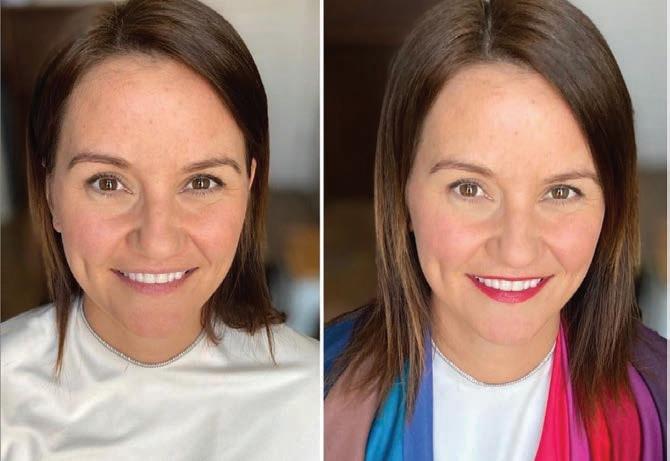
Many cancer survivors say the disease doesn’t end with treatment, as they mourn the loss of their former lives and may continue to experience side effects.
BY SHELBY ROWE MOYER PHOTOGRAPHY BY SHALICIA JOHNSON
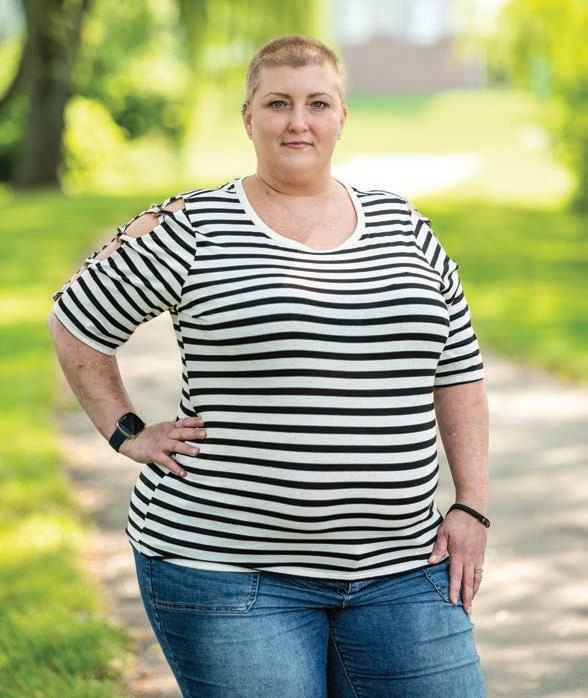
The questions Samantha Peterson hears about her experience with cancer can be frustrating. She fields comments like: “At least you don’t have some other type of cancer. The breast cancer you have isn’t that bad.” Or: “You’ll be fine! You look great! You don’t look like you’re sick.”
Cancer is cancer, she says. No matter what kind you have, it’s still a hard thing to go through.
Peterson, a Madison resident, was diagnosed with triplenegative breast cancer in 2018 and underwent roughly five and a half months of treatment. At first, she felt guilty about how few side effects she was experiencing. But then, after several rounds of chemotherapy, she developed a low white blood cell count and neuropathy (numbness and weakness in the fingers and toes) and had to stop the regimen early.
The 32 rounds of radiation that followed caused painful and debilitating burns, and her skin continues to feel tight and achy where she was treated. Her lumpectomy (a procedure that removes a portion of the breast tissue) resulted in dramatically uneven breasts. A breast reduction on her right side made her chest a little more symmetrical, but she says all of the scarring and deformation makes her self-conscious.
Peterson has vision and hearing loss, body pain and fatigue. One of the worst drug-induced effects, however, is the memory loss, she says.
“Even to this day my chemo brain is so bad,” Peterson says. “My house is surrounded with white boards and sticky notes. I’ve got reminders on my phone. It’s terrible. I mean, chemo brain is a big one.”
Peterson didn’t fully realize how much of her old self she
had lost until she fell asleep one day — a few months after she finished treatment — and was late picking up her kids from school. It was that moment that she knew she would never have her old self back. Her chapter on cancer will never truly close, she says, because its after-effects are probably a permanent part of her life.
“I get annoyed with people when they’re like, ‘Oh, you’re done with treatment? You’re all good now? You’re all better?’” she says. “And I’m like, I’m the furthest from better. If anything, I’m worse.”
A diagnosis of cancer doesn’t end when treatment ends, and the mental after-effects can be just as distressing. In fact, cancer psychologist Lori DuBenske — senior psychologist at UW-Madison’s Department of Psychiatry and a practitioner at UW’s Carbone Cancer Center — says many of her clients are referred to her post-treatment. Having a cancer diagnosis is hard, but it also comes with a plan and regular monitoring.
“When you finish cancer treatment, you kind of lose that safety net,” she says. “It comes with much more ambiguity. It’s a time of uncertainty; of concern about it not being watched as much. The security that came from doing something about the cancer is no longer there.”
Two of the biggest themes for cancer survivors that can lead to distress, anxiety or depression are uncertainty and loss. Uncertainty often unfolds in the form of nagging questions — will the cancer come back; how long do I have to live; will these symptoms go away? The uncertainty often stokes fear, worry and panic, DuBenske says.







As children over the age of 12 have become eligible to receive the COVID-19 vaccine, many parents have struggled to decide whether to immunize their children. As a mother of two daughters, I had fears of my own to work through. It is natural to be skeptical of new medical technology, especially during a time when information about the virus and the vaccine seems to change daily. I was trained to think about medical decisions in terms of risk versus reward, and the benefit of the COVID-19 vaccine outweighs any danger by leaps and bounds. As someone who works in medicine, I naturally hear a lot of questions and concerns, so I want to address a few about the vaccine, so that you can make an informed decision.
Myth 1: We’ll have to take time out of school or childcare if my child gets sick from the vaccine.
Reality: The vaccine can’t make you “sick.” The risk of inflammation of the heart and its lining after the vaccine is real, but it is extremely rare, and it is treatable. It is possible to feel lousy for a bit, if your immune system is working

UnityPoint Health — Meriter’s Kimberly Moreland, a family nurse practitioner, addresses concerns and myths.

hard. Most people don’t have side effects other than a sore arm. Those that have whole-body side effects, like fatigue and headache, usually feel better within a day and many can go about their usual activities with or without a dose of Tylenol.
Myth 2: My kids are healthy, and I’m healthy. If we get COVID-19, we’ll be fine.
Reality: People with chronic diseases are at greater risk for severe COVID-19, but it can happen to healthy people too. The sickest COVID patient I saw in my practice was also the youngest. Long COVID is also no joke. You may survive and avoid the hospital, but you might have other lasting effects and health impacts. Or, you could infect someone else and they could become severely ill.
Myth 3: The vaccine can cause infertility.
Reality: During the vaccine clinical trials, 36 women became pregnant. None of the mothers who received the vaccine and became
pregnant had miscarriages or major complications. In addition, fertility clinics had the opportunity to observe what happened during various important parts of conceiving and saw no differences in the fetuses or pregnancy outcomes.
Myth 4: The vaccine was rushed, and we don’t know what the long-term effects will be.
Reality: mRNA vaccine technology was in development for 20 years before the COVID-19 pandemic. Think about this as a plug-and-play system. Scientists were able to sequence the code for the COVID-19 spike protein in days, then they plugged it into the delivery system that had already been in development. The vaccine teaches the immune system to attack the spike protein. The vaccine does not change your DNA. Vaccine side effects are seen quickly, in minutes to days. Nearly 4 billion people have received a COVID-19 vaccine. We already know what to expect from these vaccines.
— Kimberly Moreland, Family Nurse Practitioner

And then there are feelings of loss and mourning, she adds. Some are permanent effects. Some women have lost their breasts or the original shape of their breast(s). Some have lost their fertility. And then there are some effects that can be temporary, like hair loss or the inability to maintain a career or social life at the same level as before.
So, when working with patients, DuBenske says cancer psychologists often use a biological-psychologicalsocial approach — addressing the biological changes caused by cancer treatment and the psychological effects of having cancer and going through treatment. In terms of social factors, DuBenske says she also examines how the reactions of friends, family and co-workers might be impacting cancer patients as well.
The emotions can be complicated, DuBenske says. It’s common to feel worried and anxious after treatment, and some have guilt about those feelings with thoughts like, “I’m alive. I’m done with treatment; shouldn’t I feel good about that?”
few months for checkups. If she wasn’t feeling well, Peterson was told to see her primary care doctor.
Peterson says she felt like her whole safety net disappeared. “I was forgotten,” she says about the sudden drop-off of support. “That’s exactly how I felt.”
The transition after treatment would have been made easier physically and emotionally if there was a structured post-treatment plan, Peterson says — one that set her with ongoing care, like support groups, a therapist, physical therapy and pain management.
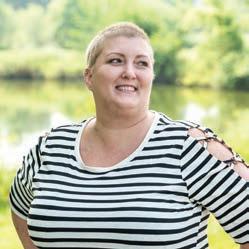
Shortly after being diagnosed, Peterson started attending a support group through Gilda’s Club Madison, a cancer support community for anyone battling the disease or survivors (whether it’s themselves or a loved one). She says it was the best thing she did for herself. Being surrounded by other people who know what she’s been through — because they’ve experienced it too — was incredibly healing and validating.
“We’re able to let them know that their distress is normal,” DuBenkse says. “They can let go of their judgment, and then they’re able to feel what they’re feeling and move through that. When you go through this experience, there’s some necessary sufferings that are going to happen. There’s some necessary physical suffering. There’s necessary emotional suffering. Our job as cancer psychologists is to reduce any unnecessary suffering [like fears about the future].”
Peterson echoes many of Dubenske’s patient’s experiences. She says her transition out of treatment was tough. Because her chemotherapy treatment ended abruptly, she never got to say goodbye to the team that was taking care of her. She went from seeing her oncologist frequently to once every
Peterson says based off of her experience, although a cancer survivor may not “look sick anymore,” someone in the post-treatment phase may be navigating invisible struggles. She says if someone in your life is going through this, showing up for them when they need help or simply listening can be a huge help.
Unfortunately, Peterson was recently told that her cancer returned as metastatic breast cancer, and she’s going through treatment again. To other women going through this, she wants them to know that “you’re not alone. You’ve got to find a group, even if it’s online. Find people you can talk to, because you’re definitely not alone.”
For cancer support resources, visit the online version of this article at bravamagazine.com.
Gut health affects not only our overall wellbeing but our mental wellness too.
BY EMMY BAWDEN
Google search of the phrase “gut health” yields a staggering 743 million results (and counting). This makes sense, given the explosion of research on the gut microbiome in recent years — and for good reason. The microbes that inhabit our gut influence so many different aspects of our health and wellbeing, and experts are continuing to understand just how influential of a role they play. And while you may be somewhat aware of how the microbes in our intestines (mainly our large intestine) affect our gut health and functioning — or how our gut and brain are able to communicate — you may not know these four facts about the gut microbiome.
Perhaps you’ve heard that probiotic-containing foods are beneficial for your gut health. Or, you’ve tried foods like sauerkraut, kefir and Greek yogurt … and you discovered that you’re not a fan. Are there other foods known to positively impact gut health? Absolutely!
There’s good news for tea lovers. Evidence shows that tea consumption can have several beneficial effects on the gut microbiome. Most notably, regular tea consumption may have the ability to offset gut dysbiosis (a reduction of the diversity within your gut bacteria and/or an imbalance between the beneficial and pathogenic bacteria), which is a known negative outcome of high-fat diets. This includes diets that are high in animal-based protein, as well as the Keto diet. If you are a green
tea drinker, shoot for drinking four to five cups per day as this has been reported to increase the beneficial Bifidobacterium strains in your gut. Black, oolong, Pu-erh and Fuzhuan teas also have promising research, suggesting their ability to modulate microbial diversity.
Not into tea? No problem! Another way you can change up your diet to support more beneficial gut bacteria is to include more plant-based proteins and whole grains in your routine. Research shows animal protein-based diets are associated with increased pathogenic bacteria in your gut, such as E. coli . On the other hand, diets that include plenty of plant-based proteins (such as beans) and fiber-rich carbohydrates (such as whole grains) are associated with more beneficial bacteria, certain strains of which have been shown to play a protective role against gut inflammation. Interestingly, there is also evidence that when gut bacteria ferment whole grains, they produce compounds that may influence our satiety levels.
Hormonal regulation within the body is incredibly complex, and an exciting new area of research on the gut microbiome is adding to our understanding of it. The gut microbiome has been shown to both significantly impact and be impacted by estrogen levels. In fact, we now know that the gut microbiome is actually one of the main mechanisms that regulates circulating estrogen in the body.

Here’s where things get really interesting: gut dysbiosis actually results in reduced circulating estrogen, because it causes a kink in the process that transforms estrogens into their active form. This result may be one contributing factor to chronic health conditions such as endometriosis, polycystic ovarian syndrome (PCOS), metabolic syndrome, cardiovascular disease and cancer, as well as impacting fertility. Decreased estrogen levels have also been associated with depression and anxiety, as well as cognition and memory impairments in postmenopausal women. Changing the makeup of one’s gut microbiome to increase microbial diversity may be a way to treat such conditions that are regulated by estrogen, but much research is still needed.
You may have heard of the gut-brain axis, or the two-way communication line between our central nervous system and enteric nervous system (the nervous system that lines our digestive organs). Recently, experts have been learning more about the specific connection between our gut microbiome and mental health. Conditions such as irritable bowel syndrome (IBS) have been correlated with depression, as has antibiotic usage. Interestingly, a Belgian research team studying this connection showed that two specific bacterial species within the gut were associated with self-reported high quality of life, while one specific bacterial species was rich in the gut of those reporting a low quality of life. What the researchers found next was truly exciting: In the participants reporting a higher quality of life, researchers found bacteria that produces a metabolite of the neurotransmitter dopamine (one of the “feel good” brain chemicals that impacts several aspects of our wellbeing). This is just one possible hypothesis that experts have regarding the connection between the gut microbiome and our mental health. Researchers also discovered that people with depression more often had a microbiome with low
overall bacterial abundance, which gives even more reason to include foods in your diet that support the growth of beneficial gut bacteria.
I often receive questions about whether or not gluten can ignite gut inflammation. Despite the growing popularity of gluten-free diets in recent years (often in the hopes of promoting gut health), new research shows that gluten intake is actually not likely to damage the intestines of healthy people. A 2020 study published in Molecular Nutrition & Food Research asked participants who selfreported suspected issues with gluten to follow a high-gluten, low-gluten or gluten-free diet. Afterward, researchers tested their blood for signs of digestive problems, including inflammation, using biomarkers that are known to be elevated in other digestive diseases (including Inflammatory Bowel Disease, or IBD). In the end, they found that gluten intake made no impact on any of the markers of intestinal damage that were tested.
Although more research regarding gluten’s relationship to overall gut health is needed, experts agree that for most people avoiding gluten isn’t the key to a healthy gut. Instead, focus on including whole grains, plant-based proteins such as beans and unsaturated fats (such as fish and olive oil) to support beneficial bacterial growth and overall bacterial diversity.
Emmy Bawden , MS, RDN, CD and LDN is a registered dietitian nutritionist and owner of the Madison-based nutrition therapy practice Real Good Nutrition.
BY SUE SVEUM

Most of us know at least one person that has — or has had — cancer. But with early screenings and better treatment options today, cancer deaths have declined by 29% over the last 30 years. While that may not be cause for a major celebration, it’s certainly reason to hope.
We asked four SSM Health oncology providers to give us some insight on what you should know about cancer.

Routine cancer screening is the best way to detect cancer before any symptoms arise, according to Dana Henkel, MD, an SSM Health surgeon. “The goal is to catch a cancer early to have the best chance of treating and curing it,” she explains. “Many times, once the symptoms show up, the cancer’s already large or has spread to other parts of the body, making it harder to treat.”
Many primary care providers will refer you for a screening, but if you’re unsure, the American Cancer Society (cancer.org) recommends the following cancer screening exams:
• Breast Cancer: Annual screening mammograms for women aged 45-55. Annual or bi-annual mammograms for women 55 and older.
• C olon Cancer: Colonoscopy or a stool-based test beginning at age 45.
• C ervical Cancer: HPV or Pap test every 3-5 years for women over the age of 25.
• P rostate Cancer: Check with your doctor about pros and cons of prostate screening tests for men over the age of 50.
• Lung Cancer: Yearly CT scan of the lungs for current smokers — or those with a long-term smoking history — starting at age 55. This includes heavy smokers who have quit within the past 15 years.

Note: These are general guidelines, so if you have a family history or other risk factors for a particular cancer, you should ask your primary care provider what’s right for you. Your primary care provider (PCP) may advise screenings earlier if you have a family history of any type of cancer. Women with a strong family history of breast cancer or genetic mutation, for instance, may need to start getting mammograms — and possibly breast MRIs — earlier than the age of 45, says Henkel. Same with a family history of colon cancer.
One diagnostic test that has become more common in recent years is low-dose CT scans for lung cancer, according to oncologist Lisa Lepeak, MD. Unfortunately, symptoms of lung cancer don’t usually appear until the disease has reached an advanced stage, and regular chest x-rays weren’t found to be effective in extending a patient’s life. “Lung cancer screening can help catch those masses earlier,” she says. “And that can reduce the risk of dying from lung cancer by as much as 25-30%.” For longterm smokers in their 50s or older — who are at a higher risk for lung cancer — the screening may be covered by insurance.
While routine screenings are extremely important, Lepeak

explains that it’s not uncommon for cancers to be discovered as a result of diagnostic testing ordered by your primary care doctor, or even a visit to the ER. “Sometimes people go in for one symptom, such as a cough,” she says, “and something else is discovered.”
After any cancer screening, the report will typically go back to the ordering physician, most often the PCP. Even if the order comes through the ER, the report will go to both providers. “Primary care providers are key people in this process,” stresses Lepeak. “They’re generally the first to have that hard conversation with the patient because of their longstanding relationship. They know them.”
At this point, several things are set in motion, and your care becomes a collaborative process.
Behind the scenes is the Tumor Board: A team of providers that will review the specifics of the cancer diagnosis. According to Lepeak, the board typically consists of a medical oncologist, surgeon, radiologist, radiation oncologist, pathologist and nurse navigator who discuss the patient’s specific cancer and best chance for treatment options.
“Cancer care is highly collaborative, involving multiple specialists,” adds radiation oncologist Timothy Kruser, MD. “And it’s important to customize the care and personalize treatment within the medical support system.” The Tumor Board meeting is a brainstorming session designed to do just that — to determine the best pathway forward regarding the patient’s treatment and the doctors that will be involved.

It’s the Tumor Board’s job to gather information from a variety of sources before treatment planning begins. They first look at the staging process to determine how far the cancer has spread. That might entail ordering additional tests such as a CAT scan, PET scan, MRI or even a molecule test to detect mutations in the tumor. “From there, we ask ourselves, ‘What are the best options to serve this patient?’” says Kruser.
On the patient side of things, after diagnosis, they’ll also be contacted by a nurse navigator, who will likely become one of the most important members of their care team — helping guide them throughout their cancer journey.

“I’m a patient advocate — their next contact after the primary care doctor,” explains Karen Taylor, RN, OCN, adding that she’s the one charged with calling the patient after they’ve been newly diagnosed. She answers any questions they might have, explains the roles of the various doctors they may see and helps them get their appointments made.
Taylor says it would be easy to spend an hour talking about the process but feels it’s more important to ask what the patient may want to know, to find out what’s bubbling up in their mind. Too much information all at once is, well, often too much to digest. “I’d rather ask, ‘What questions do you have?’” she says. “That way I can meet them wherever they are in that moment and help them from there.”
At this point, the patient already knows that a test was performed and something suspicious has shown up. They’ve been referred to oncology and a biopsy or additional tests may have been ordered. While waiting for further results, Taylor says some will ask if they have cancer and she tells them that the doctors are treating it like it’s cancer — but we don’t really know yet.
“I’m very honest, but I don’t try to provide false hope or pat answers,” she explains, adding that she stops short of answering direct questions related to a patient’s mortality or time left. That’s something better discussed with their physician.
Taylor tells patients to call her with questions anytime throughout their journey, and she’ll find the answers. Because she works with the entire team, after writing up her notes, she can add information to the patient’s chart — or contact another provider directly with patient questions, concerns, or changes in their pain, side effects or overall condition.
Meanwhile, the first appointment that Taylor helps them schedule is with a medical oncologist, such as Lepeak. “I’m the first person they see after their primary,” says Lepeak, adding that her job includes being the point person for her patient’s care.
“At our first meeting, we’ll go through the scans together,” she explains. “I’ll show them the images, point out exactly where the cancer is and discuss standard treatment recommendations based on the type, stage and location of the cancer.”

Together, they’ll discuss the next steps. While conservative treatments are usually the preferred option, depending on the circumstances, other treatments or even clinical trials might also be considered. If chemotherapy is required, she’ll manage their treatment. In other cases, she’ll refer them to a surgeon or radiation oncologist, sometimes administering chemo after those treatments are completed. Either way, Lepeak says she follows them (and their care) long-term, always discussing which options make the most sense for them.
You’re probably familiar with the most common cancer treatments: chemotherapy, surgery and radiation — or some combination of the three. Customizing cancer treatments is one of the biggest advancements in cancer over the last decade, according to Henkel. In the past, cancer treatment used to be “onesize-fits-all,” but now treatments can be tailored to target each cancer specifically


and that patient. “Just like no two snowflakes are alike, I tell my patients that no two cancers are alike,” she explains, “so I don’t just treat cancer, I treat their specific cancer.”
Henkel says when she first sees a new breast cancer patient, for instance, she’ll spend nearly an hour going over their cancer diagnosis along with the next steps. “It can certainly be overwhelming and exhausting for the patient,” she admits, “but I want to ensure their treatment plan is the right fit.”
Radiation treatment has also evolved. “There are several cutting-edge treatments under the umbrella of radiation, all used for different purposes,” says Kruser. “Our goal is to find the most effective and gentle treatment option possible.” Two of the most common are external beam radiation and intensity-modulated radiation therapy (IMRT), which he says is used to target a particular cancer, such as prostate or head and neck cancers, adjacent to sensitive organs. With IMRT, curved beams can zero in on the affected area, bypassing other organs. “Another option is radio surgery, which provides very high doses of radiation to a small region — mimicking surgical [removal] in a non-invasive way,” explains Kruser. “We’ve been using it increasingly for brain and lung cancers.”
And what if the patient wants to be more conservative or aggressive with their treatment? “When presenting the treatment options, we respect patient autonomy, but want to give them the best option,” says Lepeak.
The provider’s role, according to Kruser, is to be an advisor who can bring additional insight and special medical knowledge to the case. “But we let the patient know that they’re the boss,” he stresses. “If a patient refuses one option, we go with the next best.” Sometimes the patient needs to
ask themselves if their quality of life will be affected by a treatment necessary for a greater quantity of life. And a 40-year-old may well have a different response than an 80-year-old.
The providers will continue to work together along a patient’s journey through treatment and follow-up, with the nurse navigator bringing it all together. “When someone is struggling with side effects or pain, I’m usually the first to hear about it,” Taylor explains. “I’ll pass on that information, then focus on helping them to better handle their pain.”
One important element in cancer care that’s often overlooked is palliative care, says Lepeak.
So, what does palliative care look like for a cancer patient? “It’s a way to manage symptoms associated with cancer and cancer treatment to help make every single day be the best they can have — through supportive care and coping mechanisms,” says Lepeak.
“Palliative care focuses on treating physical symptoms while providing emotional support, Taylor adds. That’s why the palliative care team may include a physical therapist, social worker, psychiatrist or psychologist.
Physical pain can often be controlled by adjusting a medication or dosage. And according to Kruser, radiation can also be used to help maintain quality of life, by minimizing symptoms of certain cancers like bone or metastatic disease.
But emotions can be a little trickier. “I feel incredibly privileged to step into a patient’s life when they’re feeling vulnerable and afraid,” says Taylor. “We can’t always make the symptoms go away, but what I can do is make you feel better today.”

Create your own bedroom escape with the right colors, furnishings and lighting.
BY SHAYNA MACE
If there’s anything the pandemic has taught us, it’s that spending more time in our homes made us quickly realize the things we want to update — but may not have thought about before.
Your bedroom is arguably an important spot to relax and feel refreshed in. After all, we spend one-third of our lives sleeping — so it’s critically important that this space serves us well.
“When the world is crazy, it’s a huge deal if you can leave those stressors

behind and feel safe, welcoming, calm and relaxed in your bedroom,” explains Larissa Anderson, owner and principal of Haven Design Studio in Madison. “That’s one of the biggest requests I get [from clients] over and over, is to make [their bedroom] feel like a retreat.”
Read on for tips to make your bedroom a calming, stylish oasis.
Anderson says if you have the room, adding in a chair with an ottoman is a great way to up the restfulness vibe in your bedroom.
“Making the bedroom more than somewhere to sleep is something I’m consistently doing now. You can prop your feet up and have your coffee [in your chair] in the morning.”
Lighting shouldn’t be an afterthought, and there are easy ways to make your space look more luxe.

“[Something] that’s trendy right now … is adding sconces next to your bed instead of table lamps. Visually, it gives you that hotel vibe. Functionally, it clears off space on your nightstand,” says Anderson. If you don’t want to hire an electrician to install sconces, you can buy batteryoperated or plug-in versions for less hassle.
Curating a space to pepper in a variety of textures, while still having a cohesive, coordinating look, is the best way to achieve decorating nirvana. Anderson suggests adding a throw rug in your bedroom (whether you have carpet or not) to give a “tactile cue that as soon as you walk in, it’s cozy and you can relax.” Anderson also loves popping a soft,
Larissa Anderson of Haven Studio consistently recommends these bedroom colors to her clients.
SEA SALT
Sherwin-Williams SW6204
SNOWBOUND
Sherwin-Williams SW 7004
SMOKY GREEN
Benjamin Moore CC-700
CASCADES
Sherwin-Williams SW 7623
chunky knit throw blanket on the bed and installing draperies to soften the room. (She also suggests blackout blinds so the space is truly dark.)
Your bedding is also important since you touch it every night, says Jackie Marx, product development and purchasing manager at AmeriDown. The bedding store offers countless options for “warm” and “cool” sleepers, as well as a variety of sheet types, from cotton to linen.

“… To have an ideal sleep environment, it’s really about personal preferences, so it’s quite unique for everyone,” says Marx. For example, percale sheets are “cool and crisp to the touch” whereas sateen has a soft and silky weave. Linen is considered a “luxury fabric, and some say it can last for decades,” says Marx.
Sweet Sleep: These AmeriDown bedding picks will make your bed a welcome spot to wind down in every night.
These 400-count sateen sheets are perfect for colder temperatures and cold sleepers.
$109-$199

This songbird 300-count duvet cover and sham set is easy to wash and is silky-soft to the touch.
$139-$199

AmeriDown’s signature product is their down and down alternative comforters. The mediumweight comforter is the perfect, year-round pick, says Marx. $139-$209

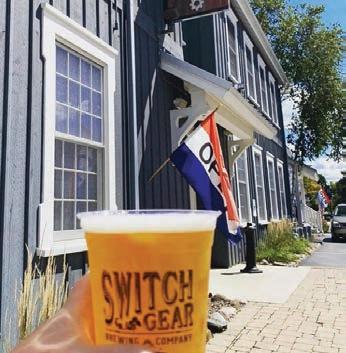



In the era of remote work, it’s time to step up the style of your work-from-home haven.
STYLING AND PHOTOGRAPHY
BY
SHANNA WOLF







ZZ plants can help indoordetoxifyair!



Clockwise from top left: Blu Dot Stash desk, $499 , The Century House (photo courtesy of Blu Dot); Graphic Anthology pencil set, $8 , Arcadia Books ; tortoise blue light blocking glasses, $40 , Paper Source ; navy spiral journal, $17 , Paper Source ; Trust Your Crazy Ideas journal, $10 , The University Bookstore ; vegan leather file folders, $23 , Paper Source ; Gus Radius task chair, $495 , The Century House (photo courtesy of Gus); Rifle Paper Co. headphone case, $25 , Paper Source ; low light ZZ plant, $26 and up, Wildewood ; acrylic calculator, $26, Anthropologie ; and Paperways palette weekly pad, $14 , Anthropologie










This notebook set has illustrated front and back covers by artist John Derian.




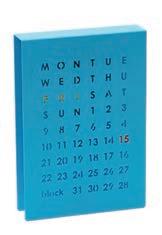
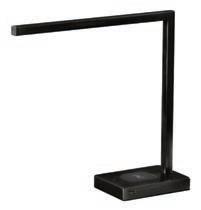
Make WFH that much cooler with these desk essentials.
Top, L–R: John Derian notebook set, $15 , Arcadia Books ; Marble and metal Maxwell letter holder, $25 , World Market ; and Perpetual calendar, $26 , Wildewood Bottom, L–R: Shadow Brush No. 1 daily planner notebook, $40 , Kismet Books ; Daphna Laurens paper clips, $20 , Wildewood ; and metal LED Seward USB and charging pad desk lamp, $199 , World Market


BRAVA asked the financial wellness experts at Summit Credit Union’s financial coaching program to share insights about how to relieve stress in the everyday lives of Americans. At Summit, CEO and President Kim Sponem says that every employee is a financial educator, and Summit’s free financial wellness coaching puts that promise into action.
Wellness isn’t just a state of being. It’s a process, and a journey. At Summit, we often talk about how finances fit into a healthy life — and in short, that answer differs from one person to the next.
Many experts, including Summit’s financial wellness team, use a concept called the 8 Dimensions of Wellness, developed by Rutgers University professor Peggy Swarbrick. The model’s message is simple: Wellness is determined by a variety of factors, all of which have an effect on one another. Your occupational, emotional, spiritual, environmental, financial, physical, social and intellectual wellness interact to make up your overall wellness.
Improving any of these dimensions can enhance your quality of life. Similarly, ignoring one of them will come at the expense of your overall wellness. But financial, one of the eight dimensions, affects each of the others in one way or another.
Financial wellness is just as important to a healthy life as any of the other dimensions. And it doesn’t mean simply paying off debt or following a budget. Financial wellness is about your relationship with money. It’s about the thoughts and feelings money gives you. It’s about how you interact with your money every day. It’s about financial freedom, and how confident you are that you’ll be able to reach your financial goals.
No matter how much money you make or your emotions around money, one thing is true: You’re somewhere on your journey to financial wellness. Along this journey, you’ll have plenty of moments of triumph and victories to celebrate. And still, challenges and questions may arise. But there are steps you can take to live a better life, and that’s exactly what we at Summit are here to help you do.
“Financial wellness is important for everyone, and that’s why education and
empowerment are at the center of everything we do,” says Kim Sponem, CEO and president of Summit.
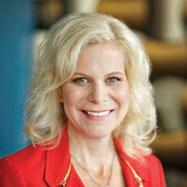
“People often talk about the stress they feel around finances — and we’re here to help transform that stress to a feeling of confidence.”
Financial wellness can impact your mental health as well. Mental health professionals know that financial stressors are one of the most common causes of anxiety and depression today. And this stress isn’t just confined to moments when you’re thinking about your money.
“Everyone has a different set of things that causes them anxiety or discomfort,” says Anna Moffit, executive director of the National Alliance on Mental
Sometimes, every goal you have — personal, financial and otherwise — revolves around the particular life stage you’re in.
When you’re considering buying your first home, the first step is meeting with a mortgage loan officer to discuss your credit history, income and assets, and down payment.
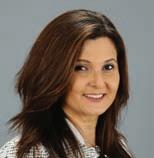
Claudine Carvalho, a Summit mortgage loan officer, believes building wealth through home ownership is extremely important — but she wants Summit members to be able to maintain their lifestyle long after they move into their house.
“The first thing we do is review your monthly budget and discuss what kind of safety net is in place for things like home repairs,” says Carvalho. “So many people we work with feel like
there are too many obstacles in front of them to even start dreaming about owning a home, but we work together to build a roadmap. They won’t achieve their vision overnight, but with the right money habits, they’ll get a few steps closer to owning a house each day — and it’ll feel amazing.”
Summit’s mortgage loan officers can help you navigate these steps when buying a home:
A word on credit. The higher your credit score, the lower your interest rates. If your credit isn’t where you want it to be, we’ll help you make a plan to improve it. According to Carvalho, “If you have to decide between saving and reducing debt, I usually encourage starting with paying down debt. That will get you a better credit score, a better rate and lower closing costs.”
The right loan for you. We’ll look at how much money you have coming in
Illness (NAMI) Dane County. “And these stressors can affect all different aspects of your life, like your relationships, your work productivity, quality of sleep, family life and more.”
If finances are causing you stress, prioritizing your wellness and reaching out for help is the first step in the right direction. No matter what the next step on your financial wellness journey looks like, you aren’t walking alone — we can help you get there.
“Our coaches and experts have worked with so many people in so many different situations, and we can apply all of those learnings to help get you on track for success,” says Sponem. “We know that helping people improve their financial lives makes for stronger communities, so we do everything we can to ensure people have the unique tools and knowledge they need to make the best financial decisions for exactly where they are in life.”
and going out, plus any savings or debt, and show you the loan options, rates and terms that make the most sense for you.
Understanding all of the costs. Your total monthly mortgage payment is made up of four factors known as PITI: principal, interest, taxes and insurance. It’s important to add all of them up when figuring out the monthly payments you’ll be making.
The lowdown on down payments. You could make your new home a reality with as little as a 3% down payment. On the other hand, a greater down payment has advantages as well, such as paying less in private mortgage insurance (PMI). Also ask if you’re eligible for programs that provide assistance with down payments and closing costs for first-time homebuyers who meet certain income requirements.
As your family situation evolves, your financial goals will likely evolve too.
Rachel Slesarik, a senior lending advisor at Summit, knows all about helping people reorganize and reprioritize even the best-laid plans. Her advice? Get clarity on the “why” behind your goals.
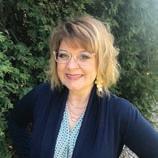
“Most financial goals without an emotional component end up failing, so keep your ‘why’ close. Why do you want to stick to your budget or build up your savings? What emotions will you feel when you achieve your goals? What might that mean for your family or for your future?
Below are some of the milestones Slesarik and her fellow lenders coach people through most often.
Slesarik encourages these two steps before you tie the knot so you can start your married life on the same financial page.
Know your (combined) worth. Measuring net worth — which is what you own versus what you owe – gives
“Breakups can be extremely painful and are typically loaded with emotion,” says Slesarik. “There are also a lot of financial hills to climb, so we often run the numbers with our members so they can make the most strategic decisions possible.”
Here are some things to navigate and how we can help.
Adjust your budget and goals. With your change in income, you’ll need to take a look at how much money you have coming in versus going out. Determine where you’ll need to cut back, and if you have to update your future goals in the process.
Do housekeeping on joint accounts. You’ll no longer be sharing accounts, so
you the most complete picture of your combined finances.
Decide how you want to set up your accounts. Choose whether you want your finances to be joined, separate or in between.
Thinking about having a baby, have one on the way or already knee-deep in diapers? These suggestions are good starting points:
Do your research. Check your insurance coverage for prenatal and birth-related costs. Estimate the cost for maternity and paternity leave, as well as daycare.
Open a savings account for baby’s college costs. A recent study shows a child with a savings account in their name is six times more likely to go to college. “The sooner you start saving for college, the better,” says Slesarik. “We recommend opening a 529 plan and saving a little each month. The key is to get in the habit of setting money aside regularly.”
Draft a will and get life insurance. These actions ensure that your family will be taken care of should something happen to you.

Caring for aging parents can put a tremendous strain — both emotionally and financially — on the primary caregiver. Slesarik’s advice to people navigating this situation: Treat this stage as a marathon, and pace yourself so you don’t burn out too soon.
If you’re in this situation, here are some things you may want to get a head start on.
Get your bearings. Take inventory of your parents’ assets, consolidate their financial accounts and get access so you can help manage them if needed.
Start a dialogue. Ask the important questions: Do your parents have retirement income? Long-term care insurance? Do they own their home?
you’ll need to separate them and make a few updates. Be sure to change beneficiaries for retirement accounts and other funds. Also consider refinancing loans to reflect your new financial situation and start building up individual credit again.
Get your team together. With so many nuances and details in the divorce process, you’ll want to have help from the experts. Consult with your employee assistance program (EAP) at work, with a financial coach, a retirement planner and a divorce expert. They’ll know the questions to ask and steps to take to help get you through it.
Prepare for the “what-ifs.” Have your parents establish a durable power of attorney and health care directive, which gives you legal authority to handle financial and health care decisions if your parents become incapacitated. Take a look at their savings for expenses like outof-pocket health care and assisted living — these bills can be costly, and it’s best to prepare in advance.
Call on the experts. Tax issues can be complicated, so consult a professional to see if you might be entitled to benefits. Also be sure to establish a will and estate plan.
Consider whether to keep your house. If you and your former partner were homeowners, deciding who will keep the house (if anyone) is a difficult decision. If you do keep the house, you’ll want to think about refinancing your loan and determine what steps you need to take to continue making the mortgage payments.

Personal finances are often directly impacted by your business situation, and according to Dana Hoffmann, vice president of business services at Summit, confidence is key in both spaces.
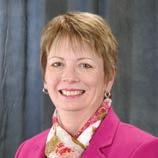
“So many business owners we work with worry that taking out a business loan would be impossible,” says Hoffmann. “Whether you’re struggling through a case of imposter syndrome — the self-imposed idea that your success is due to luck and not talent — or insecurity about your current financial standing, there’s no harm in starting a dialogue so we understand what you want to do and can help figure out how to get you there.”
If you’re contemplating going out on your own, Hoffmann and her team are ready to help you explore what’s possible. “Your budgets and business plans are yours to own,” says Hoffmann. “But if you need a sounding board or a roadmap, we’re all in.”
Where to start? “Dig into your credit history and score,” Hoffmann advises. “Personal finances can impact your business finances, so a spotty credit history makes business credit much harder to obtain. But we’re always happy to discuss your history, your score and strategies you can develop to improve it.”
After that, make a plan. A solid business plan builds confidence so you know what steps you need to take to get your business off the ground and what you need to do to qualify for a loan — now, or in the future. You can find helpful resources and programs at sbdc.wisc.edu and sba.gov.
THURSDAY, OCT. 7 • NOON-1 P.M. Join
Whether it’s in the back of your mind or right around the corner, planning for retirement can feel like a tall order. Too often, people put off planning for retirement because they’re embarrassed about their lack of progress. But as Summit VP of wealth management, Jody Brown explains, there’s no need to dwell.

“More than ever, we’re meeting with women who are apologetic and ashamed of their financial situations,” says Brown. “But instead of apologizing, give yourself permission to be imperfect! Once you get past the ‘woulda, coulda, shouldas,’ you can turn the page and start planning for the future.”
Here are a few simple steps to help build momentum toward reaching your retirement goals:
Find out how much you need. According to the Retirement Confidence Survey from the Employee Benefit Research Institute, only 48% of people know their retirement savings needs — and those who determine how much they need end up saving more.
Take advantage of an IRA. On top of your company’s 401(k), start contributing to an IRA. Both Roth and Traditional IRAs offer tax-free growth of assets.
Keep your investments balanced. Diversifying your investments and managing risk go a long way to ensure the security of your retirement funds. Make sure the risk you’re taking on and the accounts you’re using are aligned with your target retirement date!
Boost your savings with your income. Every year, or whenever you get a salary bump, increase the amount you’re saving for retirement. You won’t miss the money at the time, and you’ll be glad you did when retirement comes!

Finances are just one dimension of wellness, but their effect on your entire life can’t be overstated. Remember that financial wellness is a journey. The road to improvement — both in terms of finances and wellness as a whole — is rarely linear. There will likely be ups and downs, wins and losses. It’s all part of the growth process.
Connecting with Summit is the first step to getting to a healthier financial space. With the guidance, expertise and accountability you’ll receive by working with a coach, you’ll have the support system you need to take that first step. And the next. And the next — until you’ve reached exactly where you want to be.
“We know that no two people have the same journey, and there are many paths to financial wellness,” says Sponem. “But when you can go beyond managing your money and reach a place where you start truly owning it — that’s a powerful feeling.”
Financial Wellness for Employees by Summit is an employer-sponsored program that gives your employees the tools not only to make savvy money decisions, but to feel confident in the process.
Here’s what we bring with the program:
• Complimentary financial education, coaching and planning — right in your workplace.
• A custom series of in-person or virtual events where Summit financial coaches and advisors address your employees’ most pressing money questions.
• Exclusive, on-demand financial education modules your employees can use at their own convenience — at work or at home!
Prioritizing your financial wellness doesn’t just help your employees feel more empowered with money — it helps them stay focused and engaged throughout the workday, which benefits everyone.
For more information on this program, email us at FinancialWellness@Summit CreditUnion.com or give us a call at 800-236-5560.
No matter your goals, these habits will provide a solid foundation.
Know What You Have
• Track your monthly expenses carefully so we can help you create a realistic plan.
• As you build your monthly payment plan, don’t forget the most important investment there is: YOU! Reframe budgeting for the “extra” things you deem important as a form of self-care.
Build an Emergency Savings
• Every time you put money away, you’re showing that you value yourself — and that can provide a big mental lift. Aim to build three to six months of monthly expenses in a savings account.
Plan Ahead
• Write down what you want for your finances in five years and be specific, so we can help you determine the steps needed to get you there.
Talk About Shared Financial Goals
• Bring your loved ones along on your financial journey so they can encourage you, check in on your progress and avoid tempting you with things that will lead you astray.
Be Flexible
• Life happens. And whether that means something amazing (new baby!), or something not-soamazing (a blown engine!), it might mean the strategies that used to be a fit aren’t right for you anymore.
For more information on how Summit can help you achieve financial freedom, visit SummitCreditUnion.com or give us a call at 800-236-5560.


As life continues to slowly normalize from the pandemic, it still remains to be seen how much our workplaces will continue to change and evolve. Consumer habits and the way business is conducted have been indelibly impacted by recent events (hello remote working and Zoom conferences!).
And whether you were working or not, we all experienced disruption, which forced us to figure out what actually works to keep us focused, centered and fulfilled in our lives — and careers. We may not have had this realization had the pandemic not occurred. BRAVA talked to eight area women who work in different industries to find out their top career advice — and what takeaways they can share with us on how to continue to find fulfillment in our work.
BY MASON BRAASCH, KATY MACEK, EMILY MCCLUHAN AND CANDICE WAGENER
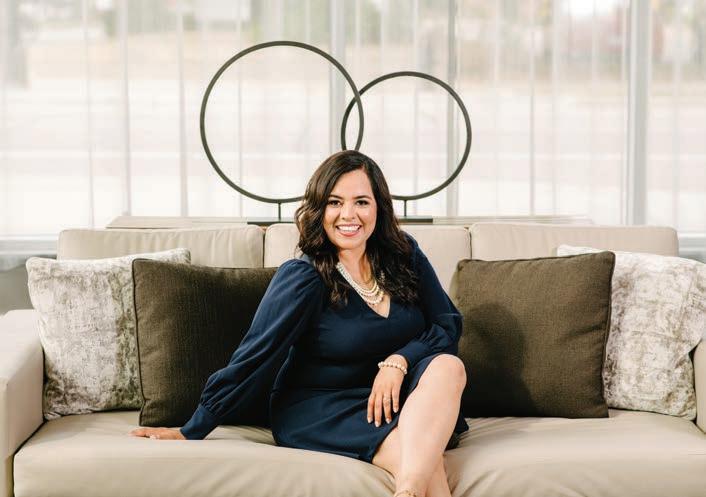
BY EMILY MCCLUHAN
When Margarita Avila was 14 years old, her parents moved her from Mexico to Madison to live with her older brother while they stayed behind to run their family-owned grocery store. Her parents wanted Avila to learn English and obtain a better education. Although their life in Mexico was stable, they believed the opportunities for their daughter in the U.S. were more abundant than what was in their Mexican community.
Navigating a new language, education and health care systems, and figuring out basics like opening a bank account, built a foundation of resiliency in Avila. But it’s the mentors along the way who helped her build self-confidence and access resources while attending James Madison Memorial High School, which put her on the path to Wisconsin Lutheran College. Currently, she’s the director of workforce development at Madison’s Latino Academy for Workforce Development. The academy provides bilingual, adult education programming, skills training and workforce development support and trainings.
As a first-generation immigrant, Avila says the networking opportunities and doors her mentors opened for her were crucial to her success through high school and college. Now, she’s using her connections as she guides students at the academy.
“Because I am a minority, I can relate with the situations that our students face in finding a job, because they don’t have that established professional community. They don’t have family [members] that know someone to make those connections.”
In Avila’s experience, a mentor relationship is often organic, especially when you meet someone who has traveled a similar path as you. Avila found this type of mentor early in her college days when she met Azure’De Williams, a fellow woman of color who helped Avila build her confidence while quickly becoming her mentor and friend. The two worked together at an afterschool program through Wisconsin Lutheran College that helped connect underserved youth with secondary education options.
“If a mentor is a friend, they need to be direct while providing constructive feedback,” she points out. “And if things don’t go as planned, they need to help you analyze why and how to do things differently next time.”
Avila says Williams, who is now the executive director of the Milwaukee Area Health Education Center, was great at this and also helped her discover her passion: working with nonprofit organizations. Williams also sent her a job opportunity after graduation at the American Heart Association in Milwaukee as the multicultural initiatives coordinator and later she supported her in being promoted to director of multicultural initiatives. Although Avila thought she wasn’t qualified, Williams helped her craft her resume to see that she did have the skills for the position, and she was hired.
“It’s so hard to step out of our comfort zone, but a good mentor can help you see the potential that you might not see,” she says. “And that’s when you can grow, learn and have new experiences.”
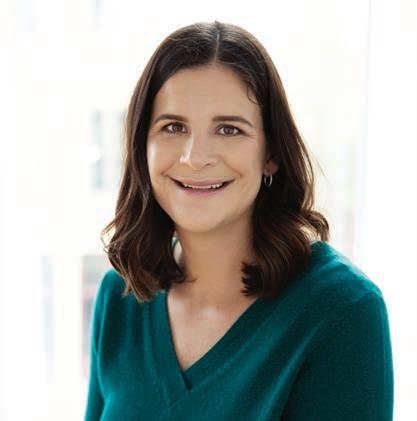
BY EMILY MCCLUHAN
Jeannie Cullen Schultz, co-president of JP Cullen, raises the blinds on her office door before settling back in at her desk.
“Having the blinds on my door is nice, because now I can just pump in my office,” says the mother of five, the youngest of whom were twins born in January. Her brother, who also works at the company, sometimes jabs at her about the blinds being closed. She shrugs and laughs, grateful for the privacy.
Dealing with situations like these is just one of the challenges Cullen Shultz faces in the male-dominated world of construction management. She admits that joining the family business (she and her brother, George, are the fifth generation in leadership, alongside six other family members) was not in her career plan when she was playing basketball at Dartmouth College.
“I thought I was going to be a college basketball coach,” she says. “But I eventually realized that if I was going to rise in the ranks of the coaching industry, I’d have to move every couple of years, and I knew I needed to be closer to my family.”
Not convinced that construction was
the right fit either, Cullen Schultz’s dad suggested she chat with other female leaders in the construction management industry. She says that hearing these women talk with pride about their family businesses and their teams helped open her eyes to the fact that she could have a successful career in construction as a woman, and it reminded her of her passion for basketball and coaching.
So, she finished her masters in educational leadership and policy analysis and started a masters in construction management at UW-Madison while she worked part-time at North American Mechanical Inc. (NAMI) as a project manager. Eventually she moved to JP Cullen and worked her way up from project manager to vice president of the health care division, leading the company’s projects for health care facilities across Wisconsin.
Cullen Schultz says that initially, being the only woman on a construction site or in a project meeting wasn’t the biggest challenge. It was that she was the youngest.
“Early on, even though I knew I still had
a lot to learn, I thought I could add value,” she says.
Continued on pg. 52
How have you been able to build a strong professional network?
Q“A few years ago, a colleague of mine and I assembled a group of ladies from the banking, real estate, design and construction industry. We meet once a month as a group and then often as individuals. Having this group of ladies has been incredible for me both personally and professionally. We support, challenge, look out for one another. I would highly encourage others to find this type of group and make sure that when you do, you maximize your time together and the diverse amount of talent that is in the room.”
– Jeannie Cullen Schultz
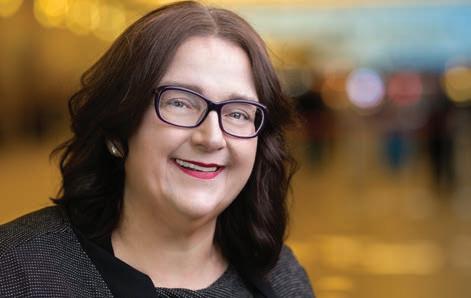
BY CANDICE WAGENER
Kim Jones has been known to wear headbands “with bobbly things on top” at work. They help her keep perspective, which is critical in her role as airport director at the Dane County Regional Airport (DCRA). Here, she manages 80 staff and oversees an average of 250 airplane departures per week and overall operations for 3,000 acres of land shared between civil and military services.
Beyond the everyday challenges of running a small-hub airport, Jones is also at the helm of an $85 million expansion, as well as navigating concerns around PFAS contamination — also known as forever chemicals — and F-35 fighter jets. So, she dons the occasional fun hair accessory.
As early as high school, she had aspirations of becoming “an executive director somewhere in some place.” After a stint at the Des Moines International Airport, she realized opportunities for advancement were few and far between, so she took a position at the DCRA in 2004. She immediately fell in love with the airport, a passion which led to her promotion to airport director in 2018. “Airports have a way of getting into your blood,” says Jones, about her love of the job.
The airline industry was hit extra-hard during the pandemic. At one point in April 2020, Condé Nast Traveler reported that U.S. air passenger traffic
was down by a staggering 95% from the year prior. With 60% of DCRA’s pre-COVID passengers considered as “business travelers,” the airport has yet to see a complete rebound from the recent uptick nationally in leisure travel.
Reflecting on that bleak amount of foot traffic during the pandemic, Jones viewed it as an opportunity to perform necessary maintenance tasks and continue expansion plans. And while many industries switched to working remotely, that’s not really feasible for airport staff.
“Whether you have 62 people or 3,000 people [coming through the airport daily], you need to have restrooms cleaned, floors cleaned. Plus, now they need to be sanitized in ways they never had been before … it’s very difficult to do a lot of the things we do from home,” says Jones. “My thought and philosophy on that was if my staff was here working, I’m going to be here working as well.”
Looking ahead, Jones has a firm belief that all travel through DCRA will bounce back to beyond what it was before, as more people feel compelled to seize the opportunity while they can. She and her team have been working to increase the presence of DCRA, getting out in the community and reestablishing relationships with local business partners, including Destination Madison and the Greater Madison
Chamber of Commerce.
And Jones has made it her mission that DCRA be top of mind for more travelers, which is why she’s excited for the updated, expanded airport, which will also enhance accessibility for everyone. She compliments her team on staying positive and being forward-thinking. The philosophy she has used to drive her team during these challenging times seems to have stuck.
“The present will be the past within 24 hours, so let’s keep looking forward.”
How have you been able to achieve a work-life balance that works for you?
Q“I think we have to be realistic that work-life balance is always going to be just that: a balancing act. There are times when things at work are going to be more important from a time expenditure standpoint — but your family always comes first. There are times when your family can function and you need to spend a little more time at your job. [And] there will be other times when your family needs more of your time. Whether it’s for 10 minutes or 10 hours, you have to be able to turn off the work when you come home.”
– Kim Jones
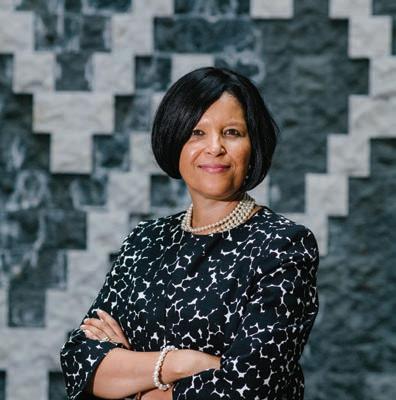
BY KATY MACEK
Leslie Petty may be an assistant dean at the UW-Madison School of Business, but her reach and responsibilities extend much further than the institution.
Petty oversees their three MBA programs, as well as all student services (from orientation to graduation), technology operations management, career services and admissions in the School of Business.
How does she handle it all? It begins and
ends with motivation — for herself and the various teams she oversees.“You have to have a collective vision of goals and objectives; that is key,” Petty says. “And I do believe you must be mission-driven.”
And her team’s mission is also her motivation: providing a holistic education experience to students. That’s the backbone of the departments she oversees.
“What drives me to come to work every day and be a part of this [university] are my
students,” she says. “I understand the power of education, and how it advances the economic development in our community.”
She credits her upbringing to her strong, single mother raising herself and her four brothers in the inner city of West Philadelphia as one of her main influences. Her childhood gave her an “unwavering sense of self-belief and cando spirit,” she says, which has been vital to her success.
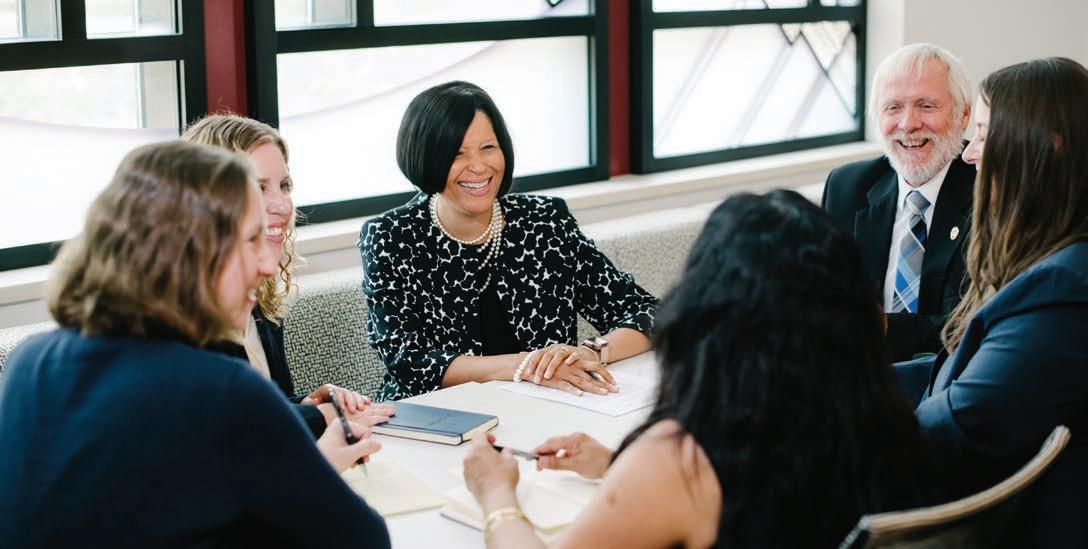
Seeing the lifestyle of those around her in West Philadelphia made Petty realize it wasn’t what she wanted for her own family. So she worked her way up, becoming the highest-ranking Black female administrator at the School of Business, and the first to hold that title.
“I wanted to be in a position where I could pay it forward,” she says. “That’s why I do what I do — to make a difference in the lives of youth in our community.”
She instills that motivation in the hearts of her whole team by creating a culture that is constantly fueled by their mission to provide quality education.
Motivating others, she says, starts with living the mission yourself.
“We have to have a collective agreement,” Petty says. “They have to see me do it, they have to see my boss do it. It has to be that lived experience.”
Part of that is also being what Petty calls a “servant leader.” She allows her staff to feel empowered to lead in the areas they
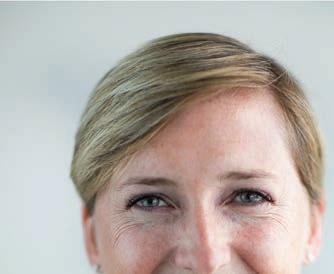
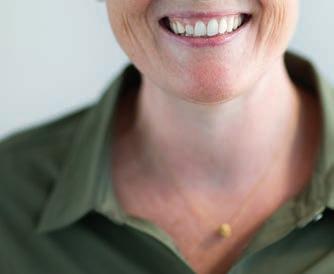



have expertise in, while she supports them.
“I do not lead by having followers behind me,” she says. “I lead by standing behind the talent, the skills, the folks who are experts in their area. I work behind my team.”
She also thinks it’s important to be an authentic leader, which instills credibility. For Petty, that means “what you see is what you get.” She chooses to lead in a way that allows her colleagues to get to know the real her, which she thinks allows them to open up and thrive as their best selves, too.
She motivates her team by empowering them with the tools and resources they need to succeed in their mission, which includes professional and personal development trainings that she also partakes in. However, Petty says the most important tool to motivating a team is creating a support system and a culture where it is OK to fail.
“I give permission to take risks,” she
says. “It is so important to know that successful people fail in life, and when that happens, we grow from it.”
QAre there habits you’ve created to streamline your day or better manage your time?
“To manage the demands of work, family and community service, I will build in a fiveminute mindfulness meditation throughout the day. This practice helps me reach a level of peak performance in my work.”
What would you tell your 20-year-old self?
“Trust yourself, don’t base your worth on someone else, and take risks.”
– Leslie Petty
At RBC Wealth Management, we believe diversity and inclusion are an engine for innovation, progress and economic prosperity. Through a diverse workforce, we develop ideas and people, and we feel an inclusive environment creates opportunities that empower people to grow and achieve more.
Beth Norman Managing Director – Financial Advisor Senior Portfolio Manager – Portfolio Focus
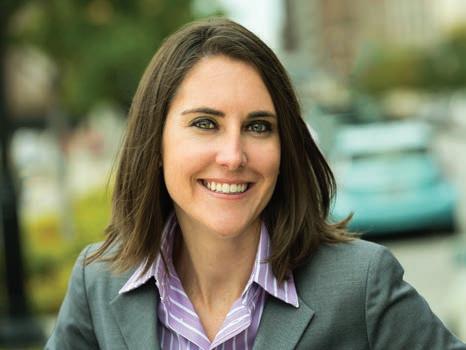
BY KATY MACEK
One of Megan Watt’s main sources of success isn’t a secret at all — she plays to her strengths, and one of those is teaching others how to play to theirs.
Watt is the founder of Dream Catalyst Labs in Madison and is a learning program manager for Exact Sciences — plus she occasionally does public speaking.
“My plans have shifted,” she says, noting that while she had planned on remaining with Dream Catalyst, she realized the frequent travel it required wasn’t sustainable for her long-term. So, she opted to return to working for an employer. “How I view and what I care about as ‘success’ has changed — but I still rely on my strengths to carry me through.”
So, how can you start playing to your own strengths? Watt has a certified formula: knowledge + natural talent + skills = strength.
We’ll let her explain more.
Watt says it all starts with “recognizing the talents you were born with and being aware of those gifts that you have and cultivating those.”
To do this, think about things you’re good at, and don’t be shy. She recommends asking close friends and family this question to get another perspective.
“Strengths often bring you joy or satisfaction,” she says. “You can come alive, get into flow — those are signs that it’s a strength.”
Make note of these things.
After you’ve listed your strengths, it’s time to think about how best to use them. Watt suggests really digging in here. Think about what else is important to you, but also get to know your values and how your strengths align with those.
For example, if one of your strengths is succinct writing, you might decide to use that strength to pursue a career in copywriting for a marketing firm or social media marketing.
The discovery phase is all about figuring out how your strengths and values can align, so you can take action.
Now, it’s time to put everything together.
Watt suggests incorporating your strengths into your daily schedule. If a strength of yours is connecting easily with others, think of what that could look like on an everyday basis. For example, maybe you could reach out to someone in your network once a week for coffee.
“Engagement is critical,” she says. “Our happiness really comes from engaging in strengths.”
Finally, it’s important to lean into your network.
“Eighty percent of what you need to accomplish any goal exists in your current network,” Watt says. “You just have to ask for it.”
Leverage your network to help you
achieve your goals. Finding a partner or a group of people who can pool their strengths toward similar end goals is a great tool.
“Nothing is done alone,” Watt says. “It’s often done with at least one other support person, if not a tribe of people. We are social beings, and we need that to accomplish goals and thrive.”
While your core strengths will likely remain the same, Watt says circumstantial and environmental changes may affect which of your top strengths are most prominent at any given time.
“You circle through your top six to 10 strengths on a daily basis,” she says. “Depending what capacity you’re in, it might change which of your top strengths come out, but there’s not going to be a huge shift.”
That doesn’t mean life won’t still throw challenges your way. But, Watt says, that just makes it more important to lean on your strengths to get through tough times.
“It’s important not to give up on yourself,” Watt says. “You might end up in a different place than you thought and you have to be open to success coming in different packages. Know that [success and happiness] pan out in different ways.”
What would you tell your 20-yearold self?
“Relax and enjoy the moment.”
– Megan Watt

BY MASON BRAASCH
Molly Moran always knew that she wanted to own a business, and after years of working in the restaurant and wine industries at local establishments including Eldorado Grill and Johnny Delmonico’s, she opened Table Wine in 2015. Located in the Schenk-Atwood neighborhood where she lives, Table Wine was established as a place of community, where locals often gather for wine tastings, happy hours and socials.
However, when the COVID-19 pandemic happened, Moran’s business changed overnight. Although wine was in demand throughout the quarantine, she was faced with navigating new challenges as a small business owner.
“Prior to 2020, it was always super important to me that Table Wine be a gathering spot … that there be spaces for people to kind of come and hang out,” she says. “[But] pretty much overnight, we became like an Amazon fulfillment warehouse, and we quickly switched to online ordering. And so it became like a completely different business.”
Table Wine has remained open during the pandemic. When Moran reflects upon her experience, as well as past bouts of adversity throughout her career as an entrepreneur, she explains that the key to facing tough times is to remember your “why”and take time away from work, even briefly, to clear your mind.
“The thing that has worked the best [for
me] is leaving work at work, as best that [I] can,” she says. “I try to carve out some space for myself. A quick walk around the neighborhood can help clear your mind. And you can see things when you’re facing adversity and can be more creative.”
Moran sets moments aside for a short meditation, a gratitude practice or time spent with family. These methods have allowed her to sustain the creativity that drew her to entrepreneurship, and work through challenging periods.
“What I’ve learned over the last fiveplus years is that people are drawn to entrepreneurship because there’s a creative energy to it that is really rewarding and wonderful,” Moran says, “and then you kind of get bogged down [with] things like the bookkeeping and the daily operations, particularly during those adverse times. A simple 10-minute meditation, or having dinner with my kid or doing something else for a little while helps me.”
Moran explains that for now, Table Wine is still in a “hybrid state,” open to in-person browsing as well as online ordering. Moran plans to bring back in-person events, but she’s not sure when that will be yet. And she still hosts virtual wine tastings (details can be found on Table Wine’s website).
As things slowly shift back to a place of normalcy for her business, Moran explains that she is excited to experience her why again — the gathering of her community over great, affordable wine.
What are three skills that are essential to being an entrepreneur?
Q“Resilience. Being able to get back up is key. [Having] some sort of self-sustaining energy; something that drives you within yourself … I think that looks different for different people, but [it’s] something that keeps you getting up and going in the morning. [And] I really do think creativity [is important]. I think that the best entrepreneurs are the ones who are creative in some capacity.”
Are there habits you’ve created to streamline your day or better manage your time?
“Pretty early on, I started a daily meditation practice. And I think that’s gotten me through everything. I think that maybe I don’t see things as adversity that … other people would. I [also] started a gratitude practice a couple of years ago, and it totally changed my life. I know that for some people, it doesn’t necessarily work. But for me, it really did help me get through the last year.”
– Molly Moran
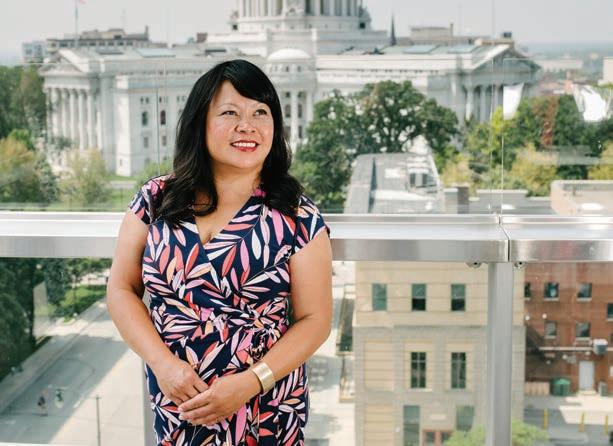
BY MASON BRAASCH
For Tu Le, finding work-life balance was not always a priority. Today, however, it is essential for her because it means more valuable time with her children, as well as more moments she can devote to herself.
In her mid-30s, Le, who was working as a fashion designer at the time, made two big decisions: The first was to move from New Jersey to Madison for a job at Lands’ End. Then after working for more than 20 years in apparel design (with brands such as Liz Claiborne, Gap and Lands’ End), Le switched career fields and became a realtor. The job offers her more flexibility and less time behind a desk, which also allows her to be present with her children.
“[When] I switched careers ... it was scary to do that, but I’m so glad that I did. It’s important to find a job that satisfies you and is rewarding,” says Le.
Now, she spends more time with her children, Kai, 17; Tru, 15; Hanna, 15; and Ellie, 12. Le takes them to events and museums in Madison and uses their time together to discuss important topics and movements — such as attending the Stop Asian Hate March on State Street earlier this year. As a mother, she says that it’s important to her that she exposes her children to as much as she can.
While family is definitely a priority for Le, she’s also come to discover that work-life balance means more than simply being a mom outside of work; it includes self-care as well. Le explains that in her past life as a fashion designer, she struggled with the idea of taking time for herself, citing the guilt that many career
women and moms feel when taking alone time. But Le realized that taking time for herself would not only make her a better mom and realtor, it would help her feel happier overall. By allowing herself to take small breaks throughout the day and utilize her flexible schedule, Le has created a routine where she can do things that bring her joy.
“You generally get to a more peaceful place when you take priority in your own life,” she says.
Le has taken up tennis and Spanish classical guitar in her free time, but explains that alone time can be as simple as getting a cup of coffee, walking around the city or sitting in a park. She also describes Madison as the perfect setting for achieving worklife balance.
“What’s great about Madison is that people here do a better job of embracing what’s here and what’s available to us,” Le says. “There were times when I was very limited with my resources as I had career or life changes, and I figured out that there’s tons of free events here in Madison that you can go and enjoy, and it’s just for a couple hours a day.”
Through all of her life challenges — a demanding job, a divorce, a career change — Le explains that learning to accept herself and making self-care a priority has changed her life significantly.
“I am completely happy,” she says, “I’m at the point where I do say to people if I were to die tomorrow, I want to make sure I live without any regrets. I’m completely happy with what I’ve done so far.”


QWhat advice would you give your 20-yearold self?
“People always say ‘I want to be 20 again.’ I don’t, because I was so hard on myself in my 20s! I was finishing up school or starting off in college, and I couldn’t decide [what I wanted to do]. I thought I was going to make this major mistake in my life if I took the wrong path. And I think I would have said that it’s OK to do that, you know, go down the wrong path, and then just steer yourself into the right way and to go enjoy life.”
What would you say to people who are struggling with finding work-life balance?
“I would say reevaluate the job that you have. Is it giving you that flexibility? Negotiate with your current [employer by] saying hey, ‘I’ll give up a little bit of my salary for more vacation time.’ Or, ‘I’d like to split up my salary so every other Friday I get a half-day.’ Or, ‘Every Friday I work from home so that I can get rid of that commute time and do something just for myself.’”
– Tu Le
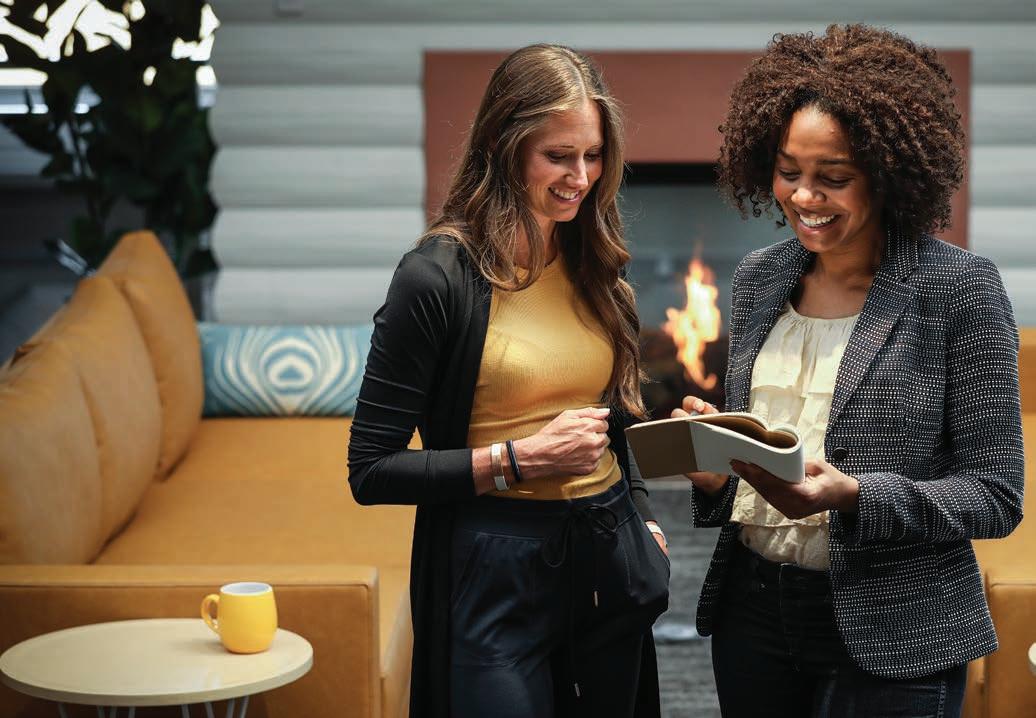

BY CANDICE WAGENER
Camille Carter, president and CEO of the Madison Black Chamber of Commerce, laughs a bit when I ask if she had any hesitation in taking on her role.
As an experienced entrepreneur with a financial services agency, Carter joined the chamber board in 2015, and was asked to take over completely a few years later.
“There was 100% hesitation, but we know the end of the story,” says Carter. “This was not an allocated career path for me, but you know, life has its twists and turns. We follow our trajectory.”
Carter is certainly on the right trajectory. She’s grown chamber membership from 300 to 550-plus businesses (and counting) and opened the Madison Black Chamber of Commerce’s first office space (at 618 S. Park St.) during her four-year tenure.
Carter refers to the pandemic as a “market-maker” for Black-owned businesses.
“Many businesses did close their doors,
unfortunately, but many of them opened during the pandemic,” says Carter, adding that many Black-owned businesses have traditionally launched with lean or nonexistent funding. “So they show ingenuity when it comes to reinventing and recreating themselves and pivoting, and we are really seeing those characteristics at play. Despite [everything], they have found ways to remain relevant and resilient.”
Carter is happy to see the growing momentum in supporting Black-owned businesses, and her overarching goal is to help them continue to thrive for years to come. She does that through advocacy at the local, state and national levels — as well as organizing various events through the chamber like a Black History Month promotion in February and their annual fundraising event in May. And this past August, the chamber sponsored the sixth annual Black Restaurant Week, promoting nearly 50 food-service industry businesses
owned by people of color within the Madison and Dane County area. Plus, they host regular webinars lunch-andlearns and networking events for their members, which have been virtual for the interim, but will hopefully transition back to in-person soon.
Aside from partnering with the chamber, Carter advises businesses to do their research and build a solid business plan, as well as a strong network of support. “Great businesses are not built in isolation,” says Carter, stressing the importance of connecting with essential resources like an attorney and accountant. “Leaning into your local chamber and getting connected with networks, resources and opportunities — letting them know you’re out there, you’re available, who you are and what you do. You need to be as vocal and forthcoming as possible to allow businesses to engage with you.”
Joining professional organizations like Prospanica, a group for Hispanic business leaders, and the Urban League Young Professionals group have also helped Avila network with potential mentors and hone her own mentoring skills. She says the investment in these groups pays off in the long run through job opportunities
and building her confidence to dream bigger. It’s also created a support system of mentors and friends.
That support system is what gives Avila the motivation to mentor other minority and immigrant students: “I want to make sure that I return what I’ve learned back to my community.”

Continued from pg. 43
“But sometimes when you’re the least experienced person in the room, you have to say something multiple times or say it in different terms in order to communicate most effectively.”
She navigated this and the current challenge of often being the lone woman at the table by being over-prepared.
“If I don’t have everything I need to speak in a meeting, or I’m not confident I’ll get support for an idea, I’ll ask my peers and team for their thoughts to generate support and make sure I’m going down the right path.”
And with more experience under her belt now, Cullen Schultz uses being the only woman to her advantage. She says
What would you tell your 20-year-old self?
“To have the tough conversations. I had a great basketball experience [in college], but I kind of got the runaround from my coach because she
Qas someone who is quieter and takes a bit longer to build a relationship, standing out as the only female at a meeting, job site or client dinner makes her memorable.
“Don’t get me wrong, I want to continue to attract women into our industry,” she says. “Being a woman, you bring a different perspective to this maledominated profession, and I feel like our guys here are listening and seeing that more than ever before.”
She notes that two of their three recent hires were women, and she was able to build the number of women in her health care division to 25% over the last 10 years.
The sense of pride shared by those women leaders she originally spoke to years ago is
didn’t like to have the tough conversations. If I didn’t like the way she was coaching me, or she didn’t like the way I was responding, we just kind of tiptoed around things. Now I know that conversations can
How have you been able to achieve a work-life balance that works for you?
Q“I really believe that what you put in your body matters, so eating healthy is important to me. It’s a struggle, [but] if you’re healthy and you stay active, you’re going to have more energy and [get more done every] day. Another important practice that I started during the pandemic was meditation. I wish I would have learned more about meditation sooner! It’s helped me to be more present because we have so many things going on. It helps me focus and center on the moment.”
– Margarita Avila
what drives Cullen Schultz every day, and she hopes that pride continues to draw other women to the construction industry.
“I’ve learned with my time at NAMI and my time here at [JP] Cullen that the construction industry is pretty special. You get to be a part of building buildings that communities use. You need them when you’re sick, you need them when you need to go to school or work. It’s pretty cool to be able to be a part of that and see it come to life everyday.”
be hard and you can stress yourself out about them and overthink it, but gosh, once you have that tough conversation, it’s over and we can all move on.”
– Jeannie Cullen Schultz
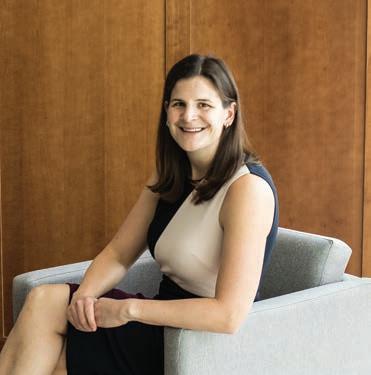
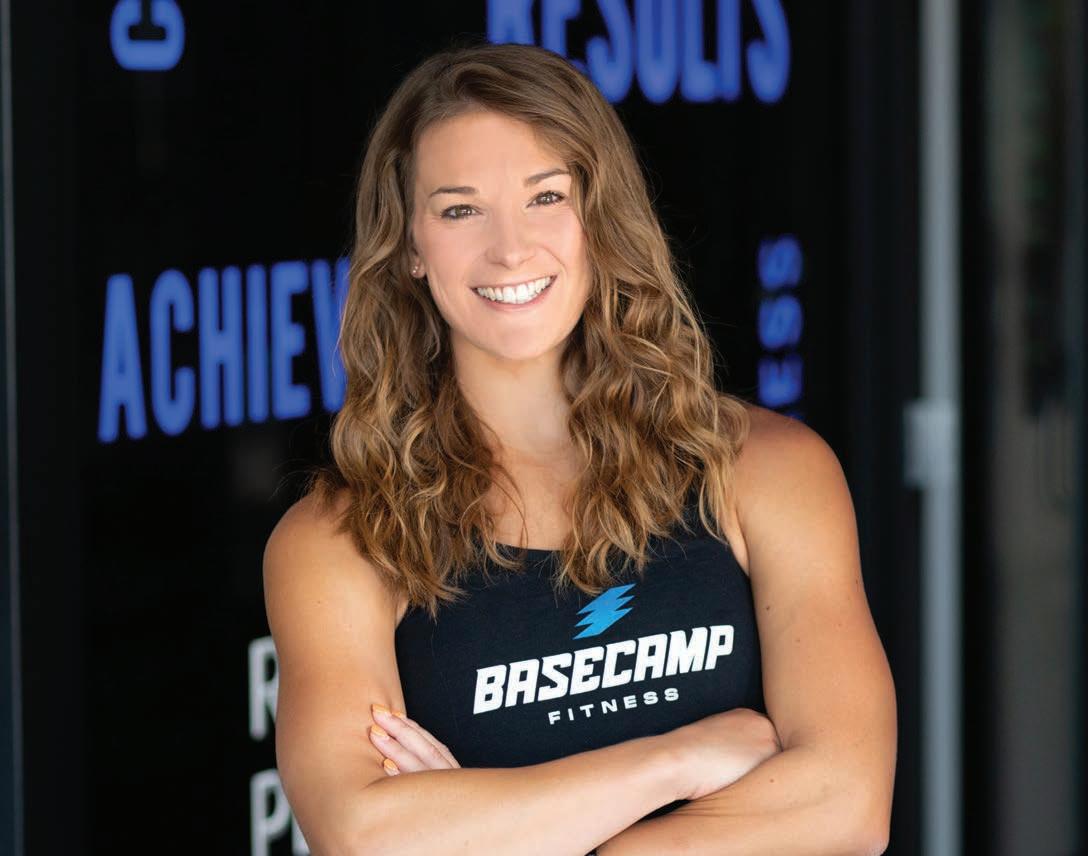
“Yes. You. Can,” is a mantra members at Basecamp Fitness hear regularly when coach Taylor Westrick takes the mic for class. Having coaches’ motivation, instruction and accountability to complete the 35-minute, high-intensity cardio and strength workout is what makes Basecamp so popular, and Westrick is a favorite amongst members. She instills self-confidence and positivity with every workout.
BASECAMP FITNESS
East: 4704 E. Washington Ave., Madison
608.960.4000
Central: 1730 Monroe St., Madison
608.960.4500
West: 309 Junction Rd., Madison
608.716.3700
basecampfitness.com
Being active has been part of Westrick’s life since a young age when she started gymnastics at seven years old. After finishing college on her school’s gymnastics team, she knew working in the fitness industry was where she belonged. “People are busier than ever these days,” explains Westrick, “but our health has never been more important.” She feels honored to help members uncover their stronger, healthier selves with each workout.
“The Basecamp Fitness workout, culture, community – it’s electric. The energy during class motivates you to be your very best on that particular day,” says Westrick. “I can honestly say my team and I love what we do every single day because of our members and the support we give each other.”
Westrick is the area manager for the three Madison-area Basecamp Fitness locations, located on Junction Road, Monroe Street and East Washington Avenue.
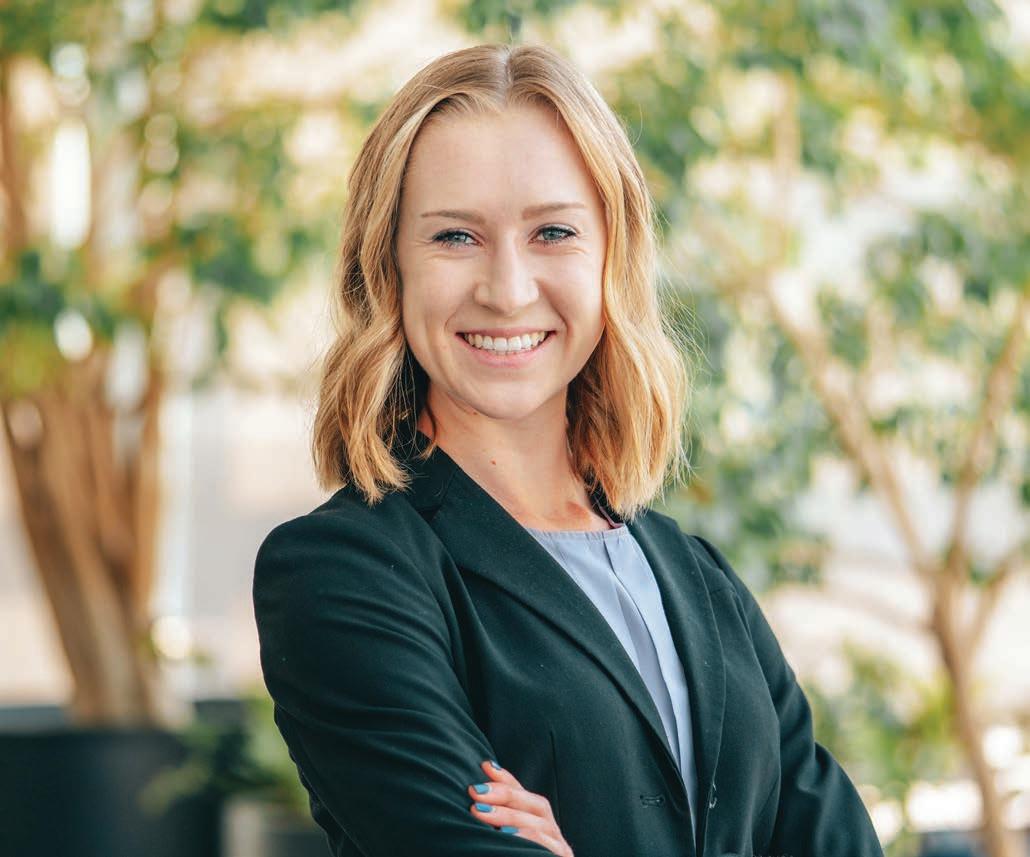
Quick-thinking, determined and always reasoned, Boardman Clark Attorney Sarah Horner possesses many of the characteristics you might expect of a successful trial lawyer. Her approach to her role, however, might come as a refreshing surprise.
“I became a lawyer because I wanted to make a meaningful impact in people’s lives,” she says. “Connecting with people to help solve their real-world problems is really inspiring.”
In her practice, Sarah works in the area of civil litigation, which involves counseling individuals and businesses through disputes in court. Her focus is on working with franchises and dealerships on matters such as termination rights, fair pay for warranty work and consumer law issues.
BOARDMAN CLARK Madison, WI 608.257.9521
shorner@boardmanclark.com boardmanclark.com
Outside her core legal work, Sarah finds other ways to make an impact. She is a standout member of the firm’s IDEA Group (IDEA stands for Inclusion, Diversity, Equity and Action) and co-chairs the group’s law student outreach efforts. She also mentors the firm’s clerks, serves on the Literacy Network’s Board of Directors and volunteers through the Madison Magnet Community Involvement Committee.
“Boardman Clark has supported my goals every step of the way,” she adds. “I love being surrounded by peers who challenge me to think big — at Boardman Clark, I feel like I can make the positive impact I was hoping for as an attorney.”


DANE COUNTY SHERIFF’S OFFICE
115 W. Doty St. Madison, WI 53703
608.284.6174
teamdane.com
30x30initiative.org
Women have been significantly under-represented in policing since the profession’s founding. Research shows that women officers, on average, rely less on physical force, more on communication and respond more effectively to violence against women. It’s simple: In order to serve and represent our community more effectively, we need more women officers.
At the Dane County Sheriff’s Office, women represent 22% of all sworn employees, 10% higher than the national average, but still lower than the percentage of women in the communities we serve. In an effort to increase the amount of women in law enforcement, the Dane County Sheriff’s Office has signed the 30x30 Pledge. Through decades of research, the Policing Project at the NYU School of Law created the 30x30 Initiative with the goal of increasing the representation of women in police recruit classes to 30% by 2030, and to ensure police policies and culture intentionally support the success of qualified women officers throughout their careers.
With the help and direction of the 30x30 Initiative, the Dane County Sheriff’s Office is dedicated to improving internal culture and implementing strategies and solutions to advance women in policing. The Sheriff’s Office offers competitive salaries, excellent benefits and time off, educational incentives and tremendous opportunity for career growth. For more information on employment opportunities, visit: teamdane.com or contact the DCSO Recruiter, Deputy Carrie Tobias at Tobias.Carrie@danesheriff.com.





EXP REALTY LLC
Jo Ferraro Ferraro Real Estate Team
608.445.2287 requests@soldinmadison.com soldinmadison.com
Jo Ferraro and her team continue to outpace the market by leading with value and making a positive impact on the lives of their clients, families and communities while leading with excellence, experience and heart! Ferraro is endorsed by Barbara Corcoran, the real estate mogul on “Shark Tank” and says it’s an amazing honor and she is very grateful to have Corcoran’s wisdom and guidance in helping deliver the best experience for their clients!
“My motto is to persist without exception, lead with honesty, integrity and always be grateful and kind,” says Ferraro. The Ferraro Real Estate team currently has three office locations in McFarland, Waunakee and Stoughton. The Ferraro Real Estate Team has become the number one full service team in South Central Wisconsin by creating an amazing culture and leading with their team’s core values to provide exponential results and an amazing experience for their clients!
5 Star Client Review: “We couldn’t be more happy with our entire experience of buying and selling with Jo and her entire team! She and her team treat you more like family and truly go above and beyond in all they do.”
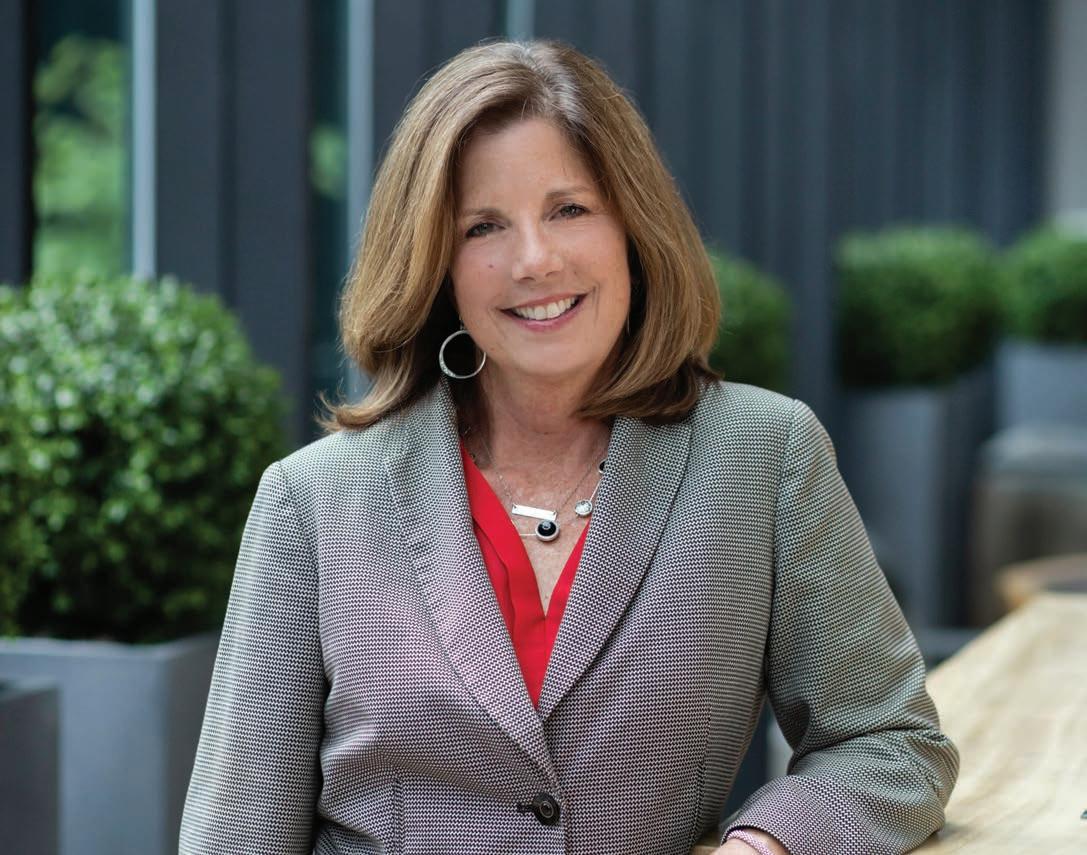
Sandy has been a part of the Northwestern Mutual family for over 20 years. Throughout her career, Sandy has held a multitude of leadership positions. Her efforts have contributed to what is now the largest, most diverse and most productive field force in the history of Northwestern Mutual.

NORTHWESTERN MUTUAL
1600 Aspen Commons Madison, WI 53562
608.836.3080
sandy.botcher@nm.com
What is your leadership philosophy? I approach leadership with a focus on humility, service, my people and our mission. Confidence is important but ego is cancerous. I don’t have to have all the answers. To truly win, I need the different perspectives, insights and collaboration of those who lead with me. The key to making that come to life is building relationships on a strong foundation of trust.
What excites you the most about your new role as managing partner in Middleton? I’ve had several leadership opportunities at NM in my 20 years. None of them excites me more than this one. I have spent years working in close partnership with the field, listening to what’s needed to be successful and then executing together in a collaborative way. I am excited to take what I have learned and put it into action with an already very strong leadership team in Middleton.
Northwestern Mutual is the marketing name for The Northwestern Mutual Life Insurance Company (NM) and its subsidiaries, Milwaukee, WI.
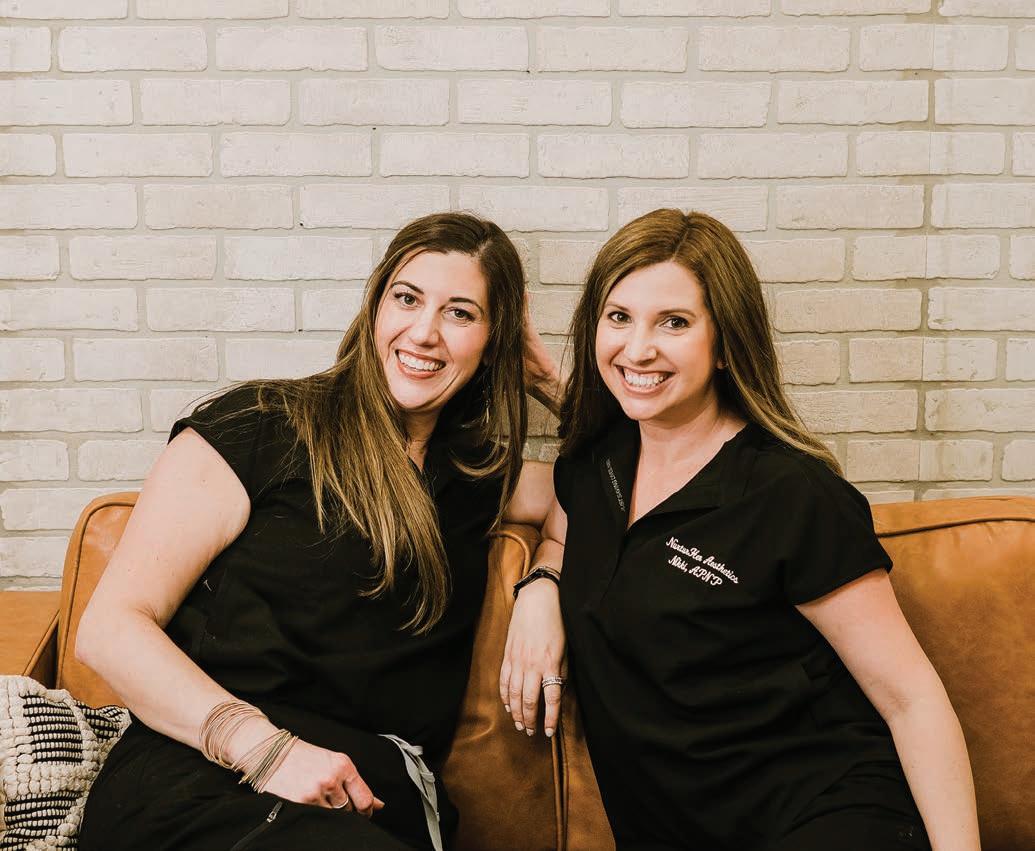
NurturHer Aesthetics is a medical beauty and wellness spa with providers that are advanced practice nurses who have both anesthesia and family medical training. Together we provide total body wellness services ranging from anti-aging to body contouring and weight loss.

NURTURHER AESTHETICS
Madison, WI
608.313.5627
nurturheraesthetic.com
We understand that each client is completely unique. For us, that forms the foundation of our honest, down-to-earth approach and emphasis on tasteful, natural and realistic take on aesthetics. We listen. We care. We work diligently to ensure everyone radiates health, wellbeing, happiness and reaches new levels of confidence. Our approach revolves around two principles:
#1 ALWAYS NATURAL
The goal is to look like yourself, only better. Our role is to enhance and restore. Refined assessment skills, sophisticated aesthetics and significant knowledge allow us to provide natural-looking results.
#2 NEVER NEGATIVE
We’re here to celebrate and nurture your inner beauty. Time may have had a negative effect — causing you to look tired or even sad. We will reverse this with empathy, understanding and enthusiasm. Work with us and you will face the day and the future with complete confidence and renewed optimism.
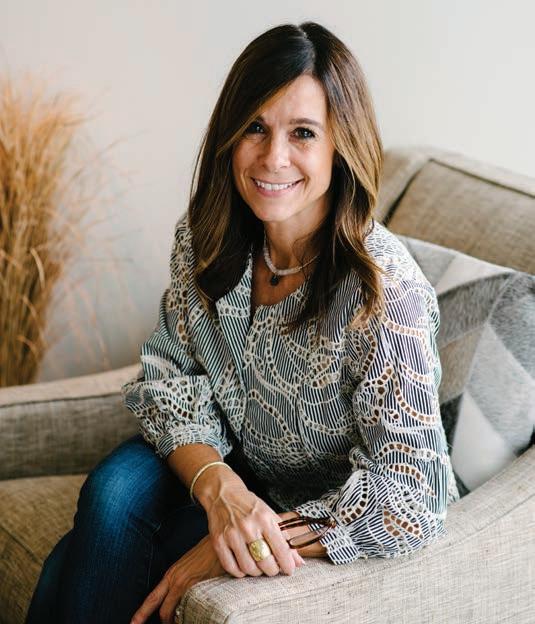
Brown & Beam is a locally owned interior design boutique and online retailer serving customers nationwide. A mixture of old and new, modern and traditional, urban and industrial, our furnishings defy definition. We pride ourselves on showcasing quality, sustainable items that support the makers who created them and go beyond the wares of big-box retailers. Our curated collections offer everything from the sense of discovery in a one-of-a-kind piece, to Community at Heart furnishings that give back, or finding the perfect fit with our custom line made in the USA. Shop online brownandbeam.com or work one-on-one with our stylists to create your unique space.
We offer a variety of services:
• Interior Design Services — starting at $150
• Convenient Online Shopping 24/7
• Monthly Warehouse Sales Events
BROWN & BEAM
2118 Eagle Dr. Middleton, WI 53562 608.833.2118 hello@brownandbeam.com www.brownandbeam.com
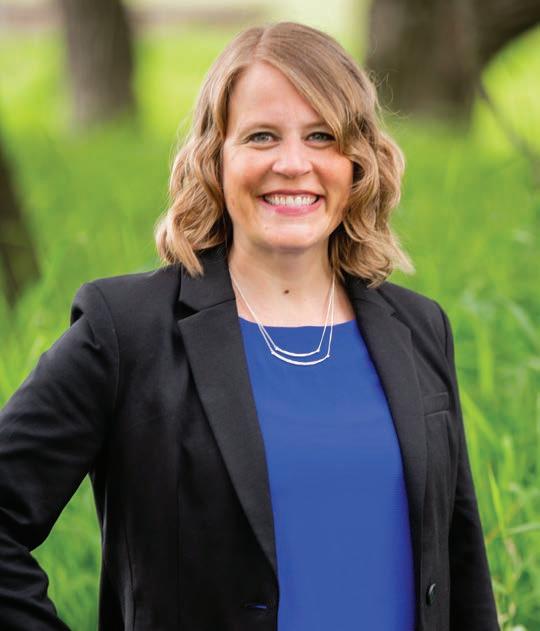
Krueger Hernandez & Thompson SC, located in Middleton, is ready for life’s challenges and is always here to protect you. Owner and attorney Stephanie Thompson proudly immerses herself in her clients and community. She develops tailored estate plans for your unique needs, family and goals while preserving your assets for future generations.
Performing the ultimate act of love as well as creating a solid plan secures one’s personal family’s future, protects your legacy and gives you real peace of mind. Thompson’s compassion assisting families is unlike any other. Her career has revolved around helping individuals, families and businesses.
We are Real Lawyers for Real People.
KRUEGER HERNANDEZ & THOMPSON SC
8215 Greenway Blvd. Ste. 590, Middleton, WI 53562 (608) 824-9540
stephanie@khtlawyers.com khtlawyers.com
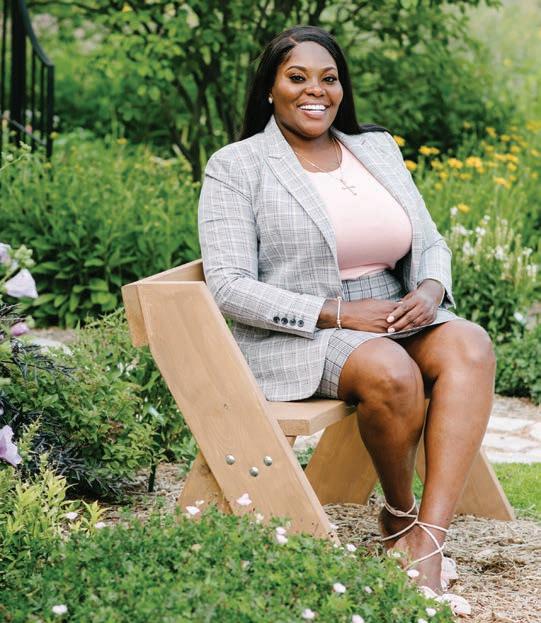
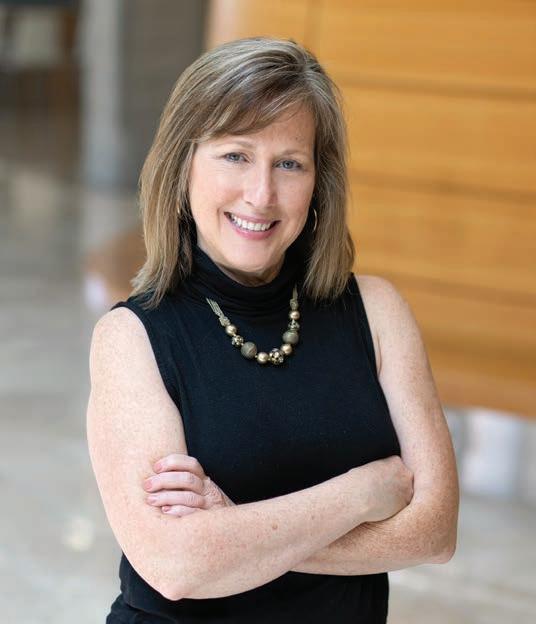
Pecku Anchored AFH offers respite care services, individual skill development services through county-based programs and operates an adult family home as a service provider for clients ages 18-85. Nicole serves a variety of clients such as those who have physical disabilities, developmental disabilities, mental illness and challenging behaviors. She meets the need of clients through a fundamental approach. Pecku Anchored AFH is there to assist with 24/7 in-home respite services. Nicole has earned a bachelor’s degree in health care along with obtaining several certificates in which she is trained within the supportive services that are needed to meet each client where they’re at.
ANCHORED AFH & RESPITE SERVICES
608.960.6761
nicole@peckuanchoredafh.com peckuanchoredafh.godaddysites.com

Interior designers have an awesome responsibility to their clients. At Laurie Driscoll Interiors, Inc. they take this responsibility very seriously.
Driscoll started her design firm over 32 years ago. She and her team have developed a business plan where they partner with their clients throughout the entire building or remodeling process. During this process clients have hundreds, if not thousands, of decisions to make. The intimidating reality for most people is when they realize that no decision is made in a vacuum, and each decision affects another. Driscoll and her team will partner with their clients to help them through the decision-making process, pulling all materials, finishes, furniture and details together to create an incredible, unique design solution.
As human beings we are all affected by our physical surroundings. If we love the spaces we live and work in, we are happier, we are more productive and we heal faster. This is an awesome responsibility for an interior designer.

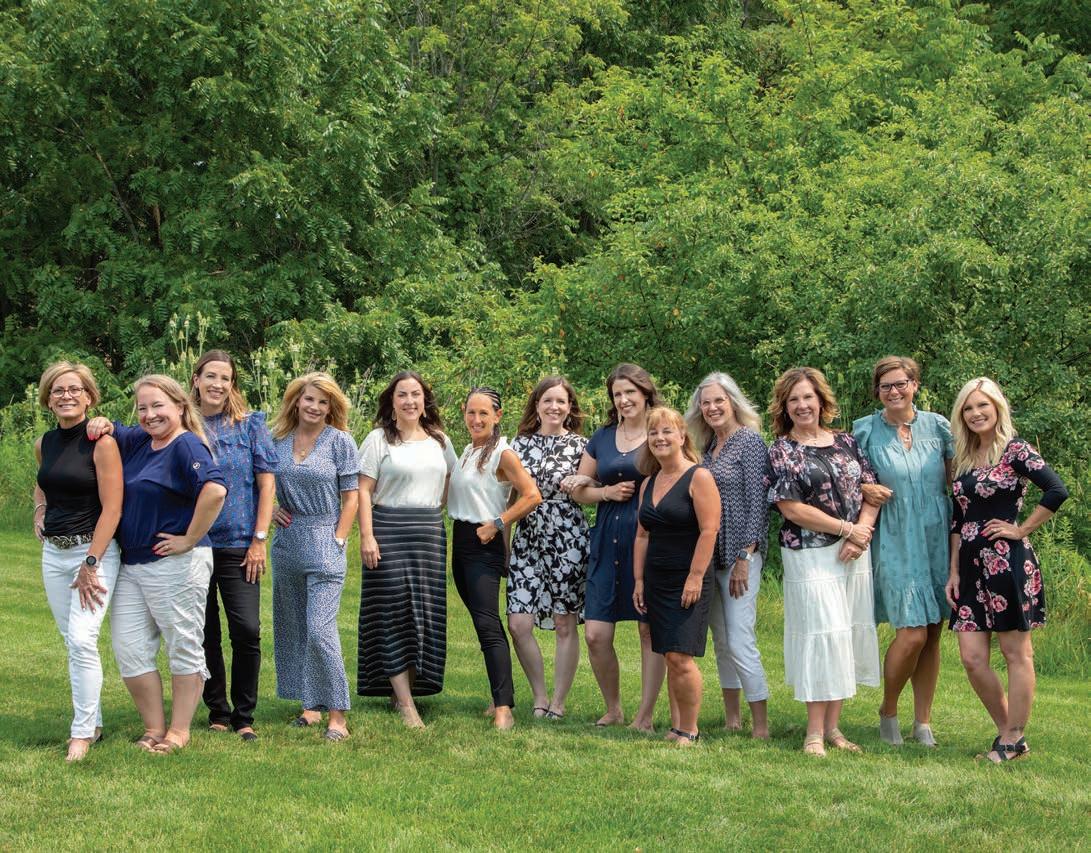
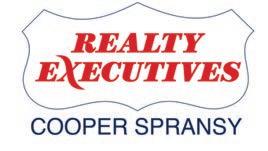
5940 Seminole Centre Ct., #310 Madison, WI 53711
608.661.7900
realtyexecutivescs.com
Confidence. Experienced. Professional.
Meet some of the strong women that make up Realty Executives Cooper Spransy (RECS). RECS started out as a small brokerage with fewer than 10 agents back in 2006. Fastforward to today, and 52 of the 81 agents are female! In 2020, nine out of the top 14 Realtors in the entire firm were female.
RECS supports teams and individual agents alike and has a strong culture that encourages women in their work/life balance. This is a unique business model that is truly paying off for RECS, the female agent and the clients they serve. This year, many of these female top producers have been asked to lead monthly sales meetings, coach and mentor the agents in the company as a way of building each other up and helping one another grow. In this collaborative environment, the agents can use these unparallelled resources and up-to-date market data to lead their clients to successful transactions in an otherwise tough market climate.
Are women thriving in a once male-dominated environment? You better believe it! And Realty Executives Cooper Spransy wouldn’t have it any other way. Contact one of these women today!

The loss of a child isn’t often talked about, and it’s the hardest thing a parent can go through. Four courageous women share their own stories of loss, and how they’ve been able to honor their child’s memory — and even find hope afterward.
BY SHAYNA MACE PHOTOGRAPHY BY HILLARY SCHAVE
When you become a parent, it’s an understatement to say your whole life changes. Thoughts shift from yourself to your child — keeping them fed, clothed, educated, entertained — and protected. Despite the fragility of babies and the constant “am I doing this parenting thing right?” question, we never quite stop worrying — even as our children get older.
Although it’s difficult to talk about, many of us have lost children, whether by miscarriage, stillbirth or the loss of an older child. This bring-us-to-our kneesgrief of child loss is not written about a whole lot. We wanted to shed light on this tremendous loss, so if you’ve experienced this, you don’t feel so alone.
Four extraordinary women who have experienced their own child losses shared their stories with us to reveal what they’re
going through — and the ripple effect grief has left in its wake.
But these women also share a commonality in their experiences: That hope can live alongside grief. And although life will never be the same for their families after their loss, the experience irrevocably altered the course of their lives in ways that they never could’ve expected.
The grief never changes; it’s always there. It just hurts less often.
Michelle Bauer is talking to me via video chat from her deck overlooking Lake Metonga in Crandon, where she and husband Jeff purchased a cabin in 2020.
She glances at a hummingbird in a nearby feeder and smiles. “It’s my little heaven up here,” she says.
It’s a welcome retreat for someone who has experienced what she has.
On Feb. 3, 2010, Michelle’s 13-yearold son Jesse died unexpectedly due to complications related to type 1 diabetes. Michelle, who was BRAVA’s marketing director at the time, was at a meeting an hour away when she received the call. She had spoken to Jesse that morning, and although he said he didn’t feel well, he assured her his blood sugar levels were normal. (Monitoring blood sugar levels several times a day is critical for those with diabetes, because diabetics can experience serious health complications if blood sugar levels are too low or high.)
Her middle child Jesse — who was diagnosed with type 1 diabetes at age

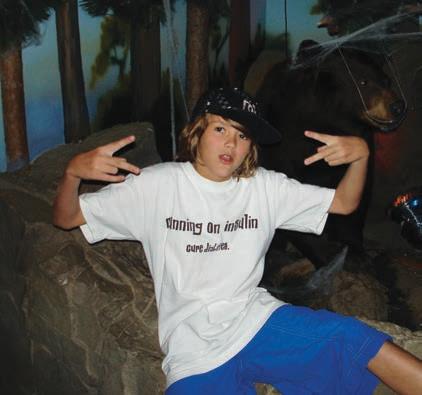
3 — was gone. He was her “chill kid, the one who was everybody’s friend.” He was goofy, an avid skater and snowboarder, and musically talented. Michelle’s face lights up as she proudly describes his wonderful qualities, more than 10 years later.
Jesse’s passing hit Michelle and her family like a ton of bricks. Although she and ex-husband Tom had joint custody of Jesse, his older sister Samantha, who was 16, and younger brother Joey, who was 9, they co-parented well. The strength of her and Tom’s relationship, even though they were divorced, was partially what buoyed Michelle during this difficult time.
“We decided we were going to be a united front. I think not everyone gets to say that through grief. I think a lot of marriages are destroyed when they lose a child, because one person grieves differently than the other; it’s very common. To find that unity was tough, but we found it … and we’re supportive of one another.”
After Jesse’s passing, even trivial moments were difficult for Michelle. A few weeks after his death, she ventured out for the first time to go grocery shopping, praying she wouldn’t see anyone she knew. While shopping, she walked past Crystal Light, and realized she didn’t need to buy the sugar-free powdered drink mix anymore, because no one in her home had type 1 diabetes besides Jesse. She burst into tears. Then she saw another shopper with a giggling two-year-old boy sitting in their cart. She looked around and thought: “How dare you not grieve for me? Don’t you know my son died? It was a horrible thought to look around and feel so much
pain and be so alone.”
Having two other children also experiencing grief compounded the family’s sense of loss. “I didn’t have the capacity to probably be the best parent I could be [to my other kids] at the time, because I had my own grief. But, I did my best,” says Michelle.
Her daughter Samantha “was angry at the world. And I don’t blame her. [Jesse] was her best friend.”
Son Joey blamed himself. Michelle says he even had a dream the night before Jesse’s passing of him disappearing. She says Joey is quiet and doesn’t talk about the loss of Jesse. “Everybody grieves differently; it’s true. I talk about [Jesse] all of the time, so that’s my way of healing. But you know what? My kids have turned out amazing, considering what they went through those first couple of years.”
As the former executive director of the Juvenile Diabetes Research Foundation (from 2006 to 2008), another difficulty Michelle faced was that she had to share with her friends, colleagues and community she’d built around diabetes awareness that her son passed away from the very disease that she had worked tirelessly to raise money for research and advocacy.
“When he passed away, not only would the people [in this community] wig out that it was going to happen to their kids, but I thought I was going to lose my community. Who’s going to want to talk to the mom whose kid died from the disease that they’re all still battling [with their kids]? I didn’t know what I was going to do with my life.”
Within weeks after Jesse died, Michelle started jotting down her thoughts about dealing with the death of her son with the intention of turning it into a book.
As a diabetes advocate and someone who experienced such a crushing loss, maybe she could help others going through her same situation. As the years passed, she’d occasionally pull out her writings and add more thoughts and feelings. She shopped her book idea to a few small publishers, but nothing came of it. Ten years went by.
In February 2020, Michelle was chatting with a friend who owns a small publishing house, and she mentioned her book. He loved the idea and encouraged her to finish it. The book, titled “Jesse Was Here: (More Lasagna Please),” was released in April 2020 and is a memoir of a mother dealing with her son’s death, and includes helpful takeaways for other parents who are going through the same experience.
In the years after Jesse’s death, Michelle also started a website called jesse-washere.org for grieving parents and family members to share their experiences, as well as resources. She’s spoken on TV and podcasts, runs a private Facebook group and has talked to to countless parents. Although it’s something she never wanted to experience, she has embraced the staggering weight of the death of her child and offers others a shoulder to cry on — because she’s been there too.
“You will see reminders of your loss everywhere. That is a harsh reality. During those first weeks without Jesse, I could barely get through Wednesdays, because Wednesdays were a stark reminder that my son had died a week ago, two weeks ago, three weeks ago. Now, Wednesday is just a Wednesday. The relief comes in small steps: one day, one week, one month at a time.”

You immediately become part of a club you never wanted to join.
Kristin Erickson has a big personality, and it’s easy to believe that without ever meeting her son, Sean, he probably did too. I know this because Erickson shows me video snippets on her phone of Sean exuberantly singing and joking around in class at McFarland High School, impersonating a teakettle and biting into a dill pickle with gusto before announcing, “it’s pickle time!”
“Sean loved nothing more than making people laugh,” says Erickson, laughing along today as she watches her son in his element. If an outsider walked into our conversation, they may think that after our lunch, she’d rush home to call Sean at his UW-Milwaukee dorm, where he was a freshman majoring in business. Except her call would go unanswered.
“Seanny,” as she affectionately calls him, “was loving life and getting incredible grades at college. He was thriving,” says Erickson. “Yet even kids at the top of their game make mistakes, and Sean did just that on the night of Feb. 13, 2020, when he decided to take LSD with a friend.”
That evening, his friend started feeling adverse effects from the drug, and Sean, worried, went to seek help. Then, knowing the trouble he would face at school, he left the dorm to wait until the drugs’ effects wore off and he could return and face the consequences. Erickson believes he went to a familiar place — across the street and under a bridge along the banks of the Milwaukee River where he and his friends often hung out. Thinking the ice covering the river was frozen solid, he stepped on it and fell through.
He sent a last, tragic text to Erickson and her husband, Mike Baek, moments earlier, which said: “I love you so f*cking much. I’m so f*cking sorry.” Though some may interpret his words as a suicide note, Erickson knows they were written
to apologize for his poor decision and the trouble at college he knew he’d soon face.
Not immediately knowing where Sean was after writing that text was excruciating for Erickson, Baek, and Sean’s brother, Brady, then 15. Sean had simply disappeared. The police searched for weeks and on March 31, 2020, Sean’s body was found in the river and was positively identified.
When the family finally learned what had happened to Sean, Erickson says another wave of grief hit her. “I actually went back into shock again, even though I was sure of what happened and was absolutely certain it was a tragic accident. Sean would have never taken his life or gone missing voluntarily.”
• • •
Though painful, and told with unflinching honesty (she wanted the details of his passing shared in this feature), she agreed to do so to set the record straight. His disappearance was covered heavily on the news, and she wants to warn parents of how prevalent drug use is on
campuses. Erickson says she’s always been very open with both of her sons.
“… I told them they could ask me anything, and promised to always tell them the truth. So, Sean and I had an open dialogue about drugs. He told me he was curious about acid and I begged him not to try it … But, Sean was always Sean. He listened and was respectful, but he made his own choices. And, this time, he paid the ultimate price.”
Looking back on the weeks after Sean went missing is still very painful. She doesn’t recall much in the weeks after Feb. 14, with the exception of an overwhelming outpouring of love from the McFarland community and others.
One friend who reached out immediately was Michelle Bauer, who worked for a number of years at the publishing company Erickson owned. (Erickson started BRAVA Magazine in 2003, and sold the company in 2009.) The women originally connected after Sean, like Bauer’s son, Jesse, was diagnosed with type 1 diabetes and Bauer reached out to offer support. It’s ironic they now share another connection with their sons’ passing.
“When I found out Jesse died in 2010, I was devastated. I remember thinking I could never survive a loss like that,” recalls Erickson. “Now, I’m in the same place. And one of the first people at my door to help was Michelle. Her strength and capacity to give is limitless.”
Erickson has experienced an unusual number of deaths in her life; many were untimely and unexpected. Yet one by one, she says, all of her loved ones contacted her to make sure she knew they were still there. After Sean’s passing, Erickson says psychic and medium Scotty Rorek increased her ability to communicate with her son tenfold, which brought her comfort. Yet she’s quick to say her goal in sharing this is not to make others believe.
This is not unusual. All of the women I talked to for this story said they regularly feel the presence of their child, either by speaking to them or seeing signs of them. Keeping Sean’s memory alive isn’t difficult for Erickson. She feels as if
he’s always with her. He also lives on in the countless iPhone snaps she shows me of him, and in the funny stories that his friends share with her when they visit.
On July 31, 2021, the family held a celebration of life for Sean at their home. (The agonizing delay of holding a celebration was, of course, because of COVID-19.) Erickson hosted food trucks and a combination of speakers and songs, including live remote performances by “Hamilton” lead Miguel Cervantes, Rosanne Cash and Raine Stern, a contestant on the most recent season of “The Voice.”
Erickson is also working on a book with Rorek about Sean’s afterlife experience, titled “Alive on Arrival.” The family is also establishing The Sean Baek Foundation which will donate money to various causes, including JDRF and hopefully, a scholarship at McFarland High School.
After sharing so much, Erickson has been composed the entire time we talk, which is surprising, especially given how recently Sean passed away. She says her ability to keep her emotions in check aren’t indicative of an absence of pain. Some days, she admits, are excruciating. But one moment cracks her composure. “I just wish I could hug him,” she says quietly, shrugging. Tears glisten in her eyes, and she pauses for several moments.
“Sean helped a lot of his friends because he listened. He was — I hate referring to him in the past tense — he is so compassionate and kind and caring. He made an important impact during his short life on earth.”
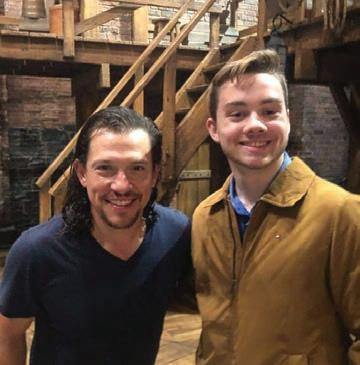
The women in this story shared advice on what they learned after their loss.
“The things I’d hear [talking to other parents] is that … everyone feels so guilty. [They say], ‘If I had done this differently, or, what if I had done that?’ I always say to people, if I said, ‘I wish I would’ve gotten to Jesse 15 minutes earlier — would you blame me?’ And they say, ‘Well, of course not.’ You say to yourself every day you would do anything to have your child back. But the guilt doesn’t help you at all.” — Michelle Bauer, author of “Jesse Was Here (More Lasagna Please),” who also runs a private Facebook group and founded jesse-was-here.org
“Know that grief doesn’t have a timeframe … and every day is going to be different. It’s how you choose to manage and look at your experience. If you are supporting someone who is in that space [of loss], sit there with them [and] help them on their journey — [but don’t] tell them what their journey should be.” — Felica Turner-Walton, who founded the nonprofit healingourhearts.net
“People are so afraid to reach out because they don’t know what to say. But you really don’t have to worry about what to say. [Just say,] ‘Hey, I’m here for you.’ Doing something for the person [is helpful] instead of asking what they need. I’ve had people say ‘Hey, are you home? I’m coming over and I’m going to do your laundry.’ And continuing to reach out is really helpful.” — Michelle Vande Hey, who owns Light of Love Coaching, a holistic life coaching business for grieving parents
“My community really wrapped their arms around us; it was so beautiful. I always have a hard time accepting help from people — I’d rather help someone than get help. But when people said, ‘Can we bring you meals?’ We said yes. And that saved us.” — Kristin Erickson, who is working on forthcoming book about her son Sean’s story
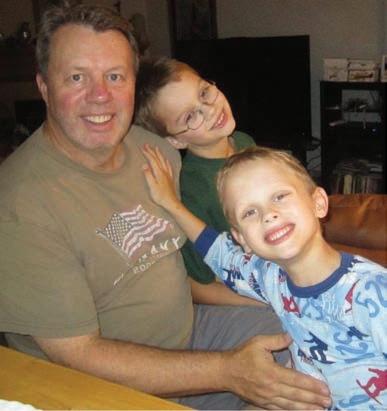

I don’t tell this story pretty; grief brings up unresolved trauma and emotions that you work so hard to avoid.
When Felica Turner-Walton’s son Zaire was born on Oct. 22, 2015, he was the perfect addition to her family of five. Son Jamarius (age 19 at the time), Markeria (age 16), Markavian (age 11) and Markayla (age 4), adored their baby brother. Somehow, having a baby just felt different this time around for Turner-Walton.
“He was one of those babies that [rarely] cried. He was ... this ray of sunshine; the energy in the room,” explains TurnerWalton, a soft smile on her face, her deep brown eyes joyful.
Named after the African country of Zaire and the Zaire River that flows through it (now called the Democratic Republic of the Congo and the Congo River, respectively) the idea of a flowing river, steady and consistent, appealed to
her. His name brings comfort to TurnerWalton every time she speaks it.
•
In March 2016, Turner-Walton brought Zaire in for his four-monthold vaccinations. Within 12 hours, he experienced an adverse reaction to the shots, and was placed on life support. Despite lifesaving measures, Zaire passed away at the American Family Children’s Hospital three days later.
While at the hospital, Turner-Walton remembers thinking, “If you need anybody, then take me, I’m here, I’ve lived … a bit of life. But he’s just four months, you know?” She continues, “So, I was really trying to bargain … giving myself up. Then trying to find acceptance, but then immediately going back to denial, like, ‘Oh, hell no, this is not what it is; I’m not going to accept this — I should have a choice in making this decision.’”
Turner-Walton never left his side the entire time he was there — and walked
He was … this ray of sunshine; the energy in the room.”
him to surgery after her family made the decision to pull him off of life support and donate his heart and liver.
She shows me her pendant necklace with Zaire’s ashes in it and tells me that two babies received his organs. “It gives me chills knowing that his organs went to other babies, with his name meaning what it does — always flowing [and giving life].”
Afterward, Turner-Walton struggled, particularly because she says Black grief is more complicated. She started reading about the Five Stages of Black Grief, coined by Dr. Stacy Scott of the Baby 1st Network. They include despair, self-blame, move to action, endurance and survival. According to Scott, self-blame looms large for Black women, who are expected to take care of their families. Often, Black families’ move to action is tackling the expenses of a loss, and the time off of work (and lack of paid time off) it entails. Endurance comes into play to be able to forge ahead, after the funeral is over and support drops off. And for Black people, survival can be “considered the new acceptance stage,” notes baby1stnetwork.org. “As a result, sadness, anger, and regret are a few emotions that may never totally diminish.”
Turner-Walton also had four other children to care for who were grieving, too.
“Being a single parent … it was like, ‘Wait — I had five children — now I’m down to four. How do I go back from that?’” she explains. “I was so afraid to love all of my children after losing him, because I was afraid that if I loved on them too much, that something would happen to them too.”
After she returned to work, she realized her employer didn’t quite know how to deal with her loss. Then, they demoted her to a customer service phone position two weeks after her return. She says employers may not think carefully about how a death in the family affects an employee — but they should.
In the aftermath of Zaire’s death, she started receiving uncanny calls from customers at work (Turner-Walton worked various positions in the utilities and insurance industries). One was from a mom who lost her child; another was from a wife who had lost her husband. Having such a recent loss, she was adept at talking to the women. But the anguish became too much for her to bear when she was still grieving herself.
During this time, after-work trips to Applebee’s were frequent so she could drink to forget her pain. Sometimes on her drive home she would hope she would get into a car accident or thought about drowning herself in a nearby lake.
Despite this, Turner-Walton knew she had a higher purpose, and couldn’t give in to her pain. She quit going to Applebee’s and threw herself into work. She applied to UW-Madison’s Odyssey Project (a program for low-income adults that gives them a jump-start at a college degree) and completed a six-credit course. After much
soul searching, she figured out what her true calling and purpose was: to help other moms and herself. She founded Healing Our Hearts, a nonprofit for grieving parents, in 2019.
The nonprofit offers culturallyappropriate trainings for workplaces and medical providers, as well as individual and group support. The services Healing Our Hearts provides directly stem from her own experiences and those of other mothers. Turner-Walton says her medical provider offered little to no follow-up in terms of grief resources; the support groups she looked into didn’t address the Black experience; and one of her employers didn’t know what to do for her.
It’s been a long journey for TurnerWalton, but she can credit it all back to Zaire, who, despite living such a short life, will forever be commemorated in her work.
“I can honestly say I don’t do this for me. I do this with other mothers, and it’s all about holding space for them. They don’t even know they’re helping me more.”





heart that James was their son. After his discharge, she started down the road of making multiple appointments for James’s special needs: occupational therapy, neurology, physical therapy. “Your life really becomes about helping [your child] thrive,” she says.
But then on Oct. 14, 2018, James never woke up. He died from SIDS (sudden infant death syndrome). Although he had special needs, Michelle says there wasn’t a particular underlying condition that would have caused his death. After dealing with so much in his short, three-month life, the family was heartbroken.
You lose who you are [when you lose a child]. And what we really need to do is embrace who we are now, because it completely changes you. I’m not a completely different person than I was before, but … I am different … and I’m really learning to love that part of myself.
Unlike the other women in this story, Michelle Vande Hey was not a stranger to familial child loss when she lost her own son, James, when he was three months old.
In 2016, Michelle’s sister and brother-in-law, Jennifer and Adam Schmidt, lost their seven-year-old son Rylan, who had significant special needs, when he died of pneumonia. For five years, Michelle was his primary daytime caretaker. Being so close to her nephew made Michelle feel the loss acutely.
In the years that followed, Michelle and her husband, Jarrod, looked to expand their family and adopt another baby (they already had daughter Abigail). In 2018, they received the exciting news that their son had just been born in Milwaukee. The couple went to meet their newborn in the NICU, who they decided to name James. But within a few days of his birth, doctors noticed James wasn’t progressing how he was supposed to.
The doctors did an MRI and discovered that James had brain damage — and that it was likely he might not be able to walk, see or hear well.
Although they had requested a child without special needs (because of her nephew, Michelle explains she knew how hard taking care of a special-needs child can be) the family felt in their
Afterward, “I would lay on the couch for a few hours until I had to pick Abigail up from school. There was definitely depression and PTSD,” she says. “I always thought that PTSD was for people who had experienced multiple traumas, or had served in the armed forces. I never thought I would experience PTSD. It was just kind of shock and survival mode right after, and having a daughter who was four at the time — it was really confusing for her.”
It was also uncharted territory for Michelle. When she’d meet new people that asked about her family, she was unsure if she should mention she had a son too. She started checking to make sure Abigail was breathing at night — something she’d never done before. She realized the family needed to seek therapy.
About a year after James passed, Michelle, who is a health and nutrition coach, was attending a three-day holistic life coaching certification event when “all of a sudden, it came to me: I think I need to help grieving moms. It just felt [like] what I needed to do.”
Her business, Light of Love Coaching, specializes in helping grieving moms who feel stuck, lost or unmotivated. She offers one-on-one coaching as well as group sessions with moms. With so many conflicting emotions, Michelle finds that helping others navigate this difficult territory of child loss — and being thoughtful and honest about life as it unfolds after a child is gone — is her calling. She points to a picture behind her that says “Joy & Grief.”
“[After the death of a child,] know that you can feel both of these [feelings] simultaneously, and it’s OK. And that’s something I’ve really learned to embrace and try to help women learn … that after the death of your child, you’re pretty much living with that the rest of your life, and that’s OK. You don’t have to be sad all of the time … or happy all of the time. You can be both. Honoring that is a really important thing.”







When it comes to choosing a builder for your dream home, experience matters. And Classic Custom Homes of Waunakee has plenty of that. The company has been in business since 2005, and owner Bryan Sipple is a fourth-generation builder who’s been in the construction industry his entire life. Their name says it all. Classic Custom Homes of Waunakee is a custom home builder, so you won’t be getting a duplicate of another house. “We want to customize the home for your family’s needs,” explains Vice President Jennie Sipple. “If you need a little guidance, we have some house plans that can be modified to suit your needs, or we can start from scratch.”
Jennie says before you come in for the first meeting about building your home, it helps if you have an idea of your
budget, know the location of the build and the type of house style you prefer — such as ranch or twostory. And, gathering some photos of home styles you like gives the Classic Custom Homes of Waunakee team a great place to start.
According to Jennie, it’s always best to have a builder look at the lot before purchasing it to identify issues that may increase the building cost. “Budget plays a key role in this,” she says, but adds there are other factors related to location
“If you need a little guidance, we have some house plans that can be modified to suit your needs, or we can start from scratch.”
as well. “Some subdivisions have architectural requirements that must be considered when designing the home. And we also consider how to the optimize the site to take the best advantage of views, sunlight, etc.”
In addition to site location, Jennie says that the home’s layout is one of the most important aspects. To help you every step of the way, staff at Classic Custom Homes of Waunakee pair up every customer with in-house drafting and design teams.
She says Classic Custom Homes also prides themselves on offering top-quality materials and craftsmanship, along with full disclosure during the bidding process. “And each job is overseen by the owner and three construction managers, so you’ll always have eyes watching over your construction.”
With all that support, you’re sure to get the home of your dreams.






From cabinet-making and manufacturing to kitchen — and now complete home — remodeling, Dream House Dream Kitchens has experienced their own transformation over the past few decades. It’s only fitting then, that today, Dream House specializes in home transformations created with your needs in mind.
It’s a three-phase process: design, selection and remodel,” explains Jerry Schmidt, director of sales. “And we’re there to walk you through each step, so you don’t get overwhelmed. That’s what we think sets Dream House apart — we do it all.”
Schmidt says their goal is to take a house from drab to awe-inspiring, while keeping with a timeless design — and
staying true to the essence of the home.
If clients want to start with a single room, Schmidt says the kitchen is an obvious choice.
“People spend a lot of time there. It’s the heart of the home,” he says. “And a remodel can create more space and improve a kitchen’s function.” To add even more intrigue to a room, he suggests changing the lighting with a “ceiling cloud” — a floating wood structure with LED lights above the island.
If you have a slightly older home with segmented rooms, your goal might be to create a more open concept throughout. “People often ask me about whether that’s good for resale,” he says. “Tearing down walls produces an amazing transformation — but don’t do it with the next person that may live there in mind.”
The most important consideration, according to Schmidt? “Do what’s right for your family because you’re the ones that live there now. Whatever you decide to do, do it for you.”
One of the most unexpected choices is your mudroom, but it can make a huge difference, says Director of Sales Jerry Schmidt. You pass through it several times a day, to drop your keys and hang your coat. Just adding hooks, shelves and counters provides a place to organize the things your family needs as you head out the door — and provides someplace other than the kitchen to drop your stuff when you get home.



Waunakee
Remodeling takes their customer service seriously. Originally started as a roofing and siding business, window replacements were a natural progression. And when customers asked if they’d consider doing interior remodeling projects, well, they just couldn’t say no. Today, they’ve become a full-service interior/exterior remodeling company.
“Customer satisfaction is of top importance to us and being able to create a boutique experience for them during their remodeling project is really our number-one goal,” explains marketing manager Courtney Maier. “As our company has grown, we’ve really honed in on the services our craftsmen do best.”
That’s why kitchen, bathroom and basement remodeling is their main focus today. And that works out just perfectly — because designer Teresa Smejkal reports
that the most requested projects these days are kitchens, bathrooms and mudrooms.
So, should homeowners go with modern or timeless design?
Smejkal says cabinetry styles, flooring and fixtures will continually change with current trends in color and style — although neutrals will always be popular. And white is the most timeless, because it works with everything. In fact, with the popularity of modern farmhouse and midcentury modern styles, you’ll see a lot of black and white paired with wood tones.
So, how do you combine modern and timeless designs? “Using timeless patterns and colors like stripes, florals and plaids, combined with neutrals and simple understated elements is a great way to achieve this,” says Smejkal. And although white subway tile is still very popular, she says when the house and personality of the clients warrant it, she’ll encourage them to have some fun with backsplash and cabinet color.
On a smaller scale, Smejkal suggests adding fun style elements with textiles — like with bathroom towels, chair cushions or artwork in the kitchen and pillows or throws in a living room.
The most common reason that homeowners cite for remodeling is lack of storage, says designer Teresa Smejkal. Depending on space, installing kitchen cabinets up to the ceiling and adding organizational inserts can be beneficial. And for bathrooms, taller linen cabinets — and having drawers rather than open cabinets — can improve both your storage and organization.


YOUR 2021-22

After a long absence, in-person arts events, concerts, performances and more are back this season! Here’s our hand-picked guide of what we’re excited about this 2021-22 arts season. Keep in mind that COVID-19 may affect schedules at any time, so check with venues for the most current information, and any entry requirements.
Please note all performances are not listed for the 2021-22 season; for full schedules, visit each organization’s website.
BY MASON BRAASCH, SHELBY ROWE MOYER AND JESSICA STEINHOFF
BROADWAY AT OVERTURE
Overture’s 2021-2022 Traveling Broadway season features buzzworthy shows like “The Prom” (March 22-27, 2022) about a quirky group of Broadway thespians who help a small-town high schooler get the prom that she deserves after her school discriminates against her for her sexual orientation. In “Dear Evan Hansen” (May 10-15, 2022) watch the heartwarming musical about a struggling high schooler’s journey to overcome social anxiety and find self-discovery and acceptance following the death of a classmate. The award-winning musical “Hamilton” (Aug. 9-21, 2022) features the world-famous story of Alexander Hamilton, a founding father of the United States, presented in catchy rap songs and impressive choreography. overture.org
BARTELL THEATRE
In their first season of live theater since 2020, the Bartell has a variety of exciting shows filled with humor, love and camaraderie. These picks intrigue — but go to bartelltheatre.org for their full season listing.
“Ripcord”
Oct. 15-30, 2021
After two unwilling residents are made to share a room in their nursing home, they make a bet in order to acquire single occupancy, bringing out the extremes of both women. In this comedic play, watch as stories of family, friendship and feud unfold.
“Snow White and the Seven Superheroes”
Dec. 17-28, 2021
This spin on the classic fairy tale combines the beloved characters of childhood stories such as the Evil Queen and Snow White, and
comic book heroes such as Batman and Wonder Woman. Filled with slapstick humor and corny jokes, this family-friendly show will bring joy to audiences of all ages.
FORWARD THEATER COMPANY
Forward is celebrating their return with a season theme of “Nevertheless.” The series will tell stories of perseverance as a nod to the hardships faced in 2020, and the hope that comes with 2021. forwardtheater.com
“The Amateurs”
Nov. 4-21, 2021
In this comedic play by Pulitzer Prize finalist Jordan Harrsion, a group of 14thcentury actors attempt to outrun the Black Plague. The play explores human creativity, crisis and determination.
“The Mytilenean Debate”
Feb. 24-March 13, 2022
In this world premiere, playwright

Quan Barry explores the responsibilities of raising a Black child in today’s world. When a successful heart surgeon receives the news that his wife has become pregnant unexpectedly, he must break the news to his adult daughter.
“Russian Troll Farm”
April 21-May 8, 2022
Playwright Sarah Gancher dives into the daily lives of Internet Research Agency employees, whose only job is to create doubt among Americans approaching the polls. “Russian Troll Farm” imagines the toll that continuous lying has on the lives of professional internet trolls.
Capital City Theatre has announced an exciting and imaginative return to theater with their 2021-22 season. In “The World Goes ’Round” (Oct. 15-24, 2021) characters find themselves navigating the adult world, from coffee to babies and everything in between. The show explores the fighting spirit within us all and is packed with harmonious surprises. Next summer, experience theater like never before at “Natasha Pierre & the Great Comet of 1812” (June 3-11, 2022) with a fully immersive production set in a 19th-century Russian tavern. Cast members and musicians will surround you as you watch Natasha and Pierre attempt to pick up the pieces of a shattered reputation. In “Merrily We Roll Along” (Aug. 5-7, 2022) witness the story of Frank Shepard, a successful
Broadway composer turned Hollywood producer. capitalcitytheatre.org
CTM is excited to host live, in-person shows once again. Kicking off their 56th season is the ever-popular “A Christmas Carol” (Dec. 11-23, 2021) at Overture Center about the curmudgeonly Scrooge changing his holiday tune. “Stellaluna” (Jan. 29Feb. 13, 2022) tells the tale of a baby bat who comes to live with a family of birds, celebrating their differences. Come spring, CTM will perform two mainstage shows at the spectacular, brand-new MYARTS youth arts center (pictured below, madisonyoutharts.org) located at 1055 E. Mifflin St. “Calabasas Street” (March 12-27, 2022), told in English and Spanish, is about two unlikely friends and the transformative power of art. ctmtheater.org

Edgewood College Theatre’s season presents comedies, love stories and classics. “Vintage Hitchcock: A Live Radio Play” (Nov. 12-13 & 18-20, 2021) brings the famous stamp of Alfred Hitchcock — spies, murder and love — to life. Styled as a 1940s radio broadcast, complete with vintage radio commercials, the exciting story of train crashes, serial killers and explosions comes to life. In the classic musical “Sister Act” (Feb. 25-26 & March 3-5, 2022), experience the joyful noise of a woman hiding in a convent who helps her sisters discover their voices. theatre.edgewood.edu
Hopeful for full, in-person audiences for their upcoming season, The University
of Wisconsin-Madison Theatre and Drama Department has created an exciting list of shows. This fall, watch as the notorious Don Juan causes trouble through scandal and blasphemy in “Don Juan” (Nov. 4-21, 2021) “Bonnets (How Ladies of Good Breeding are Induced to Murder)” (Dec. 2-12, 2021) tells the story of a poisoner, a virgin, an indentured servant and a mistress. The dark comedy explores the history of witchcraft, violence, and rock and roll. In “A Piece of My Heart” (March 3-11, 2022) a UW-Madison alumna explores their struggles with the war and their country. And the 1988 cult classic film, “Heathers” (April 14-24, 2022) will take the stage. The musical, based off of the film follows the story of Veronica, a high schooler who is desperate to join the most popular clique. theatre.wisc.edu

Art Fair on the Square
Sept. 25-26, 2021
A Madison staple, Art Fair on the Square has been moved to fall due to COVID-19 caution. Nearly 500 artists will be represented, including painters, photographers, sculptors and more. For the most updated information, visit mmoca.org/activities/art-fair-on-the-square.
Black Arts Matter Festival
March 23-26, 2022, Memorial Union
Celebrating and uplifting Black art and voices in white-dominated spaces, this event was founded by UW-Madison alum Shasparay Lighteard during her senior year at the university. Now in its third year, the lineup for the festival has yet to be announced, but is sure to be an inspiring one. union.wisc.educ/ visit/wisconsin-union-theater
There are many exciting and thoughtprovoking exhibits planned this season. Here are just a few.
CHAZEN MUSEUM OF ART
“Companion Species”
Oct. 19, 2021-Jan. 9, 2022
Artist Marie Watt uses textiles to illustrate connectedness between humans, animals and the earth.
“Suspended Landscapes: Thread Drawings by Amanda McCavour”
March 2022
To celebrate Chazen’s 50-year anniversary, artist Amanda McCavour will create an installation with “specimen-sized embroideries based on the prairie flora from the Wisconsin State Herbarium.”
“UW-Madison Public History Project”
August 2022
This history project began in 2019 as a mandate from UW-Madison
Chancellor Becky Blank to uncover and shed light on discrimination, exclusion and resistance at the university. The exhibit will span 150 years, pulling from photographs and oral histories. chazen.wisc.edu
WISCONSIN HISTORICAL SOCIETY
“Hmong in Wisconsin”
Open until January 2022
Wisconsin has the third-largest Hmong population in the U.S., with families traveling to America as refugees in the 1970s and ’80s. In conjunction with the Wisconsin Historical Society’s book — which shares the same name — this exhibit takes visitors through their part of the state’s cultural tapestry. wisconsinhistory.org

“We Stand on Their Shoulders: A History of Wisconsin Women and Voting”
Open until January 2022
A chance to experience the exhibit celebrating the 100-year anniversary of the 19th amendment — granting some women the right to vote (women of color were excluded) — is nearing its end. Learn more about Wisconsin women’s role in the movement.
MUSEUM OF CONTEMPORARY ART
Open until Feb. 13, 2022, “Between,” is an exhibition of photography that dissects the medium’s unique ability to reveal liminal spaces — moments of transition. These frozen realities, though sometimes eerie, also invite curiosity and the potential for growth. From Nov. 20, 2021-March 6, 2022, “Santiago Cucullu: You Still Make Me Tremble,” the mixed-media works of Argentinian-born and Wisconsinbased artist Santiago Cucullu will be on view in the form of wall-sized murals, concrete poetry drawings and site-responsive elements. mmoca.org
21 22 SEASON
Anticipate another mesmerizing performance from one of the greatest exponents of Russia’s greatest music. The Rachmaninoff Rhapsody may be the most-listened-to piano favorite of all time, while Beethoven’s “Eroica” (Heroic) is an important landmark in the transition between the Classical period and the Romantic era.
John DeMain , Conductor
Olga Kern , Piano
Ravel , Alborada del gracioso
Rachmaninoff , Rhapsody on a Theme of Paganini Beethoven , Symphony No. 3 in E-flat major, “Eroica”
MAJOR SPONSORS
Myrna Larson
Marvin J. Levy
Fernando and Carla Alvarado
The Gialamas Company
Ann Lindsey and Charles Snowdon
Fred and Mary Mohs
Nancy Mohs
Cyrena and Lee Pondrom
Peggy and Tom Pyle
Kay Schwichtenberg and Herman Baumann
ADDITIONAL SPONSORS
James and Joan Johnston
Wisconsin Arts Board
New subscribers save up to 50%!
Single tickets available now: $20-$98.
Discover more: madisonsymphony.org/kern
We
OCT 15, 16 & 17 FRI 7:30 PM SAT 8:00 PM SUN 2:30 PM

“Kern’s performance is charismatic and dazzling, and tender when it ought to be.”
– Jessica Courtier, The Cap Times
MADISON OPERA
Madison Opera’s return to the stage will take audiences around the world with their 2021-22 season. In “Lucia di Lammermoor” (Nov. 5 & 7, 2021) travel to Scotland to watch a fascinating and heart-wrenching love triangle unfold. Journey to a perfume shop circa 1930 in “She Loves Me” (Feb. 18 & 20, 2022) for a witty and charming story of two pen pals. “Orpheus in the Underworld” (April 29 & May 1, 2022) takes place among the Gods of Mount Olympus, as it follows the story of Orpheus, Eurydice, Jupiter and Hades. The enjoyable comedy mixes Greek mythology with modern humanity in a tale of love and rebellion. madisonopera.org

MADISON SYMPHONY ORCHESTRA
For their 2021-22 season, Madison Symphony Orchestra will explore the works of celebrated composers. Here’s a selection. madisonsymphony.org
“Grand Panorama” Nov. 12-14, 2021
Cuban-American cellist Thomas Mesa dives into the beauty of the Grand
Canyon musically with the work of American composer Ferde Grofé, as well as visually with projected imagery.
“A Madison Symphony Christmas” Dec. 3-5, 2021
In this traditional performance, audiences will enjoy holiday classics with a company of over 300 artists, filled with caroling and beloved tunes.
“Premiere Debut”
Jan 21-23, 2022
Award-winning violinist Kelly HallTompkins will make her MSO debut this January, performing Wynton Marsalis’ Violin Concerto. Following Hall-Tompkins, organist Greg Zelek will perform Saint-Saëns’ unforgettable “Organ Symphony.”
“Gil Shaham Plays the Beethoven Violin Concerto”
March 11-13, 2022
Renowned violinist and Grammy Award-winner Gil Shaham will perform Beethoven’s Violin Concerto. The performance is sure to wow audiences with Shaham’s flawless technique and spirit.
The Wisconsin Chamber Orchestra has a packed season planned, and these are just a few intriguing performances on the docket. Join them on Dec. 8 for “Handel’s Messiah,” WCO’s holiday performance pulling from Handel’s most well-known work. On Feb. 18 and 20, “Bohemian Blueprint” will feature works from three living women composers. And on March 18 and 20, “Forgotten Gems” will dazzle with romantic and spiritual-inspired compositions. wcoconcerts.org
KANOPY DANCE
Kanopy Dance’s season has something for everyone, with “Winter Fantasia” (Dec. 2-5, 2021) a holiday celebration; “Reflections and Dreams” (Feb. 18-20, 2022), a rare, modern dance experience; and “Kanopy Redux: No Limits” (April 22-24, 2022), a concert featuring new and old Kanopy works and choreography. kanopydance.org
For its Ruby Anniversary season, Madison Ballet has announced captivating shows that celebrate their return to the stage. The beloved classic “The Nutcracker” (Dec. 17-26, 2021) will hit the stage with all new choreography this year. “Lift Every Voice” (Feb. 2022) will feature contemporary works by choreographers of color. madisonballet.org

The Wisconsin Union Theater will return to in-person performances this fall with a season that celebrates the history of the space. On Sept. 30, 2021, Sphinx Virtuosi, a professional 18-member string ensemble of Black and Latinx musicians, will perform an inspiring program with a mission to transform lives through inclusion and social impact. In a performance by Third Coast Percussion + Movement Art Is (Jan, 27, 2022), t he worlds of contemporary percussion and movement collide to create “Metamorphosis.” The combination of physical and musical elements explores relevant questions about the world today. On April 30, 2022, Renée Fleming, one of the most adored sopranos of our time, will compel audiences with her captivating stage performance. union.wisc.edu/visit/ wisconsin-union-theater

From rising stars in the indie music genre to country to blues, area venues have a stellar lineup planned.
Waxahatchee
Sept. 10, The Sylvee
The singer and lyricist behind Waxahatchee, Katie Crutchfield’s new album was written right after she decided to get sober. Crutchfield takes listeners along on her travels with soul-baring lyrics.
Phoebe Bridgers
Sept. 12, Breese Stevens Field
The singer-songwriter tackles challenging subjects, like depression and trauma, with heart and insight.
Ben Folds
Sept. 19, The Sylvee
A piano whiz, Ben Folds puts on lively shows that are always a blast — filled with witty anecdotes, booming solos and lots of laughs.
Marcia Ball
Oct. 6, Barrymore Theatre
A blues legend, Marcia Ball puts on a rollicking live show with jaw-dropping piano playing and impassioned vocals. Even if you’re not a hand-clapper or foot stomper, you’ll probably find yourself moving to the beat.
Black Pumas
Oct. 15, The Sylvee
Austin-based and Grammy-nominated, the Black Pumas have a psychedelic soul sound and have been given rave reviews by Rolling Stone and Pitchfork.

Noah Kahan
Oct. 16, Majestic Theatre
Noah Kahan’s song “Young Blood” went viral a couple of years ago, and his sound is described as folk-infused pop.
Adam Melchor
Oct. 26, High Noon Saloon
An opera singer turned indie-pop singer-songwriter, Adam Melchor often

presents tunes that are as beautiful and bittersweet as they are calming.
Sierra Hull
Oct. 29, Barrymore Theatre
Sierra Hull is a bluegrass sensation who plays mandolin and guitar in addition to singing and writing songs that tend to be energetic toe-tappers.
Wynonna Judd
Nov. 17, Barrymore Theatre
Wynonna Judd’s powerhouse country rock vocals are legendary and bound to rattle the rafters. Attendees might be able to hear hits of yore, like the early ’90s single “No One Else on Earth” or one of her terrific covers, such as “I Want to Know What Love Is.”
Adrianne Lenker
Nov. 19, High Noon Saloon
Folk rocker Adrianne Lenker’s vulnerability in her lyrics explore conflicting emotions in exciting and thoughtful ways.
Beach Bunny
Nov. 27, The Sylvee
Iliza Schlesinger (Sept. 12): The best part of her acts are the physicality and the voices. If you’ve seen any of her five Netflix specials, you know what we mean. madisonorpheum.com
Tom Segura (Sept. 15-16):
It sounds impossible to be both raucous and completely grounded, and, yet Segura somehow pulls it off. overture.org

Mark Normand (Sept 30Oct. 2): Comedy enthusiasts should keep their eyes on Normand — Jerry Seinfeld dubbed him the “best young upand-coming comic.” madisoncomedy.com
Mike Birbiglia (Nov. 6): The soft, dadlike personality is what makes Birbiglia so loveable and hilarious. madisoncomedy.com
Tape Face (Nov. 21): A comedy show like no other, there is absolutely no dialogue in this show (hence the name), so you know you’re in for an experience. overture.org

Chelsea Handler (Dec. 2): As usual, we can expect sex, drugs and politics during Handler’s Vaccinated and Horny Tour. madisonorpheum.com
Catchy and modern power pop is the calling card of this Chicagobased group, whose 2020 album, “Honeymoon,” landed on several bestof-the-year lists from authorities like The New York Times and Rolling Stone.
Anderson East
Dec. 5, Majestic Theatre
A southern crooner with a gravelly voice and a penchant for blending pop and Americana, Anderson East fans will be among the first to hear songs performed live from his 2021 album, “Maybe We’ll Never Die.”
The Marías
Feb. 26, 2022, Majestic Theatre
The velvety voice of singer María Zardoya gives off a kind of retro-meetsfuture lounge vibe, and her lyrics often combine Spanish and English for a culture-blending aesthetic.
Charlie Berens (Dec. 4): Berens rose to comedic fame with his social media-driven specials, like his “Titanic” voiceover, “If Jack Dawson Was Really from Wisconsin.” Tickets are going fast! madisonorpheum.com
An Evening with David Sedaris (Dec. 11): Only a choice few could talk about aging and mortality with the same wit as Sedaris. overture.org
“SmartLess” with Jason Bateman, Sean Hayes and Will Arnett (Feb 9, 2022):

Celebrating the one-year anniversary of this trio’s podcast, we think a mystery guest might be involved (based on the lynchpin twist of their radio show). madisonorpheum.com
An Evening with Neil Gaiman (May 15, 2022): This prolific author will read and tell stories and answer questions during this night of “oddball” entertainment. madisonorpheum.com

The Midwest is all about the great outdoors and small-town charm. And there’s nothing like spending time enjoying what these destinations have to offer — especially in the fall. Quaint cities offer a wealth of fall family fun — from delightful festivals to hidden corn mazes to apple picking galore.
By Maura Keller

Comprising 19 communities along the Fox River, the Fox Cities are located in east central Wisconsin. The area offers a wealth of outdoor adventures that are ideal for taking in the fall sights and sounds during a day or weekend trip.
In the Fox Cities, fall colors abound — especially along the Fox Trot Trail, a self-guided, scenic two-mile walk through Appleton’s downtown and along the Fox River. In addition, High Cliff State Park offers a plethora of activities to welcome the change of seasons, including hiking, horseback riding and camping. For those who enjoy biking or kayaking, the Fox Cities features kayaking
Mid-September-Oct. 31
Family-friendly farm activities (hayrides, pumpkin picking and farm animals aplenty) abound at the Mulberry Lane Farm Pumpkin Harvest Celebration in Hilbert, making it a must-visit attraction.
opportunities along the Fox River, as well as on the Loop the Lake bike trail, an idyllic three-mile trail.
Nature lovers can also explore the various nature centers, including the Bubolz Nature Preserve, Heckrodt Wetland Reserve and the 1000 Islands Environmental Center — all of which offer trails, programs and opportunities aplenty to enjoy the season outdoors.
Both Appleton and Kaukauna have charming farmers’ markets, which run through the end of October and showcase a wealth of produce, baked goods and handcrafted items.
For those who enjoy shopping, stroll through the downtowns of Appleton, Neenah and Menasha for some of the area’s best shopping in eclectic, independent shops and galleries selling clothing and locally-made gifts.
History buffs will relish exploring the region’s various museums, including the Bergstrom-Mahler Museum of Glass and the History Museum at the Castle in downtown Appleton, where visitors can learn about the region’s rich history. In Neenah, there’s a self-guided historical homes walking tour that includes dozens of locations with notable landmarks and exquisitely maintained homes. And located in Kaukauna, the Charles A.

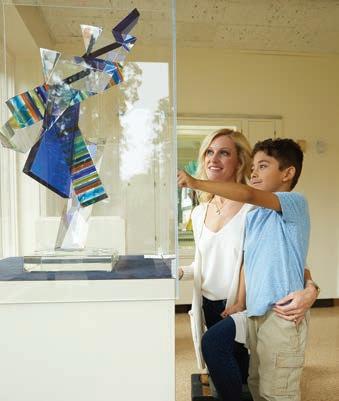
Sept. 24-25
No visit to Appleton would be complete without enjoying the much-anticipated Octoberfest. For 40 years, Appleton’s Octoberfest has been delighting visitors with music, food and activities that help usher in the fall season.
Grignon Mansion offers visitors a chance to tour the historic home and enjoy various exhibitions and activities, including the Native American Dance Performance on Sept. 18. In late October, the Fox Cities Performing Arts Center will be featuring “Wicked,” the “untold story of the Witches of Oz” — a favorite production among theater-goers.
When it’s time to relax and unwind, take in a Wisconsin Timber Rattlers baseball game. The Timber Rattlers play through mid-September and are a minor league affiliate team of the Milwaukee Brewers. Of course, no visit to the Fox Cities would be complete without enjoying many of its eateries, including Seth’s Coffee & Bake Shop, River Tyme Bistro and Houdini’s Escape Gastropub, to name a few.

times brewing. Keep the good
Originally built as a brewery in 1858, Stone Arch Brewpub has lasted the test of time to become the oldest, continually operating brewpub in Wisconsin. Join family and friends in the beer garden for handcrafted beer, award-winning fried cheese curds, and German-inspired pub food – it’s a true Wisconsin experience. Keep the good times brewing at this Fox Cities Original, and find your original.
For more Originals stories, visit FoxCities.org/originals

Mineral Point is the quintessential historic Wisconsin town, complete with a charming downtown district, where visitors can enjoy artist studios, specialty shops, antique stores and architecture that has been deemed reminiscent of a Cornish village.
Each October, Mineral Point is one of a few southwest Wisconsin communities that participate in the three-day, self-guided Fall Art Tour of the region’s many artist studios. Considered to be the town’s largest fall event, the Fall Art Tour provides visitors with opportunities to explore the creative genius of many local artists. Held Oct. 15-17, the tour includes Mineral Point, Spring Green, Dodgeville and Baraboo.
Sept. 11
Held the second weekend in September at Mineral Point’s Soldiers Memorial Park, this annual car show offers visitors a chance to get up close and personal with some amazing antique, vintage and custom cars.
The Mineral Point Farmers’ Market is a Saturday morning must-see, as this perfect little market has a big variety of seasonal produce, breakfast foods, baked goods, crafts and handmade soaps.
For those looking for a unique cultural experience during their visit, the Mineral Point Opera House simply won’t disappoint. This fall the opera house will feature live music, comedy shows, recent and retro movies, and the Driftless Film Festival in November. The Shake Rag Alley Center for the Arts is also hosting an outdoor Picnic and a Play series through the fall.
For outdoor biking enthusiasts, Mineral Point offers a wealth of fantastic road cycling, including challenging and scenic rolling hills on well-maintained country roads that are beautiful to ride as seasons change and leaves burst with vivid colors. Of course, the 47-mile Cheese Country Trail, which starts in Mineral Point, is a favorite trail for ATV aficionados, as it traverses historic communities that offer lodging, restaurants and shopping.
Wine lovers will also delight in Mineral Point’s American Wine Project winery, where you can order tastings and relax on the expansive porch or stroll through aweinspiring gardens.
You certainly won’t leave hungry when
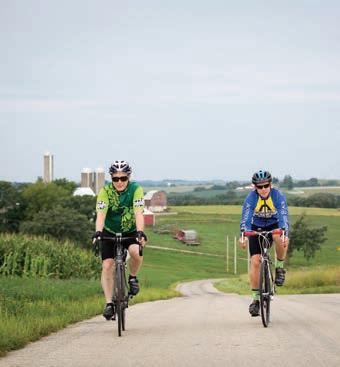
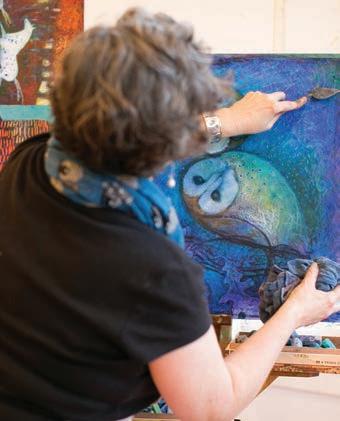
Sept. 24-26
Launched in 1991, the Annual Cornish Festival and Celtic Celebration focuses on strengthening Mineral Point’s ties to Cornwall. The festival features food, activities and entertainment celebrating “all things Cornwall.”
visiting Mineral Point. The town features wonderful dining options, including traditional breakfast options at Pointer Café. Or tempt your palate with unique Cornish delicacies at the Red Rooster. If wood-fired pizza is a favorite, check out Popolo Pizza, or enjoy classic pub food at Commerce Street Brewery.
Spending Halloween in Mineral Point won’t disappoint, as the town boasts a fun tradition with its Halloween parade. Children dress up in their costumes and walk from High Street to Shake Rag Alley — stopping, of course, for candy at High Street Sweets — with more trick-or-treating at historic sites around Shake Rag Alley.






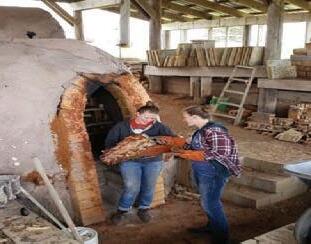



Dine and lodge safely in Mineral Point. Tour our historic architecture, enjoy our small shops, and experience all the outdoor activities of the Driftless area.


Known as the Swiss Cheese Capital of the U.S., Monroe is a charming town that truly delights at every turn. A key fall attraction is undoubtedly the outdoor farmers’ market. Running through the end of October, this produceronly market features more than two dozen vendors. Keep an eye out for pies made by local Amish vendors and Green County’s own trailer selling the best grilled cheese sandwiches and cheese puffs — plus, you’ll find producers selling kimchi, sauerkraut, pumpkins, squash, maple syrup and hot apple cider. On Sept. 25, the outdoor market will feature additional outside food vendors and live entertainment, as well
Sept. 17
Monroe wraps up their Concerts on the Square series with the final show on Sept. 17. Performances include local favorite The Jimmys, voted Best Local Blues Band and Best Local R&B Band. See complete details and full calendar at mainstreetmonroe.org.
as drop-in yoga classes that are open to all levels on the courthouse lawn.
Visitors to Monroe can also discover more than 150 barn quilts that have been installed on historic barns dotting the region and the back roads of Green County. Self-guided tours of these barn quilt displays (using a barn quilt locator map found in the Green County visitor guide), provides ample opportunity to celebrate the region’s farm life and fall harvest.
To sample favorite eateries in Monroe, check out the Baumgartner Cheese Store and Tavern, which features daily specials and rotating homemade soups — including the second-best chili (because no one’s is better than your mom’s). For donut-lovers, the Sunrise Donut Café recently opened in a charming 150-year-old historic building right on the downtown square. Also, no visit to Monroe would be complete without indulging in made-from-scratch pasties from Mad Charlie’s Café. The café strives to offer locally-sourced and organic food whenever possible.
This time of year, you can also enjoy Oktoberfest-style beers. Minhas Brewery features a beer garden, restaurant, winery and distillery. For wine lovers, check out Hawk’s Mill Winery, just 10 minutes from


Oct. 31
Each Halloween, Main Street Monroe becomes a Halloween adventure zone, complete with a Halloween parade and Truck-Or-Treat, where kids can safely enjoy trick-or-treating on the downtown square.
downtown Monroe. This establishment offers brick oven pizza, live music and sweeping views of the surrounding area that makes it a perfect afternoon escape. Of course, as the seasons change, gift and home goods stores really shine in Monroe. For example, 213 Mercantile makes and designs virtually everything they sell. And House to Home Designs is a true premier emporium, while Frame ’n Color offers a unique variety of gifts, especially for gifting to men.
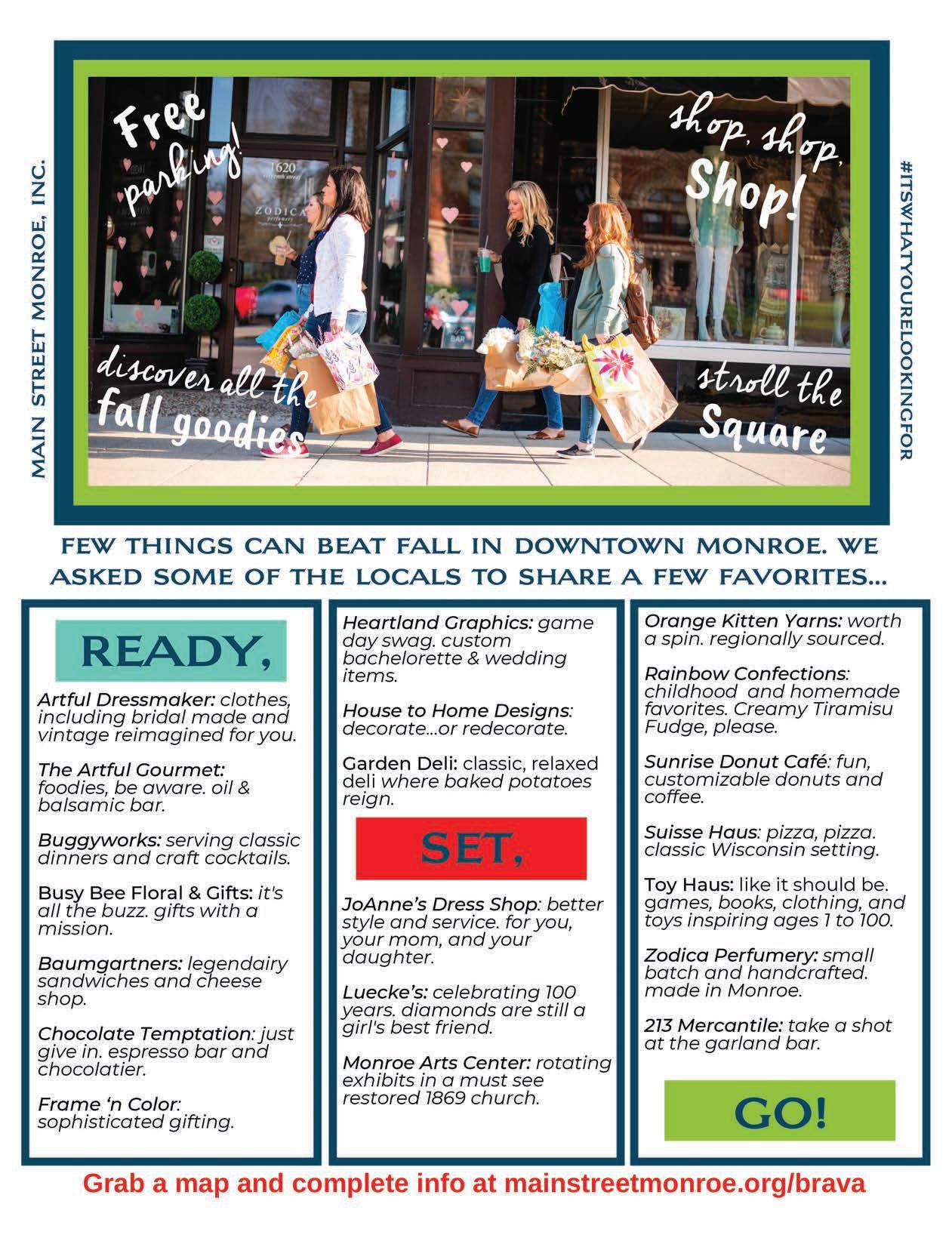
Just over the border from the Dairy State, Chicago’s North Shore offers an idyllic way to enjoy everything fall has to offer. For instance, the Chicago Botanic Garden in Glencoe is one of the world’s great living museums and conservation science centers. Every year, more than one million people visit its 27 gardens and four nature areas, situated on 385 acres on and around nine islands. Fall is the perfect time to experience the garden’s glorious fall setting. Each October the Botanic Garden features the Night of 1,000 Jack-o’-Lanterns, where more than 1,000 handcarved pumpkins light up the night.

For those who love to shop, Westfield Old Orchard is one of the Midwest’s most celebrated outdoor shopping centers, with over 140 specialty stores, beautiful gardens, landscaped walkways, sparkling fountains and children’s play areas.
Sept. 20-26
Considered to be one of the best fine craft shows in the U.S., the American Craft Expo at the Chicago Botanic Garden features more than 140 artists.

Begins Sept. 3
Fall simply wouldn’t be complete without taking in a football game at Northwestern University. After the game, enjoy a crisp fall walk along Lake Michigan or enjoy refreshments at one of the many great eateries in Evanston.




Chicago Botanic Garden
Experience the beauty of fall by day or on these magical nights.
Night of 1,000 Jack-o-Lanterns
OCTOBER 13–17 & 20–24, 2021
Lightscape
NOVEMBER 12, 2021–JANUARY 2, 2022
Illinois Holocaust Museum
Experience history in a way that movesand inspires you to take action.
Shanghai: Safe Haven
During the Holocaust THROUGH SEPTEMBER 5, 2022
Rise Up: Stonewall and the LGBTQ Rights Movement
OCTOBER 17, 2021–MAY 8, 2022
SEPTEMBER
OCTOBER 30 VS.
NOVEMBER 6 VS.
NOVEMBER 20 VS.
Fort Atkinson offers a number of wonderful fall experiences. First, check out Poyer’s Farm Market, a year-round market that offers fall must-haves like homemade pies (over 354,000 pies made since 1988), caramel apples, pumpkins, gourds, jams and jellies, honey, cheese and more.
Your list should also include The Fireside Theatre. One of the Midwest’s favorite entertainment destinations, the dinner theatre offers a taste of Broadway entertainment.

Animal lovers will get a kick out of Busy Barns Adventure Farm, featuring a pumpkin patch; sunflower fields (a totally Instagrammable spot); hayrides; fresh apple cider donuts; a corn maze; kid’s activities; and the chance to pet baby farm animals like calves, kittens, goats, bunnies and more.
And for the thrill-seeking adventurers, the best way to see the changing colors of the trees is with a skydiving jump at the Wisconsin Skydiving Center. Beginners can tandem jump with an instructor, and there’s also the option to capture a jump with a personalized video to remember the experience forever.
Oct. 30
Celebrate the fall harvest at the last market of the outdoor season! Kids can trick-or-treat at vendor booths while parents shop the last produce of the season. Those who come in costume will be entered for a prize drawing at the market information booth!







Spending time in La Crosse this fall is a surefire way to enjoy all the season has to offer. The area’s Grandad Bluff is not only a destination point for thousands, but also a symbol of the Coulee Region, named for its ridges and valleys. The 600-foot-high bluff overlooks the city of La Crosse and provides a view of the Mississippi River Valley and Wisconsin — in addition to views of Minnesota and Iowa.
For those seeking a fun challenge, the Hidden Trails Corn Maze — located in West Salem and just a short drive from La Crosse — also features wagon rides, farm animals and pick-your-own-pumpkin opportunities. Speaking of pumpkin patches, Rainbow Ridge Farms B&B and Pumpkin Patch, nestled in an Onalaska coulee, boasts a huge pumpkin patch and a small farm store.
Spending the weekend? Check out the Bentley-Wheeler Bed & Breakfast, an award-winning bed and breakfast that boasts the Queen Anne architecture style of the 1890s. Or if staying in an 1892 castle sounds delightful, consider Castle La Crosse, which also features a wonderful in-house morning breakfast made by the castle’s pastry chef.
Sept. 30-Oct. 2
Oktoberfest USA began in 1961 and fosters a spirit of gemütlichkeit (friendliness) among all Oktoberfesters by serving traditional German cuisine and brews, and offering numerous activities inspired or influenced by German culture.
And while the La Crosse area boasts many award-winning cafes and restaurants, fish aficionados will relish Red Pines. Voted the No. 1 fish fry in La Crosse County, Red Pines offers a beautiful, heated patio overlooking Lake Onalaska.


Sept. 16-19
Make La Crosse your home base and then head over the Mississippi River into Minnesota for Applefest USA in La Crescent. More than just apple-centric treats, the festival also boasts a car show, golf and corn hole tournament, and a parade.


Madison’s food landscape continues to get better with the addition of these new hotspots.
BY CANDICE WAGENER

As Madison continues to flourish as a destination city, restaurant owners are excelling at providing ample opportunities for experiences that are new and different, as well as familiar and traditional. The latest restaurants to open up around town are good for everything from date night, to entertaining out-of-town guests, to just grabbing a bite.
The much-anticipated Harvey House has finally opened. Midwest natives and owners Shaina Robbins Papach and Joe Papach bring legendary dining scene experience from places like Gramercy Tavern, Chez Panisse and The French Laundry.
Located behind Madison’s historic train depot on West Washington Avenue, the ambience harkens to bygone days of supper clubs and train travel, and not a single detail has been overlooked to create a unique fine dining experience.
Appetizers like a relish tray or chicken liver mousse are favorites to start. Next, feast on entrees like the duck, which has elements plucked from an Old Fashioned, including flavors
of orange, Door County cherries and a boozy cognac jus. And definitely save room for the grasshopper bar, with mint ice cream and chocolate cookie crunch dipped in a housemade, chocolate magic shell. This destination eatery could just be Madison’s newest special-occasion place. theharveyhouse.com
Housed in the former Forequarter space, Hone offers an inventive menu while still maintaining an atmosphere of a cozy, neighborhood tavern. Start out with the Filipino lumpia: deepfried spring rolls with novel fillings like corned beef or crab, avocado and chevre. Dinner options include the doner kebab, which is a specialty take on a Turkish classic. Hone’s version includes spiced beef, pickled vegetables, garlic aioli and spicy chili sambal sauce served up in a homemade lefse wrap. If you lean toward seafood, definitely order the shrimp mofongo, served on a bed of plantain mash, topped with crispy pork belly and a side of cucumber ceviche to brighten the dish. honeplated.com
Another welcome addition to Willy Street, Feast specializes in handmade, artisan dumplings, filled with chef-driven ingredients like black tiger shrimp, Berkshire pork, ribeye and locally-grown carrot and red onion. Dumplings are prepared steamed or pan fried.
While you’re munching on dumplings, level up your experience even more by partaking in the traditional Chinese tea service offered. Their tea menu is extensive, with different flavors of black, oolong, herbal and even an iced berry tea. feastmadison.com
Poke, a Hawaiian dish brimming with fresh vegetables and ocean goodies, is making its mark all over Madison (see: Miko Poke, Poke It Up, Poké Poké, FreshFin Poké and more). Now downtown Middleton has Poke Bar, which opened in May. Diners can build their own bowls, starting with a base of white, purple or brown rice or salad greens, then adding a protein like chicken, octopus or tofu. There’s a whole list of sauces, fresh produce and fun toppings like flying fish roe or kimchi to mix in and make your bowl original.
Too many choices? Order a signature bowl. The Seafood Mix lives up to its name with Ahi tuna, salmon, octopus and shrimp accompanied by a seaweed salad, cucumber, crispy onion, scallions, masago, nori flakes and pickled ginger on a bed of white rice. pokemiddleton.com
Owner Kaylee Walters is a huge proponent of using local and seasonal ingredients wherever possible, sourcing from purveyors like Parrfection Produce (just down the road

David Rodriguez, who has gained notoriety for his Melted food truck, opened up shop on Willy Street where taco lovers can find their happy place all day long. Arrive before noon and you can indulge in a variety of breakfast fare, from tacos to tortas to burritos, loaded up with folded eggs, queso and fresh pico de gallo. Meat lovers can add house-smoked bacon or homemade chorizo sausage. Come later in the day and you’ll have even more tacos to choose from, like BBQ brisket, al pastor and jerk sweet potato, to name a few. tacolocal.com

in Monticello), Valhalla Hills Farm, Tortilleria Zeped, and Meadowlark Community Mill.
Rotating entrees like the Thai green curry uses local zucchini, Wisconsin mushrooms, non-GMO tofu and onion served with organic brown rice. Even the beverages have local flair, with their own specialty blend of Just Coffee and tea from Telsaan in Mount Horeb. Latte lovers will revel in the variety of flavors, like rose cardamom.
Plan for a Friday or Saturday date night when their featured cocktail menu is available. Find standbys like an Old Fashioned, but also creative offerings like the Hodag, with Stateline Distillery coffee liqueur and vodka topped with oat milk. Even better, share an ice cream and coffee flight for the ultimate indulgence. thehousecafeandbakery.com
Candice Wagener is a freelance writer who enjoys telling stories that inform, intrigue and inspire.






















Neighborhood taprooms once graced nearly every main street from here to Bayfield, and more than 300 breweries operated in Wisconsin by the 1890s. Large-scale beer production erased many of these cozy spaces to talk, laugh and share.
The resurgence of craft brewing has made stopping by your friendly neighborhood taproom a reality again — and lucky for us, Madison has had more taprooms crop up in the last few years. Here are some you may not have been to yet, or that have exciting new offerings.
Co-owners C.J. Hall and Nate Kinderman literally went the full mile to create this restaurant and brewery in the heart of Sun Prairie. The two met in seventh grade and after successful careers spanning marketing, home-brewing and management at Gates & Brovi and Sardine, they decided to create something of their own.

Full Mile opened in December 2018, and offers a full menu including freshly-baked pizzas from their wood-fired Mugnaini pizza oven. And, each beer pairs well with their food offerings. Try a Festbier (a strong, golden German lager), dance polka and enjoy German-style pretzels at their Oktoberfest celebration on Sept. 18. fullmilebeercompany.com
There’s nothing like sipping on an artfully-crafted, locally-brewed cold one with friends.
BY HANNAH WENTE
Delta co-owners Michelle “Speedy” Riehn and brewer Tim “Pio” Piotrowski met at UW-Stevens Point. Together, they create community change at their south side taproom by paying their employees a living wage and donating all tips to local nonprofits. They’ve supported over 20 nonprofits since opening in February 2019.
Speedy recognizes the importance of having somewhere to go on holidays, so the brewery remains open every day of the year. Stop in for a coffeeinfused golden ale (perfect for fall) or a light, crisp, seasonal-fruited gose — each served in a beaker. Non-beer drinkers can sip on a house-made, craft soda. delta.beer
Owner Garth Beyer is a former beer beat writer and helped introduce countless breweries to Madisonians. Beyer loves the way beer crosses social and economic sectors, and wanted to be a part of the scene. So, he opened Garth’s Brew Bar on Monroe Street in December 2019.




Throughout the pandemic, he has supported Wisconsin breweries and offered customers rare beers including a coffee saison. Although brewing doesn’t take place on-site, look for collaboration brews between Garth and G5 Brewing Company of Beloit. Stop by for weekly trivia, bingo or book a private party in the taproom. garthsbrewbar.com
Tucked away off of County Road PB behind the Paoli Mill is the Hop Garden. Enjoy fresh craft beers and live music featuring regional bands at this indoor-outdoor venue. And Hop Garden’s beers are truly homegrown: Owners Rich and Michele Joseph grow and harvest several varieties of hops on their 20-acre Belleville farm to use in their own beers — hence the tagline “We Grow Beer.” Farmtastic, a pub-style pale ale, is the most popular tap. Stop by on a Sunday after strolling through the Paoli farmers’ market and grab farm-to-table fare from Molino Taqueria next door. thehopgarden.net

Sour fans flock to this East Washington Avenue taproom that opened in April 2019. O’so’s flagship brewery in Plover — just south of Stevens Point — opened in 2007 and has been making sours longer than many area breweries. O’so is a play on beer descriptions: “O so good, O so sour, O so hoppy,” says Sales Manager Kurt Woodruff.
Grab an Infectious Groove kettle-style sour and head to the patio with your pup. Or grab a friend and hit the pinball machines inside. Munch on pizza and cheesy garlic bread from Stevens Point. osobrewing.com
Sara Hoechst and husband Phil enjoyed the spoils of the craft beer movement while living in Colorado. When they returned to Madison, they added “opening a brewery” to their five-year plan. Just two and a half years later, they opened Hop Haus in Verona. Their second location off of the bike path in Fitchburg opened in September 2020. Take a tour of the Fitchburg brewery on Fridays at 4 p.m., then head to the rooftop patio for sunset. Select your favorite from a well-rounded tap list that includes Plaid Panther Scotch Ale and Yard Work IPA. hophausbrewing.com

Step off of the Capitol Square into this hip jungle locale. Tom Dufek, Billy DuPlanty and brewer Kyle Gregorash (formerly of Door County Brewing) opened Young Blood in June 2020. A rotating tap list ensures there’s something interesting and new for everyone in your group — in 13 months they’ve sold about 170 different beers. Names like The Brothers McMuffin, a fruit punchstyle sour, sometimes originate from

staff jokes. The full kitchen offers homemade Taco Bell crunch wraps and stackable Jenga tots. youngbloodbeerco.com

Octopi has become a mecca for hop-forward beers and beverage brands like Untitled Art. Their new expansion, set to be completed in early 2022, will allow them to support even more small breweries and beverage companies. In addition to offering brewing and bottling services for local and national brands, their Waunakee taproom features a walleye and cod fish fry, taco Thursdays and pork belly burnt ends. “If you’re an adventurous drinker, you’ll love it here,” says Project Manager Lineve Redlin.
Try the monthly collaboration series from Untitled Art and brewers from around the country and the world, like the 7% ABV strawberry shortcake imperial seltzer made by Pulpit Rock Brewing of Iowa. The best part? Three of Octopi’s brewers are women. drinkoctopi.com
Hannah Wente is a freelance writer who builds community through her freelance writing and nonprofit work.


SEPT. 12-18: During Madison Bike Week, bike between Hop Haus and Delta Beer Lab. Choose your starting or “home” brewery, grab a beer and your start time will be marked. Bike to the other brewery and get a beer, return to your home brewery and your finish time will be marked. The team with the fastest average wins bragging rights and a plaque that hangs in their home brewery. madisonbikes.org
SEPT. 18: Full Mile Beer Company & Kitchen Oktoberfest, facebook.com/fullmilebeerco
SEPT. 30: Craft night at Garth’s Brew Bar, garthsbrewbar.com
OCT. 16: Hop Haus Beer Run, a 5K run/walk and (for those 21+) a one-mile beer run, hophausbeerrun.com




By Melanie Radzicki McManus
Twenty-two islands clustered atop the Bayfield peninsula comprise the Apostle Islands archipelago, one of Wisconsin’s most popular destinations. It’s easy to see the appeal. The islands dot the southern shore of Lake Superior, the largest of the Great Lakes, and arguably the most impressive. Even more noteworthy: 21 of the 22 islands — along with a 12-mile stretch of pristine shoreline — form the Apostle Islands National Lakeshore, one of just four National Lakeshores in the U.S.
Both the shoreline and islands are famed for their colorful, sandstone cliffs, plus the sea caves carved into their bases. Add to that the area’s unspoiled sandscapes, wealth of wildlife, historic lighthouses and outdoor recreational opportunities galore, and it’s no wonder some 200,000 people flock here every year.
While most visitors make the trek during the warmer months, the off season brings fewer crowds, a slower pace and some unique experiences that can only be had when the temperatures plunge. Though it is a bit of a drive from Madison (about 300-plus miles), it’s so worth it.
The peninsula bursts into a blaze of fiery colors come autumn, and the crowds thin, making it easier to explore popular spots like the rugged Apostle Islands sea caves. Sign up for a guided tour via kayak with a local outfitter such as Trek & Trail, and soon you’ll be gliding through cavernous openings and narrow tunnels alike. Trips run from half-day to multi-day, and may incorporate stops at historic lighthouses, past shipwrecks and more.
If paddling’s not your thing, book a tour with Apostle Islands
Cruises. The company offers a variety of trips. Their newest boat, the Archipelago, lets you view the gorgeous sea caves throughout the park, allowing for stellar photo opportunities. In nonpandemic years, the cruise line also shuttles visitors to some of the Apostle Islands’ historic lighthouses, where you can dock and take a ranger-led tour. Although the lighthouses remain closed for the 2021 season, you can still get your lighthouse fix by visiting during the Apostle Islands Lighthouse Celebration (Sept. 7-18, 2021), which spotlights the National Lakeshore’s wealth of lighthouses, considered the nation’s


largest and most complete collection. During the fête, a nonstop cruise will take you past five of the eight lighthouses. Landlubbers may prefer the Gil Larsen Nature Trail/Iron Bridge Nature Trail in Bayfield. Less than a mile long, the flat path follows a stream flowing under an old iron bridge, ending at a scenic overlook.
Also not to be missed: A trip to Madeline Island, the largest of the Apostles. Ferry over to the island — the sole island in the archipelago that’s not part of the National Lakeshore — and explore its boutiques; art galleries; and the Madeline Island Museum, which explores the area’s native Ojibwe history and European settlement. Bonus: The island is open year-round! Outdoors enthusiasts should check out Big Bay State Park, featuring more than seven miles of hiking trails, while duffers should head for the Madeline Island Golf Club,
which boasts one of the few Midwestern courses designed by legendary golf course architect Robert Trent Jones, Sr. Before you leave, have a drink at Tom’s Burned Down Café. The bar/ café, which features live music and an art gallery, partially burned in the 1990s. Today, its remains have been reimagined into a multi-tiered, mostly al fresco joint whose walls and spaces are filled with philosophical and humorous quotes and sayings.
Winding down the fall tourist season is the Bayfield Apple Festival, taking place Oct. 1-3 this year. The blowout fall fest celebrates the area’s agricultural heritage, including the peninsula’s microclimate that makes it perfect for growing fruits and berries throughout the year.
One of the Apostle Islands’ biggest claims to fame are the glittering ice caves (the same ones you kayak through in the fall) that transform every winter, namely those in the mainland sea caves near Meyers Beach. Hiking out onto the frozen water and into the sparkling caves

is a bucket-list experience for many. The ice caves aren’t always accessible, though, as Lake Superior’s strong winds and wave action often result in thin ice or open water on the pathway to the caves. If that’s the case when you visit, all is not lost.
Instead of heading to Meyers Beach, book a guided trip to the Houghton Point ice caves with Bayfield Kayak. Starting around late January, the ice caves at Houghton Point in Chequamegon Bay are almost always safely accessible, as the bay is more protected from the elements. Another option: Exploring the ice caves that form along the shore in Red Cliff, home of the tribal Red Cliff Band of the Lake Superior Chippewa. Local company Rustic Makwa Den offers tours twice daily.
Don’t overlook peering at the caves from on high, says David Eades, the former executive director of the Bayfield Chamber & Visitor Bureau, as you can snowshoe or hike atop the Meyers Beach ice caves Bayfield Ice Caves

Owners: save up to $75 from Owner Rewards sales on local products in September!
See the sales flyer in the store or at willystreet.coop/owner-rewards. PLUS every day in September, Load Up On Local and take 10% off all local products in your cart — including sale items! — when you buy at least $50 worth of local products.


Not a member? Not a problem!
Become one today for $10 and start getting the benefits of Co op Ownership.
WILLY EAST: 1221 Williamson St., Madison, WI
WILLY WEST: 6825 University Ave., Middleton, WI
WILLY NORTH: 2817 N Sherman Ave., Madison, WI









via the 4.5-mile Lakeshore Trail. “We send everyone there in winter,” says Eades.
Of course, there’s a lot more to the Apostle Islands in winter than the ice caves. Nearby Mount Ashwabay features roughly 25 miles of cross-country ski trails, an alpine skiing and snowboarding hill with a 1,500-foot run, snowshoeing and skijoring trails, tubing and fat-tire biking. You can also snowshoe or hike in any number of scenic local spots such as Frog Bay, the nation’s first tribal national park. This impressive parcel of land includes rare boreal forest, coastal wetlands and an undeveloped sand beach, from which you can spot five Apostle Islands at once — a rarity.
No winter trip to the Apostles is complete without a stop at Wolfsong Adventures in





Mushing, one of Wisconsin’s few dog-sledding businesses. The experience starts by meeting the dogs and loving them up, says owner Jen Dale, then learning to harness them and drive a sled — because it’s the customers who do the mushing.
“Everyone has a blast once they learn to drive a sled,” she says. And when your ride is over, dog kisses are a must — and a great way to conclude your visit.
Melanie Radzicki McManus is a freelance writer from Sun Prairie, and specializes in
Join Summit Credit Union & NAMI Dane County for this dynamic discussion about what it means to be financially well. Explore the ties between mental and financial health, and learn how to enhance your overall wellness.







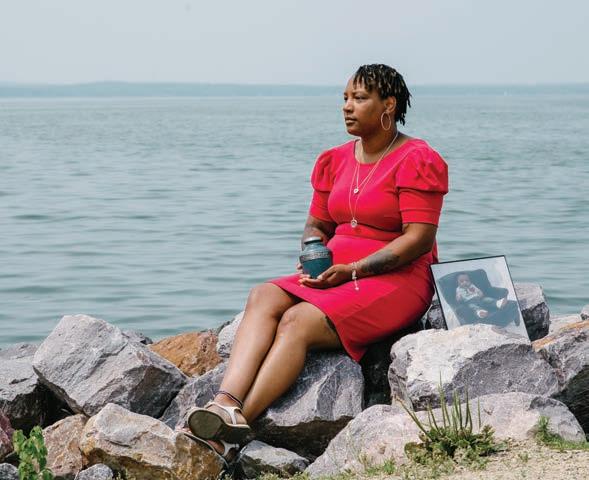
EXTRA, EXTRA | In every issue we select “the best of the best” images to go in our features and departments. Here are some additional shots to enjoy.
Top: The death of Felica Walton-Turner’s infant son Zaire spurred her to start her own nonprofit, Healing Our Hearts. The organization connects grieving parents and offers grief training resources for medical providers and employers, as well as support groups for parents. healingourhearts.net
Right: The much-anticipated Harvey House, located in the historic train depot on West Washington Avenue, has finally opened. Midwest natives and owners Shaina Robbins Papach and Joe Papach offer supper clubinspired dishes — such as chicken liver mousse, walleye (shown), duck — and classic cocktails.
Middle: Styling clothing always takes a bit of extra care to make sure each piece photographs correctly. Here, editorial intern Mason Braasch and assistant editorial director Shelby Rowe Moyer work in photographer Hillary Schave’s studio.
Bottom: David Rodriguez, who owns the popular Melted food truck, opened up Taco Local on Williamson Street where taco lovers can find their happy place. The exuberant fish scale tile, industrial touches and warm wood accents make this a stylish spot to nosh.

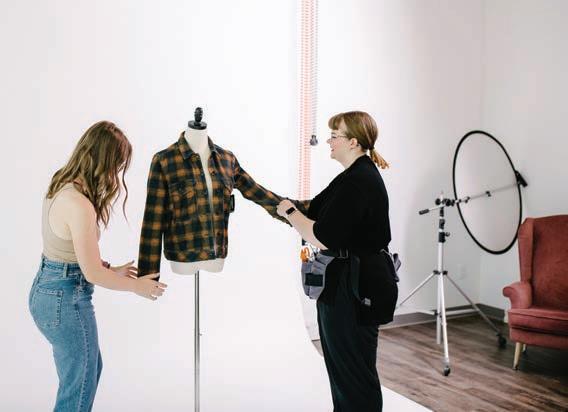


Because there's no greater luxury than your time, Lincoln provides you with the e ortless way to service your vehicle. Just schedule a time and place convenient to you, and we’ll bring you a loaner vehicle when we pick up yours.